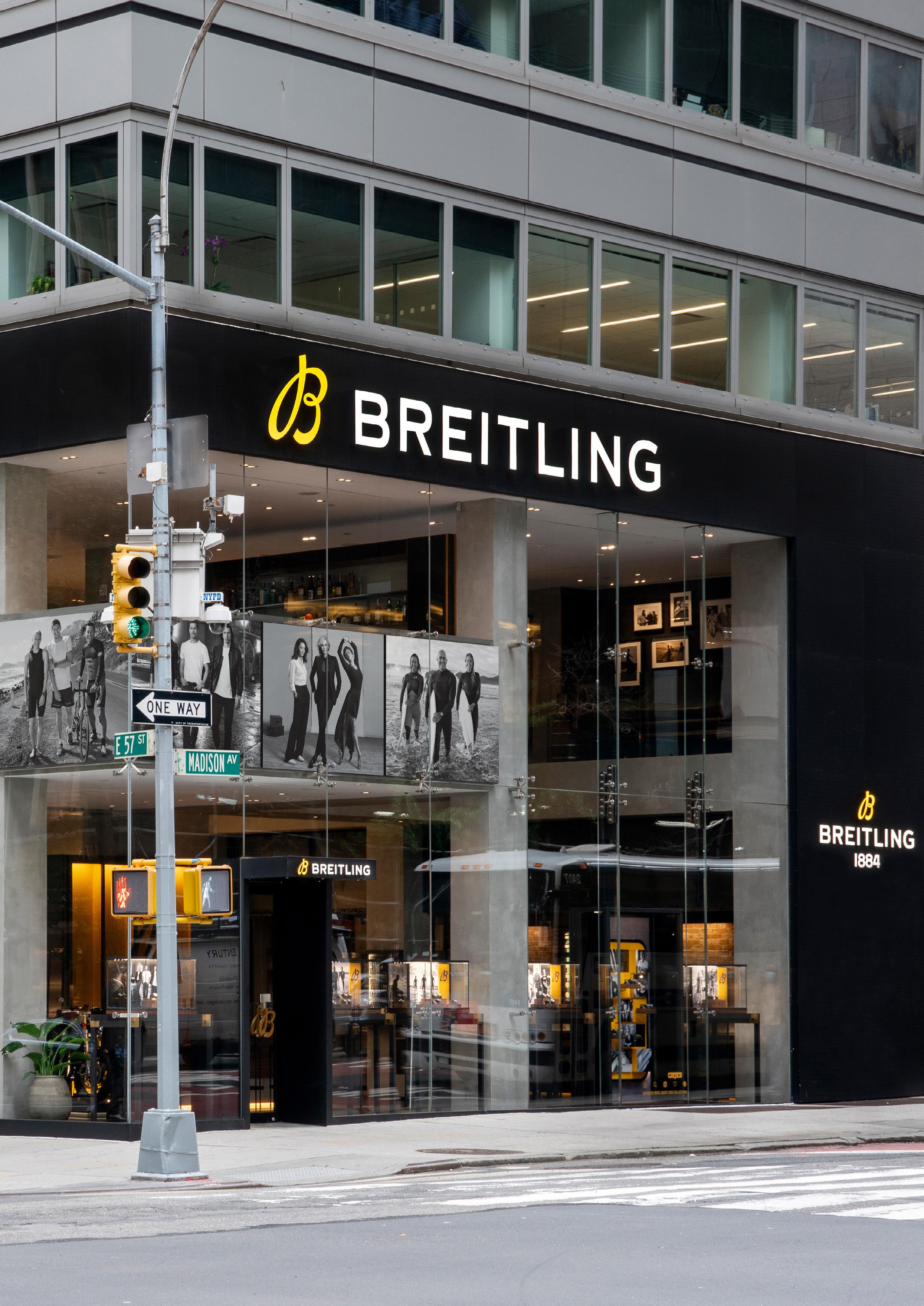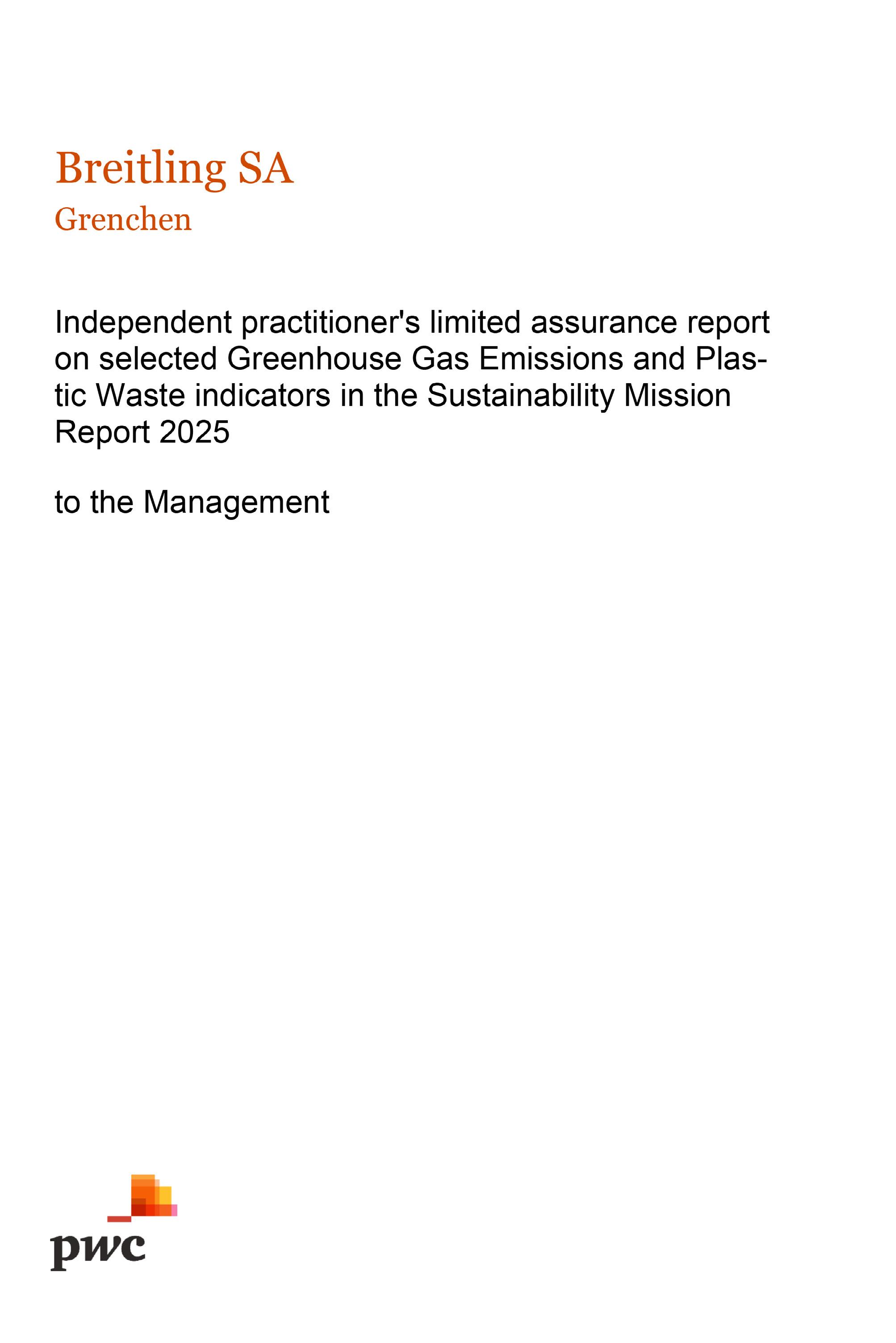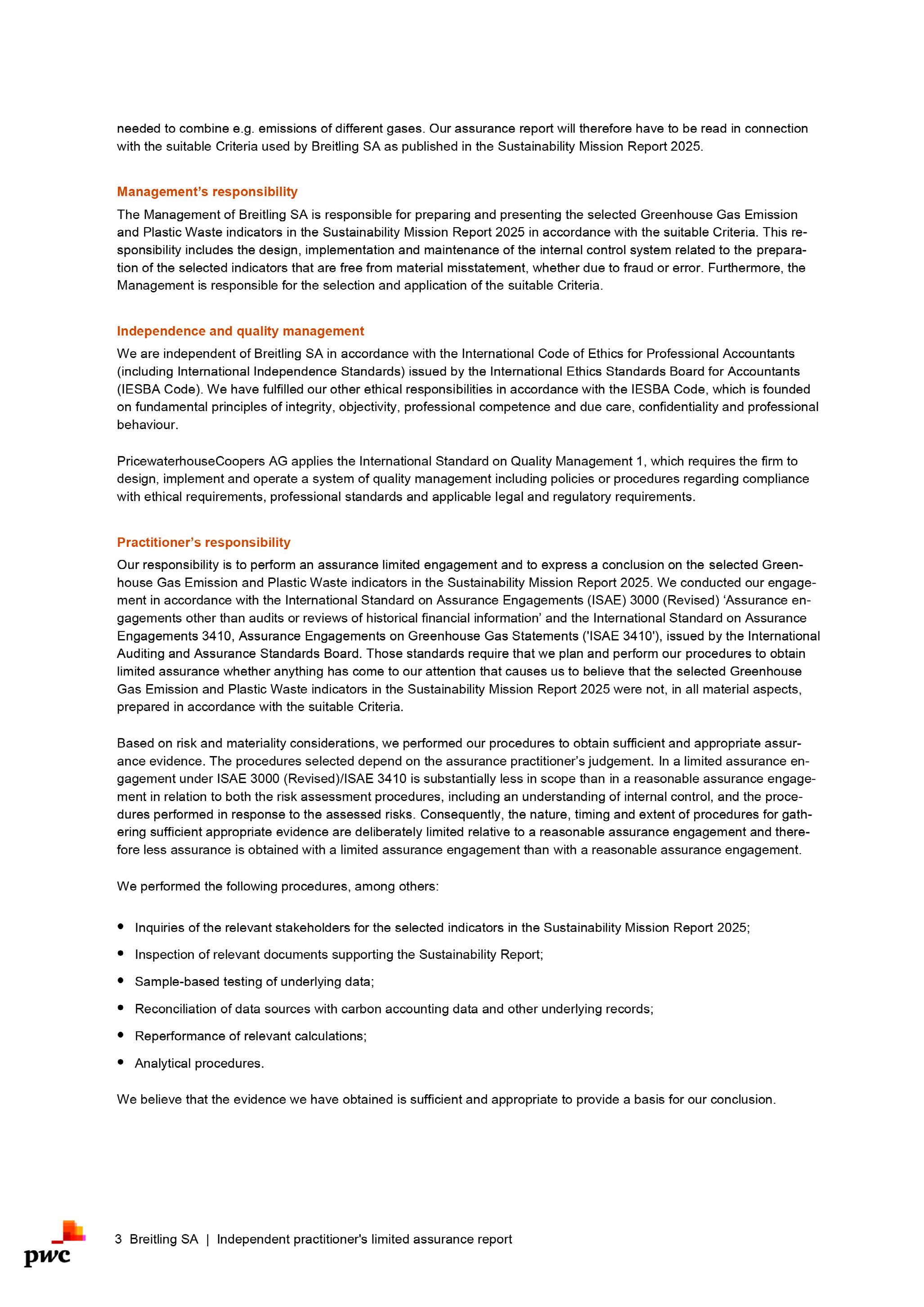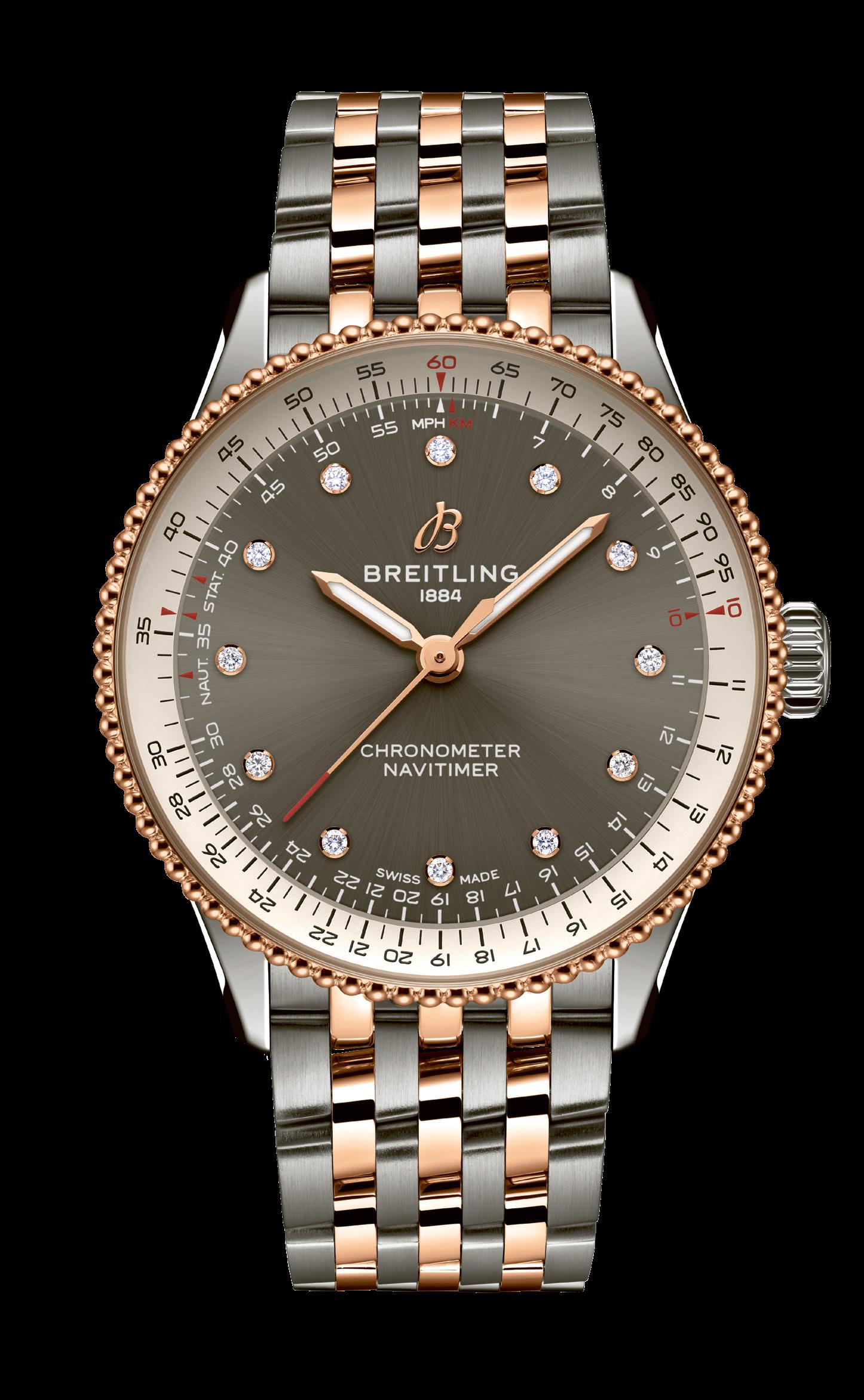




At Breitling, we are committed to adopting the most forward-thinking approaches for sustainability. Among these is our approach to reporting, which is an important aspect of our commitment to providing meaningful transparency. Since 2024, we have chosen to proactively prepare our report in reference to the European Union Corporate Sustainability Reporting Directive’s European Sustainability Reporting Standards (ESRS) 1: General Requirements, released on 31 July 2023 by the European Financial Reporting Advisory Group (EFRAG).
The adoption of the ESRS structure has greatly strengthened our management processes for sustainability. We feel this structure brings great value by providing a clear and thorough basis upon which to assess the impacts upon our business and upon society.
Where relevant, we furthermore integrate the guidance of and align our efforts to the United Nations Sustainable Development Goals (SDGs), the Task Force on Climate-related Financial Disclosures (TCFD), the Taskforce on Nature-related Financial Disclosures (TNFD), the International Sustainability Standards Board (ISSB) SASB Standards, the Global Reporting Initiative (GRI), the Greenhouse Gas (GHG) Protocol standards, and the World Economic Forum / International Business Council Stakeholder Capitalism Metrics. Full details of application are available where relevant throughout the report, and within the index of this report.
Unless otherwise stated, the boundary of the Sustainability Report is Breitling SA. Financial statements are however consolidated and include reviews of Breitling Holdings and Breitling SA.
The time frame the report assesses covers April 1, 2024, to March 31, 2025, as the fiscal year of the Breitling Group. Comparative data from prior reporting cycles is provided where available. To provide current data going forward, Breitling intends to continue to issue a sustainability report on an annual basis.
PricewaterhouseCoopers AG has audited selected greenhouse gas emissions, and plastic waste indicators. In case of any data errata, Breitling will reissue the corresponding report if the total figures are impacted by more than 5%. In case of metric value reassignments or updates to the underlying data based on new information, no report reissue will be made but will be duly disclosed in the course of the subsequent reporting cycle.
This report was created by the Breitling sustainability department in collaboration with key internal contributors. It is complemented with the powerful stories of our community globally. It is made available in English.


After-sales service/Service après-vente (SAV)
Artisanal and small-scale gold mining (ASGM), also referred to as ASM gold
Carbon Disclosure Project (CDP)
Code of Conduct (CoC)
Corporate Sustainability Reporting Directive (CSRD)
Counter-proposal to the Responsible Business Initiative (RBI)
Double Materiality Assessment (DMA)
Earth system boundaries (ESBs)
Energy Attribute Certificate (EAC)
Environmental, social, governance (ESG)
European Financial Reporting Advisory Group (EFRAG)
European Sustainability Reporting Standards (ESRS)
Global Reporting Initiative (GRI)
Greenhouse Gas (GHG)
Health, safety and environment (HSE)
Human rights due diligence (HRDD)
International Labour Organization (ILO)
Impacts, Risks and Opportunities (IROs)
International Sustainability Standards Board (ISSB)
Locate, evaluate, assess and prepare (LEAP)
Organisation for Economic Co-operation and Development (OECD)
Renewable Energy Certificate (REC)
Science Based Targets initiative (SBTi)
Sustainable aviation fuel (SAF)
Swiss Better Gold (SBG)
Task Force on Climate-related Financial Disclosures (TCFD)
Taskforce on Nature-related Financial Disclosures (TNFD)
Tons of carbon dioxide equivalent (tCO2e)
United Nations Sustainable Development Goals (SDGs)
Wastewater treatment plant (WWTP)


Taking a break from cleaning the riverside of waste in Zürich, Switzerland



EcoVadis platinum medal –awarded to the top 1% of all companies assessed globally
Of Breitling‘s Better Gold and Better Diamond Fund educational programs
OVER
115,000
Watches serviced globally to extend their lifetime
Of the steel sourced for our watches is from reprocessed or recycled content
100%
Energy for electricity across our headquarters and all our subsidiaries globally
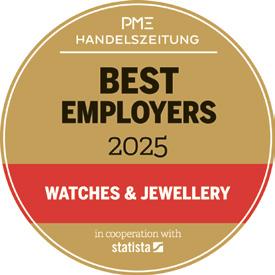
Top employer and Best employer in watches and jewellery in Switzerland OVER 70%

A- score for climate awarded by the Carbon Disclosure Project (CDP)
One-half of all watches with gold and/or diamonds contain the Origins Label, up from one-third last year
12.7%
EMPLOYEES INVESTED
In the company as shareholders

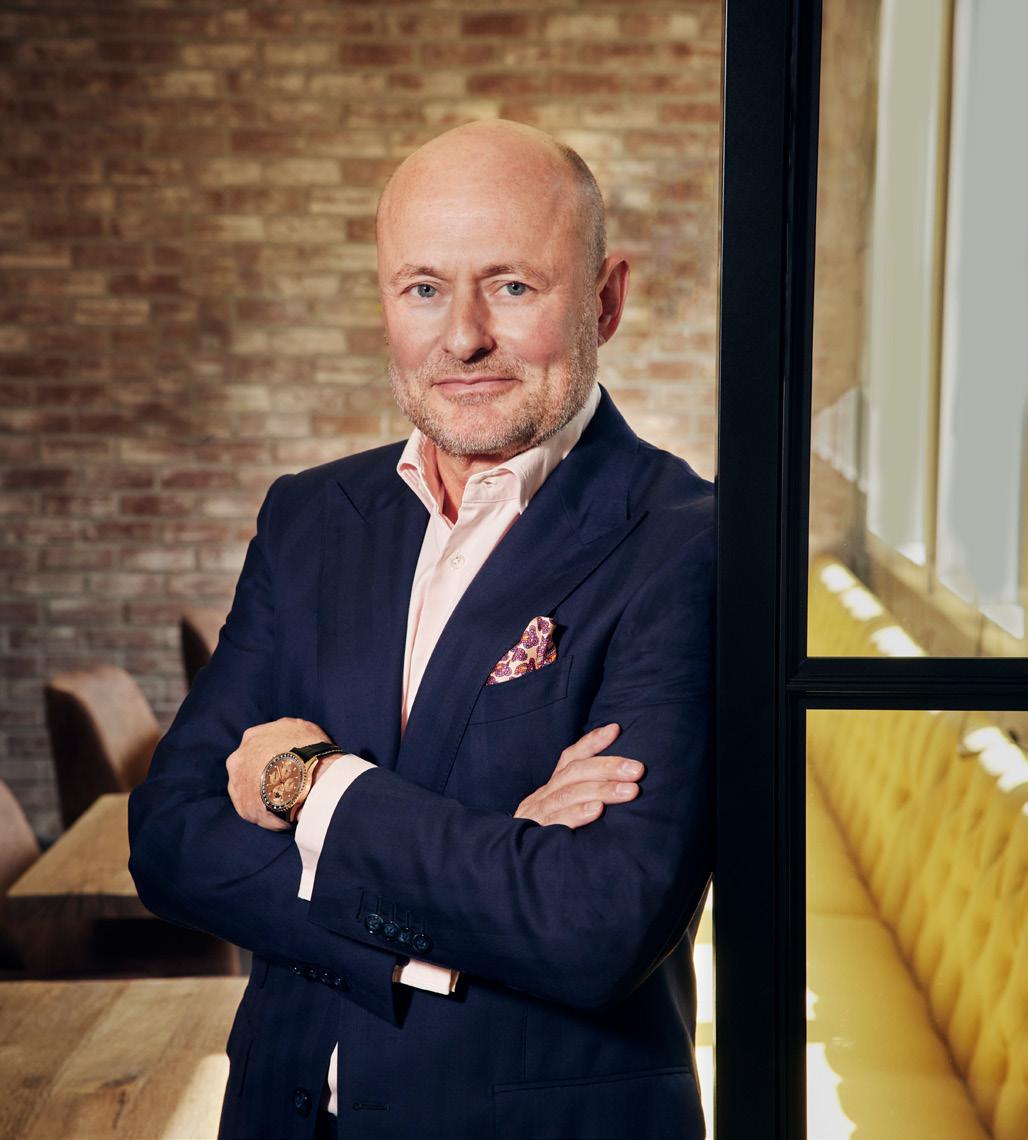
At Breitling, we create luxury that is approachable, casual and sustainable. We bring to life the neo-luxury paradigm and offer a compelling value proposition to our customers, our employees, our suppliers, our communities and our partners. Together, we are a Squad on a mission to do better.
Our shared efforts have been recognized with key awards such as Best Sustainable Watch for the Super Chronomat 38 Origins with traceable artisanal and small-scale gold and lab-grown diamonds and issued with an enhanced traceability disclosure on our blockchain, or Best Employer in Switzerland. In the last year, we also received the platinum medal from EcoVadis, awarded to the top 1% of all companies assessed globally, for our full-scope performance on sustainability topics related to labor & human rights, environment, ethics, and sustainable procurement.
We are deeply proud to include in this year´s report the personal stories of the people who are tangibly bringing these achievements to life. From a student in
Colombia who graduated from our Better Gold Fund education program to a professional basketball star using his platform for meaningful impact, to a watchmaker that ensures a longer life for thousands of our products each year, their actions are key to achieving our shared missions for sustainability. Keep an eye out for their stories within the report, alongside our annual full-scope disclosures.
We are especially proud to see our collaboration with communities in our Better Diamond supply chain come to life – and to share these inspiring stories in the present report. Since last year, 45 local social impact leaders have benefited from the tailored educational program provided through our Better Diamond Fund, helping to amplify their extraordinary work in areas such as children’s education, women’s economic empowerment, environmental stewardship, and beyond.
Our people – our Squad, in Breitling parlance – are clearly on a mission to do better. We chronicle these extraordinary efforts in our annual Sustainability Mission Report, which is published fully in-house. Already since 2024, it follows the European Sustainability Reporting Standards, making Breitling the first in the industry to adopt this landmark guideline.
I could not be prouder of the achievements we have realized together, or more eager for all that is to come. Meanwhile, enjoy the read and the inspiring stories we have the chance to share from our Squad around the world.
GEORGES KERN, CEO

Founded in 1884, Breitling is a leading Swiss watchmaker. The innovative company invented the modern chronograph and pioneered the navigational tool watch. Today, it is still breaking new ground as a casual, approachable, and sustainable luxury brand that reflects the real aspirations of today‘s consumers. The brand remains one of only a handful of independent watchmakers to produce its own manufacture calibers. Breitling is at the forefront of technology and was the first company to offer its customers a blockchain-supported certificate of ownership already in 2020.


Is to inspire the dream of a casual, uplifting and meaningful life through sustainable products and a tasteful yet approachable luxury style.
To be a top 5 Swiss watch brand and the undisputed leader of neo-luxury – a relaxed and responsible interpretation of luxury.
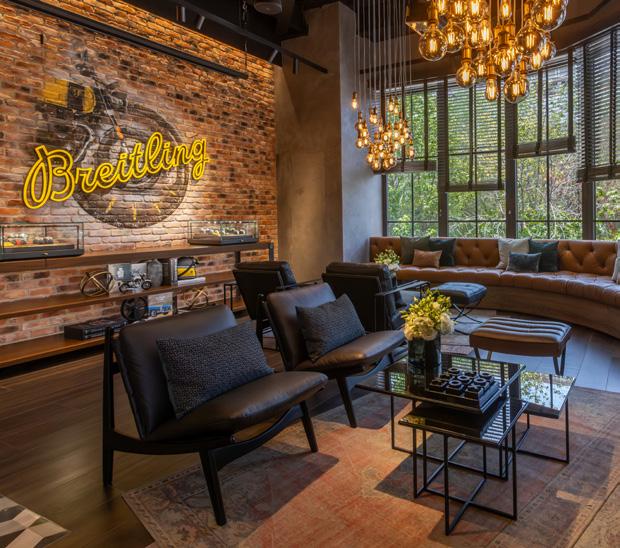

Today, Breitling is on a mission to do better, by creating beautiful products with better materials, better manufacturing, better packaging, and end-to-end traceability. Combining classic watchmaking with the latest and most sustainable innovations, Breitling is both a company with history and one that is ahead of its time.

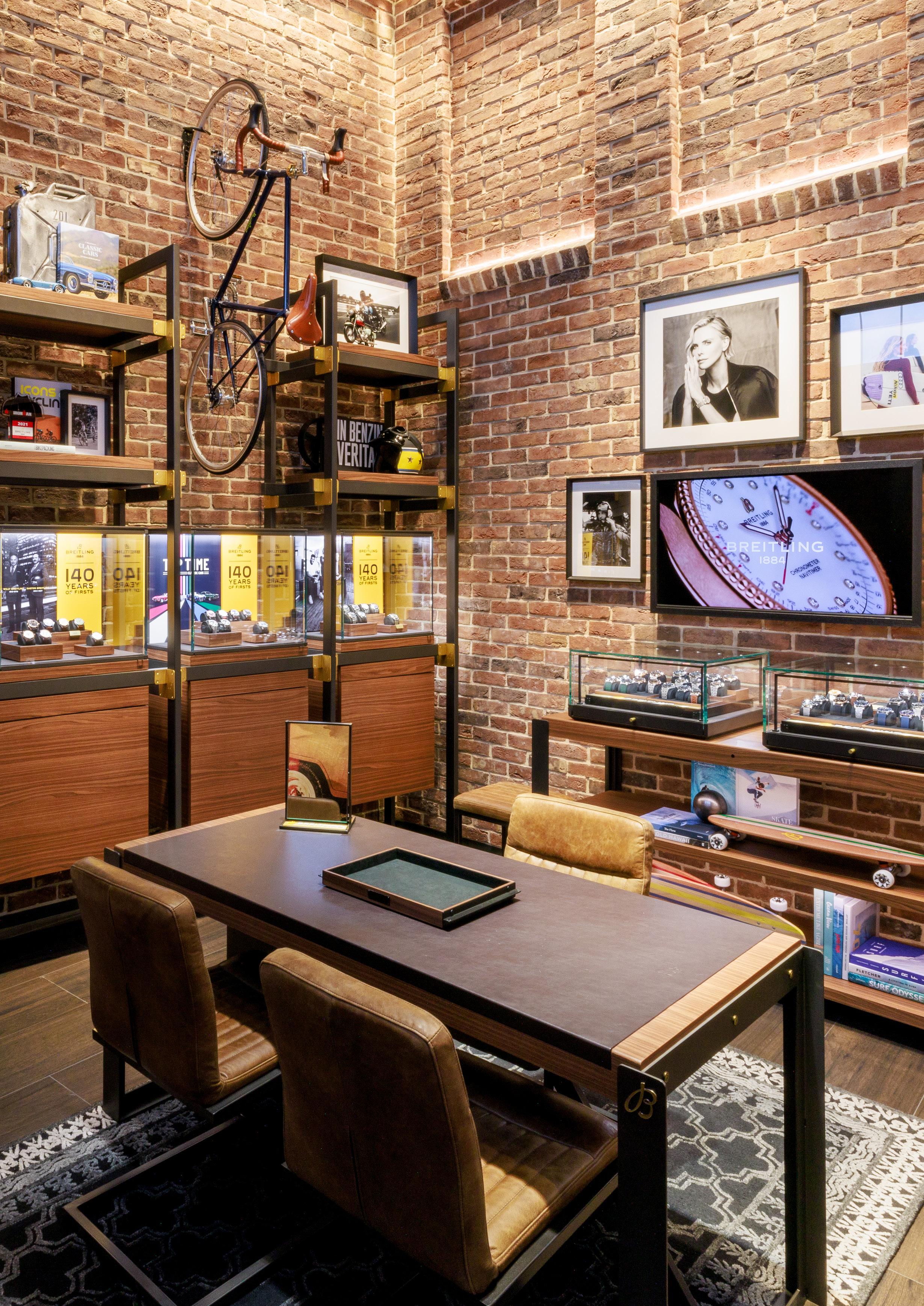
We take action with communities globally to build shared resilience and prosperity across our value chain and support transformative processes from supply chain communities to customers and beyond.
We support resilient ecosystems by contributing to climate risk mitigation, nature regeneration and plastic waste reduction to protect our business outlook and advance global best practice.
EUROPEAN SUSTAINABILITY REPORT STANDARDS MATERIAL TOPICS
S1 Own workforce: Working conditions; Equal treatment and opportunities for all
S2 Workers in the value chain: Working conditions and other work-related rights
S3 Community rights; Rights of Indigenous Peoples
S4 Information-related impacts for consumers and/or end users
E1 Climate change mitigation; Climate change adaptation
E3 Water
E4 Direct impact drivers of biodiversity loss
E5 Resource inflows, including resource use; Resource outflows related to products and services
4: Quality education
5: Gender equality
8: Decent work and economic growth
9: Industry, innovation and infrastructure
17: Partnerships for the goals
6: Clean water and sanitation
12: Responsible production and consumption
13: Climate action
14: Life below water
15: Life on land
We uphold the highest ethical standards with transparent, accountable practices, setting forward-looking standards that reflect our values and ensure full compliance.
G1 Corporate culture
G1 Protection of whistleblowers
G1 Animal welfare
16: Peace, justice and strong institutions
17: Partnerships for the goals

SHAREHOLDERS AND GENERAL MEETINGS
BOARD OF DIRECTORS
CHIEF EXECUTIVE OFFICER
The ESG committee helps shape the Group‘s sustainability strategy, monitors related issues, and reviews executive reports on ESG risks, impacts, and opportunities. The chairperson regularly updates the board on key findings and actions.
Executive management members across Breitling contribute to full-scope sustainability efforts across the product, commercial, marketing, operations, finance, digital & technology, people, and administration functions.
CHIEF ADMINISTRATIVE OFFICER
CHIEF SUSTAINABILITY OFFICER AND SUSTAINABILITY DEPARTMENT
Internal Breitling subject matter experts, external experts, suppliers, standard and criteria setters, verification providers, and further affected groups contribute to the development and implementation of our sustainability objectives.

Breitling Chronometrie energy consumption reduced by 50% between 2013-2018
Breitling commences its partnership with Ocean Conservancy, which continues for five years to February 2023, supporting their mission to create science-based solutions for a healthy ocean
Mission with Healthy Seas to remove ghost fishing nets in Croatia
SETTING THE GROUNDWORK FOR SUSTAINABILITY >>>
Installation of solar photovoltaic panels at the Breitling warehouse in Grenchen, which produce about 600 MWh of electricity annually that is fed into the grid (2014)
Building upon its longstanding support of the pioneering missions of Swiss explorer Bertrand Piccard, Breitling and Solar Impulse commence a partnership that continues still today to identify and promote clean and profitable solutions for the environment
Breitling commences its partnership with Qhubeka to help people earn and receive bicycles, including through its sponsorship of the Double Century bike race in South Africa, with the core partnership continuing through November 2022
Sale of Breitling to CVC Capital Partners, a firm focused on creating sustainable value (2017)
Launch of the Breitling Squad on a Mission campaign and neo-luxury concept

Breitling hosts its inaugural corporate volunteering event in La Chaux-de-Fonds in cooperation with the local forestry office
Each Breitling watch comes with its own NFT, a blockchainbacked proof of ownership with many benefits, including enablement of circularity by supporting “tradeability”
Breitling completes its inaugural EcoVadis assessment to establish a baseline measure of its sustainability performance, benchmarked against companies globally
Breitling joins the United Nations Global Compact Network Switzerland and Liechtenstein to advance its efforts towards responsible business practices, stakeholder dialogue, and capacity building for corporate responsibility and sustainability
FORMALIZING OUR APPROACH, SETTING TARGETS AND REALIZING FIRST TANGIBLE ACTIONS >>>
Breitling hires its inaugural Head of Sustainability and begins its first double materiality assessment, engaging its global stakeholders to determine its sustainability priorities, and steadily advancing the role to global director of sustainability followed by chief sustainability officer
Launch of the Breitling watch box made of upcycled plastic bottles - its small, sleek size and a change in logistics management also means that the environmental impact is reduced by almost 90% on a materials basis
Breitling joins the Swiss Better Gold Association and begins work on its commitment to source artisanal and small-scale gold to achieve social and environmental impact along the value chain and support product integrity
Breitling launches its inaugural Sustainability Mission Report aligned to the World Economic Forum / International Business Council Stakeholder Capitalism Metrics
Breitling begins its first full-scope greenhouse gas emissions inventory
Breitling commits to the validation of its greenhouse gas emissions reduction targets within two years by the Science Based Targets initiative
Breitling launches a sustainability-linked loan tied to three key targets related to plastic waste reduction, greenhouse gas reduction targets, and overall sustainability benchmarking

City of Grenchen and Breitling agree to the restoration of a historic clock at the Grenchen public pool financially supported by Breitling
Breitling commits to purchase sustainable aviation fuel from Swiss International Airlines for all business travel
Breitling commences support for agencies working to address the harm caused through the war in Ukraine, which is soon followed by its support of Ukrainian refugees in Grenchen, the city of its headquarters
Together with the City of Grenchen, Breitling launches street art display with renowned artist Fabian “Bane” Florin Fabe at its headquarter operations, supporting a key local revitalization project
Citing its fundamental transformation and value potential, Partners Group increases its stake in Breitling, becoming its largest shareholder
Breitling welcomes its first Apprentices: Two in watchmaking, three in commerce and one in retail; the total number of apprentices later doubled in 2024 and is expected to double again by 2027
Breitling’s greenhouse gas emission reduction targets, aligned to the most ambitious Corporate Net Zero Standard, are validated by the Science Based Targets initiative
IMPLEMENTING KEY INNOVATIONS AND TRANSFORMATIVE CHANGE WITH STAKEHOLDERS >>>
Breitling launches its Squad on a Mission to do Better campaign
Breitling launches its partnership with Surfrider Foundation, a non-governmental organization devoted to fighting for coastal preservation and clean oceans
Breitling wins in the category “Best sustainable watch” in the Temporis International Awards for the Super Chronomat 38 Origins
Breitling launches its first traceable watch, the Super Chronomat 38 Origins, with traceable artisanal and small-scale gold and lab-grown diamonds, accompanied by an enhanced traceability NFT
Breitling awarded the global “Universal Fair Pay” certificate for equal pay

INDUSTRY FIRST
Breitling awarded best employer in Switzerland by Handelszeitung, following its ranking as #4 in 2023 and #9 in 2022
Breitling announces 12-year partnership with Climeworks to purchase carbon removal focused on direct air capture
Breitling receives EcoVadis platinum medal – awarded to the top 1% of all companies assessed globally
Breitling achieves score of A- for climate from the Carbon Disclosure Project (CDP)
Launch of Climate Impulse with Swiss explorer Bertrand Piccard with Breitling as official partner
Breitling elected to the board of the United Nations Global Compact Network Switzerland & Liechtenstein, represented by its chief sustainability officer
Breitling launches employee investment program to employees, resulting in 12.7% share of employee shareholders
Breitling launches inaugural class of social impact leaders in Better Diamond Fund training program with Amani Institute in western India, where it sources lab-grown diamonds
Breitling reduces mismanaged plastic waste waste across operations by over 95% and scope 1 and 2 greenhouse gas emissions by over 20% compared to its baseline measurement established in 2022
Breitling publishes its first Sustainability Mission Report aligned to the European Sustainability Reporting Standards and including a Taskforce on Naturerelated Financial Disclosures report, continuing its commitment to being at the forefront of transparency
Over 60 individuals graduate from Breitling Better Gold and Better Diamond fund activities in India and Colombia
Breitling recognized as Best employer in watches and jewellery in Switzerland by Handelszeitung
Breitling achieves 100% renewable energy uptake across all subsidiaries globally

We take a systemic approach to value creation that considers financial return, planetary health and societal wellbeing. Through our industry-leading efforts, we differentiate our brand amidst growing sustainability consciousness in luxury demand and a rapidly evolving regulatory landscape. A core differentiating factor for the brand has been our leadership on traceability which has been central to our efforts to engage suppliers, employees and customers and to provide meaningful transparency across our core pillars of community, nature and governance. By taking responsibility for our products for the long-term, we are able to both enrich their inherent value and respond to consumer and societal demands.
While being cognizant of the full scope of factors that drive value creation, we currently center our review on those sustainability-related efforts that generate an incremental cash impact as well as those that beyond financial impact showcase the far-reaching potential
of our work. Sustainable product innovation, green supply chain transition, and production efficiency generate incremental revenue or incremental cost savings. Our approach to ownership culture, risk mitigation and capital access complement value creation. We will continue to develop our approach to assessing the impact of sustainability on value creation and duly update our reporting according to the findings of our assessments in our annual Sustainability Mission Report publications. Below we provide an assessment of these key levers based on our reviews to date.
We are delivering on our commitment to establish traceability for products containing artisanal and small-scale gold and/or lab-grown diamonds and bear the Breitling Origins Label. Traceability is an important aspect of adding value to our products by building upon their inherent beauty and craftsmanship to tell a global story of their creation.
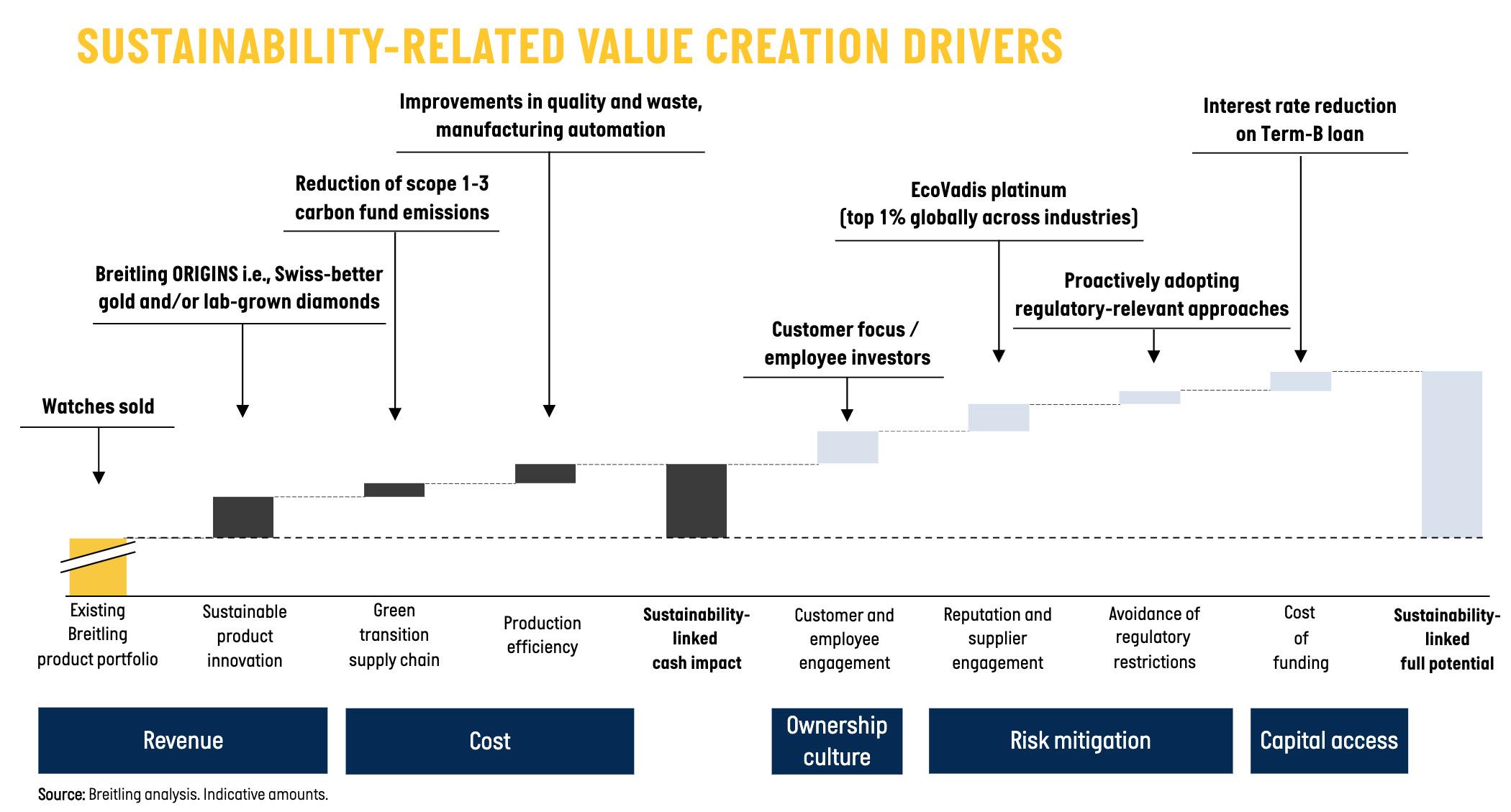

In just one year that share has increased from onethird to one-half, keeping pace with our public target to achieve full traceability by the end of March 2026. At the same time, they are catalyzing growth in the female segment, where these materials are mostly prevalent. Categories with the Origins Label have grown to account for one-quarter of all female products sold in terms of sell-out value, from a baseline of 5% in FY23, when we launched our inaugural product with these attributes, the Super Chronomat 38 Origins. While we cannot definitively isolate this demand to the sustainability attributes, we see this as contributing to an overall compelling offering in a competitive marketplace.
To build upon this momentum, we have organized several events in our global markets in the reporting cycle to promote our work related to sustainability and further increase engagement with existing and potential customers.
Durability is also a key contributor to sustainability. We design products to last at the outset and take responsibility for them for the long-term. Our efforts to provide both repair and resale services are a fundamental aspect of customer engagement for sustainability and a strategic anticipation of societal demands for increased circularity for more sustainable consumption habits. Our actions are done so in a way that meets market demands while benefiting the business, as exemplified by our certified pre-owned (CPO) program.
Already in 2014, we installed solar photovoltaic panels at our headquarters buildings in Grenchen, Switzerland. And, between 2013-2018, we reduced energy consumption at the Breitling Chronometrie in La Chaux-de-Fonds by 50%. We have continued to build on these achievements, reducing our environmental impact across our operations. From FY22 to FY25, we have reduced our scope 1 & 2 emissions by 42.5%. We further advance our efforts
through our valuation of externalities – including placing a voluntary price of CHF 40 on carbon following the minimum pricing guidance of the Carbon Pricing Leadership Coalition. This supports the reduction of emissions and creates shared value through community engagement and nature regeneration along our supply chain.
Our efforts to engage extend across the full scope of our sustainability remit and across the supply chain. We have engaged with over 71% of our direct suppliers by spend to drive sustainability performance across the supply chain. We work directly with our supply chain partners to support green transition across the supply chain, including the co-financing of carbon reduction efforts.
Within our manufacturing site in La Chaux-de-Fonds, we continue our investment in the future shop floor. Our improvements in quality and waste are measured by a decreasing warranty return rate and a reduction of several items of material waste. This adds to our efforts to reduce plastic waste, where we have a dedicated target to be plastic waste free by March 2026. Breitling`s manufacturing site is also harnessing technological advancements. In this reporting cycle, we have completed several successful automation projects, laying the foundation for future state-of-theart production processes.
Our efforts to attract the best talent and engage with workers in the supply chain have been duly recognized as Breitling was awarded best employer in Switzerland for the watch industry in 2025, after many prior years of top rankings. These efforts are further evidenced through our designation as a Top Employer certified for excellence in employee conditions. It is through such acknowledgments that we gain further credibility in the labor market, which in turn helps us attract the best talent and increasing this key competitive advantage.

Entrepreneurship and striving for performance are key values of our corporate culture. Our shareholders have invited key managers and all employees to become shareholders and to invest their own funds in respective investment programs, thereby aligning the long-term growth interests of our main shareholders with those of our employees. In the 2025 reporting period, a total of 244 employees representing 12.7% of all full-time employees globally were active investors into Breitling.
Another important element of our sustainability strategy has been our continued investment into further improving customer engagement. We put our customers first by focusing on a seamless, 360 degrees omnichannel strategy, while preserving a strong ethical and data privacy grounding. In the reporting cycle, we welcomed our inaugural chief customer officer to Breitling in recognition of the importance this topic holds.
We cultivate through our strong corporate governance a corporate culture that is characterized by integrity, transparency, and ethical business practices.
Together, these efforts contribute to overall brand attractiveness and in turn, our competitiveness as a brand.
I
first discovered Breitling at fourteen when I came across a Chronomat—it sparked a deep appreciation for the brand’s heritage, design, and functionality. My fascination grew when my father bought an Aerospace, and I was hooked. When I purchased my own Navitimer World GMT, it was all about aesthetics and performance—a dependable travel companion for both work and leisure. Today, sustainability plays a much bigger role in my choices. I admire how Breitling takes responsibility for the entire lifecycle of its watches, from ethical sourcing and material innovation to thoughtful packaging, setting a strong example in the watch industry.
MARCUS HANSSON STOCKHOLM, SWEDEN BREITLING COLLECTOR



In less than two years, we have expanded our Origins Label for watches containing traceable gold and/or lab-grown diamonds beyond the original Super Chronomat Automatic 38 Origins to now over 30 references to date. As a result 1/2 of all products containing gold and diamonds now bear our Origins label.
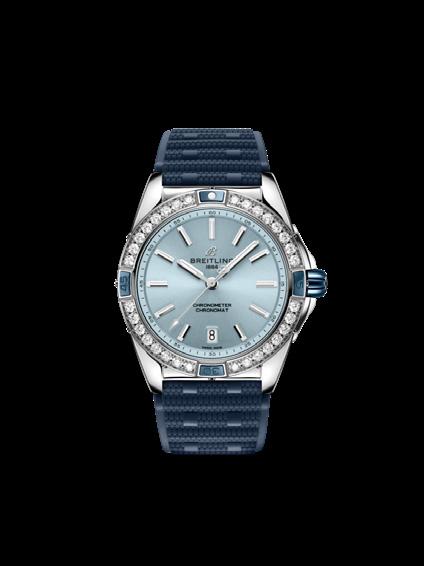



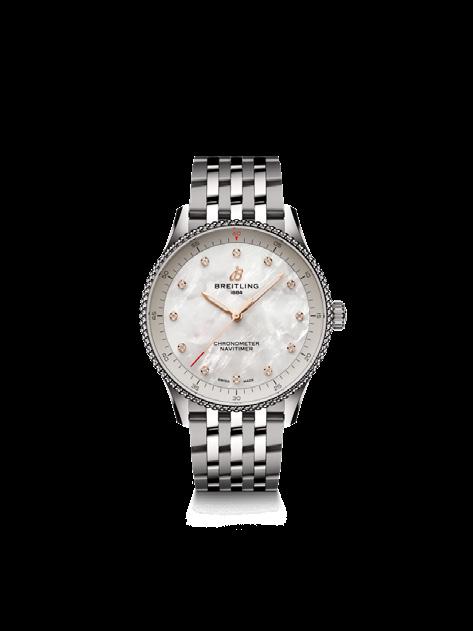
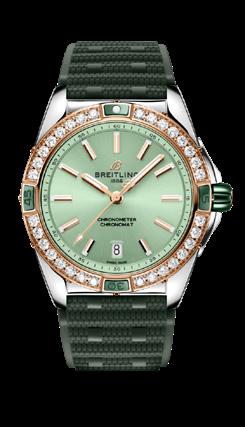
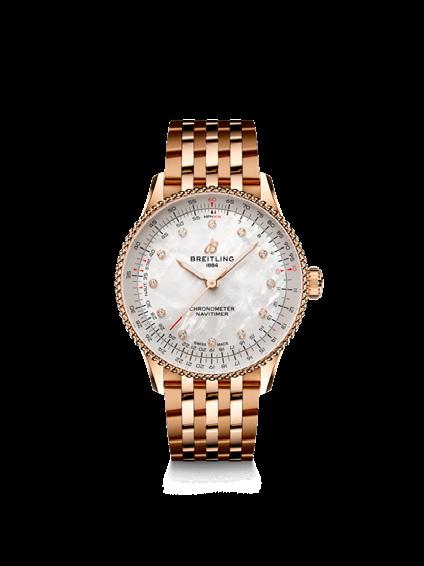
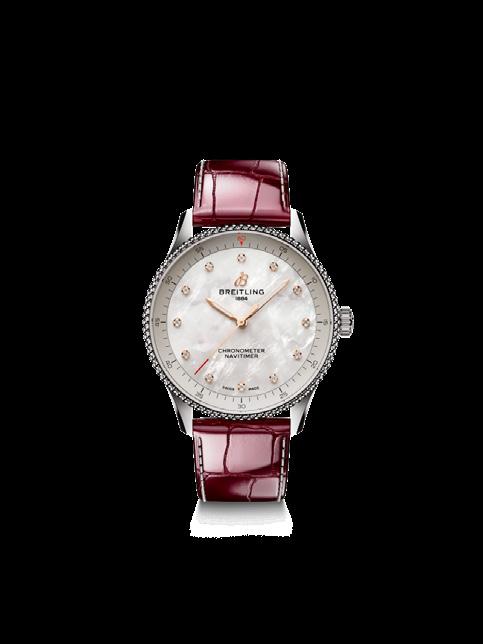

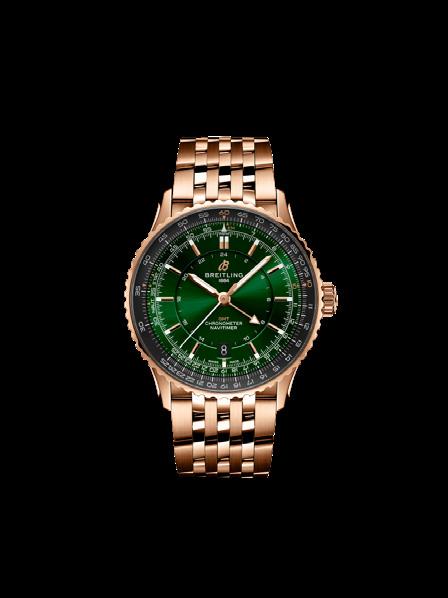


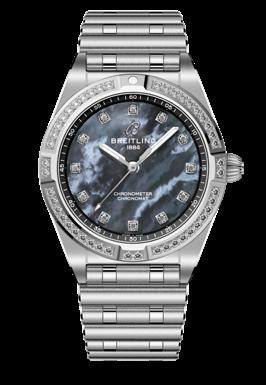

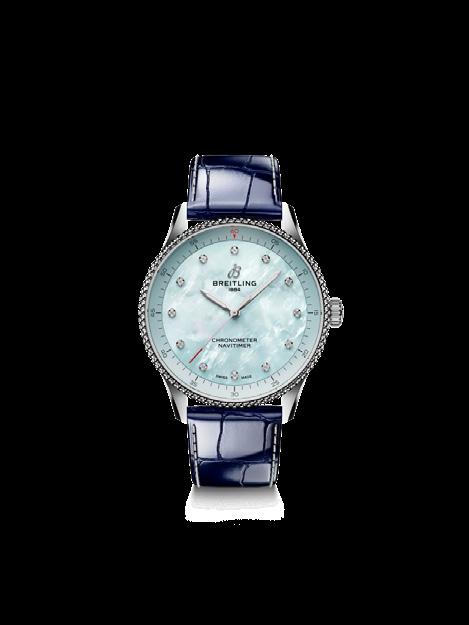




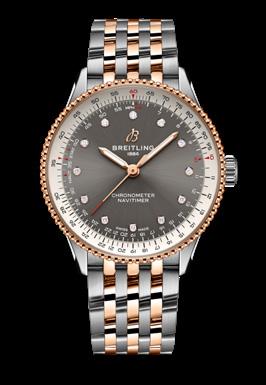

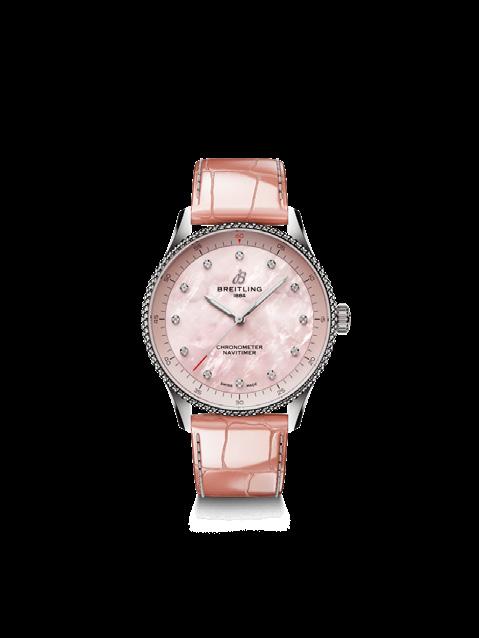
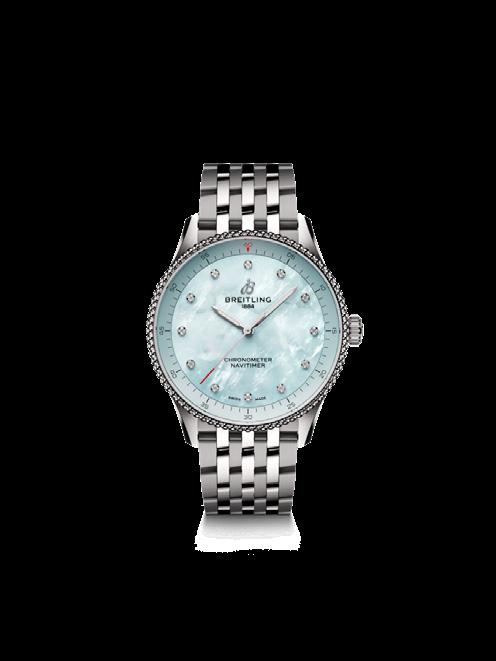
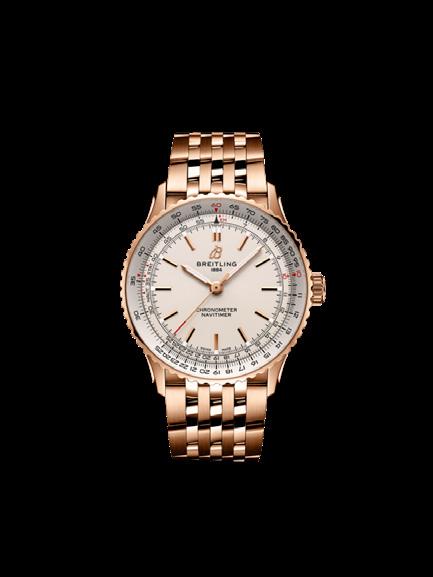
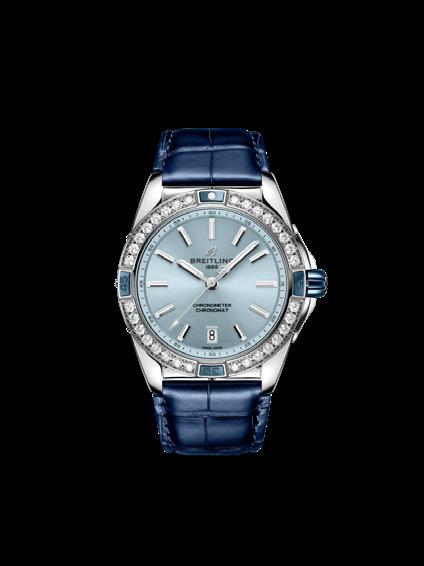

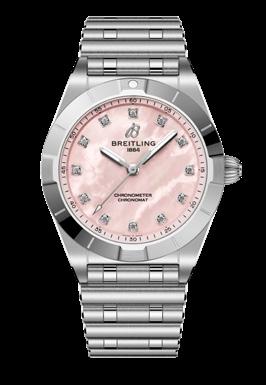

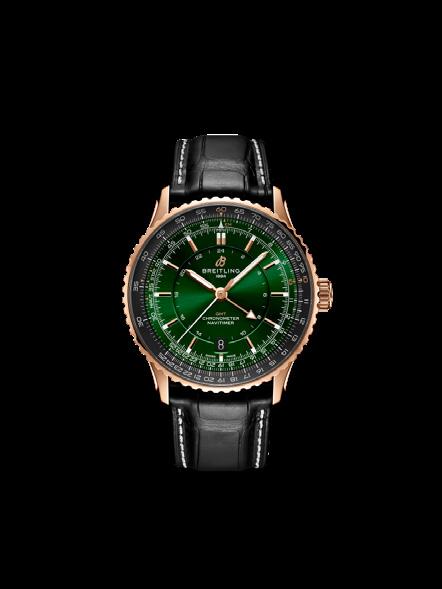
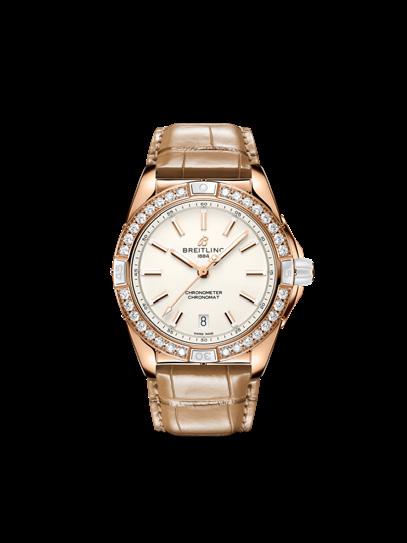


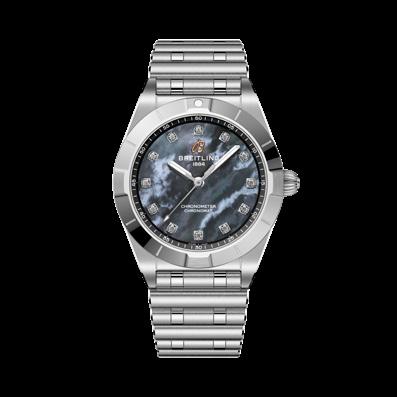
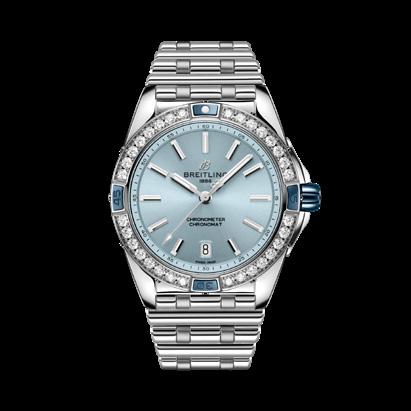

We perceive a range of factors to positively impact our reputation, while bringing our values to life. Our proactive adoption of the European Sustainability Reporting Standards already in 2024 along with other industry-leading guidance and standards such as the Taskforce on Climate-related Financial Disclosures and the Taskforce on Nature-related Financial Disclosures, among others, both demonstrate our commitment to adopting the most forward-thinking approaches to sustainability while also further linking sustainability directly to value creation. Further accolades awarded to the company on account of our achievements, such as the inaugural award for Best Sustainable Watch from the Temporis International Awards for the Super Chronomat 38 Origins, or being recognized as the Best Employer in Switzerland, are indicative of the resonance of our efforts.
We take responsibility for our products across our value chain, considering and mitigating impacts across our sphere of influence. Within the reporting cycle, we also had our efforts recognized by EcoVadis as being within the top 1% of all companies assessed globally and thereby received the prized platinum medal. Since 2020, we have completed an annual EcoVadis assessment, along with several other ratings which we detail in this and prior reports. Across the assessed areas of labor & human rights, environment,
ethics and sustainability procurement, we have been able to steadily increase, thanks to the substantial efforts made both across the company and in collaboration with our partners globally. We will continue to deepen our supplier engagement efforts in the ongoing reporting cycle, including through our membership in Sedex SMETA, which focusses on supplier sustainability from a social and environmental perspective to both further mitigate risk and continue to build value through sustainability and our shared values with our supplier community.
Through all these efforts, we create value through an approach which is relevant to customers, employees and suppliers. At the same time, we proactively integrate dynamic regulatory requirements in a way that strengthens key efforts we have been making over the last years regarding community-based value chains, traceability, and product responsibility including circularity.
Through our sustainability efforts, we have achieved better access to capital and generated more cash flow through a decrease of our interest rate through a sustainability loan linked to established annual sustainability targets. In this reporting period, we have been able to achieve the targets we have set for our sustainability-linked loan, reducing our direct operations, or scope 1 and 2 greenhouse gas
The higher value in FY25 results from the Group’s expansion in own retail.
expenditures include infrastructure and other acquisition costs which occur infrequently.
and development costs follow product development cycles and vary year by year.
The decrease in FY25 is mainly due to lower gold purchases and thereby lower contributions to the Better Gold Fund which are allocated based on purchase volume.

emissions, moving towards the elimination of plastic waste across our operations, and improving our full-scope sustainability rating by EcoVadis.
A key achievement in this reporting cycle has been the acquisition of Gallet, Breitling’s second acquisition of a notable watch brand following the purchase of Universal Genève in 2023. The acquisition of Gallet represents a further expansion of Breitling’s influence in the luxury watch sector. With a legacy of precision timekeeping for early long-distance travel, exploration, and adventure, Gallet will be positioned as a luxury, entry-level sibling brand to Breitling.
We plan to revive Gallet as a reputable watchmaking brand while honoring its legacy of adventure and innovation in chronographs. Gallet will be revived under the umbrella of Breitling, creating synergies and benefitting from Breitling’s expertise and craftsmanship. With the addition of Gallet, we are convinced that we are expanding our total addressable market and that together with Breitling and Universal Genève we have a strong portfolio of complementary brands for the years to come. As operations for Universal Genève and Gallet are developed, they will be included accordingly in our reporting and sustainability activities going forward.
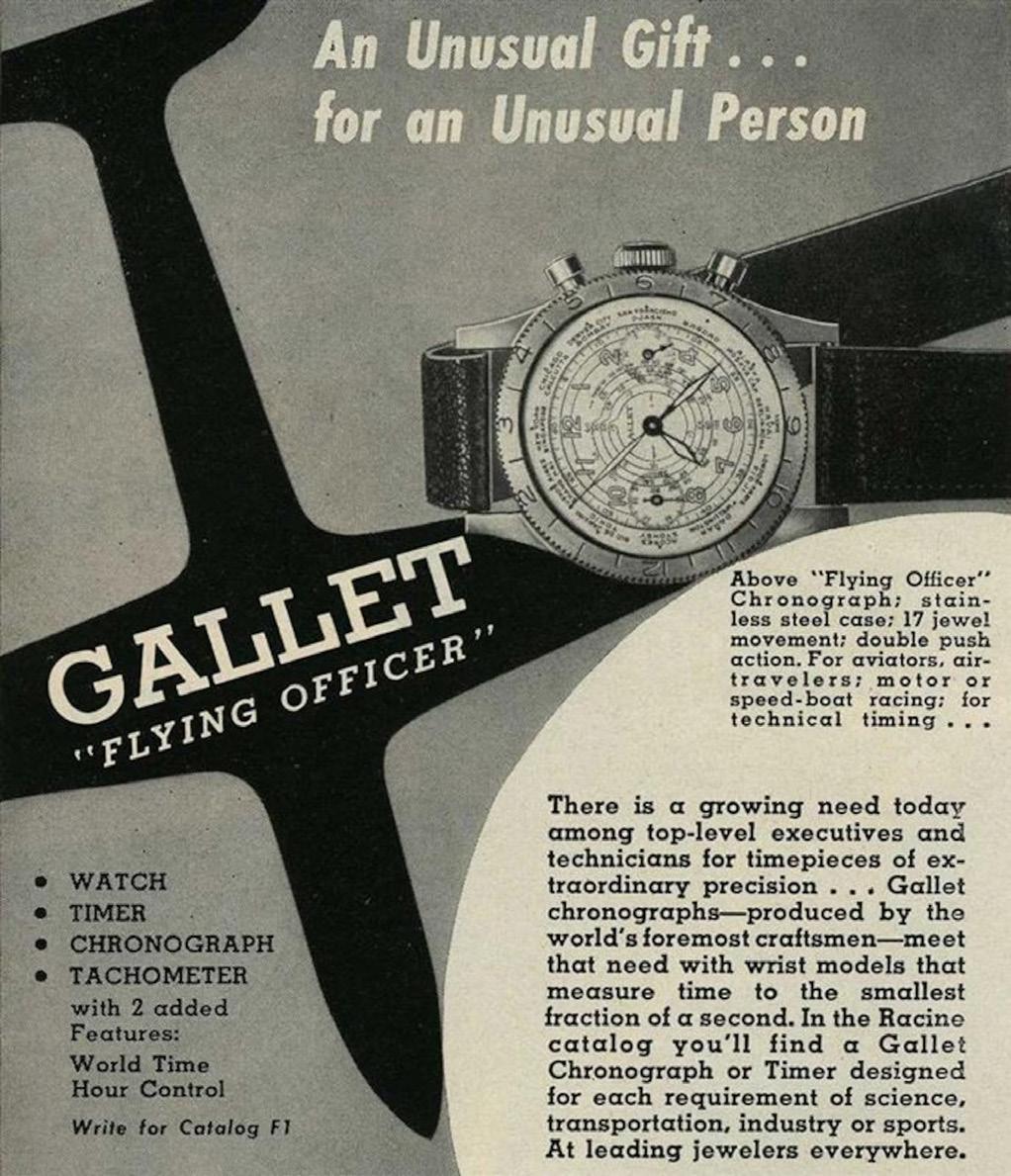
GALLET’S HISTORY WILL NOT ONLY BE PRESERVED BUT GIVEN NEW LIFE AS ITS SIBLING BRAND INSPIRED BY WANDERLUST, ADVENTURE, AND OUTDOOR ACTIVITIES.


Our double materiality assessment (DMA), shown on the next page, is aligned to the guidance and definitions outlined in the European Union Corporate Sustainability Reporting Directive’s European Sustainability Reporting Standards (ESRS) 1: General Requirements, released on July 31, 2023. Exhaustive details regarding its methodology is available in our 2024 Sustainability Mission Report (pages 35-47). The DMA allows us to assess both our impact on people and planet alongside the impacts, risks and opportunities these entail for our stakeholders and for Breitling itself. The results of this assessment are available on the following pages. It is a vital tool to steer our sustainability strategy in the right direction, foster long-term value creation, meet investor expectations and ensure regulatory compliance.
As can be seen on the matrix on the next page, our assessment identified nine of ten ESRS topics as material at the proactive threshold, encompassing approximately 50% of sub-topics to focus on relevance and scope. Complementary material topics which have been assessed to hold similar degrees of importance have been grouped together, as indicated in the boxes shown in the matrix.
The assessment was conducted in 2024 and will be repeated in 2026, following a bi-annual cycle. This approach ensures that our evaluation of material topics remains current and aligns with evolving stakeholder expectations and regulatory requirements, as well as ensuring transparency and responsiveness in sustainability reporting. For full details on the conduct of our DMA, please review the progress chapter of our 2024 Sustainability Mission Report or please visit our double materiality assessment documentation on our download center.
While we cover the full-scope of our global impacts herein, it is important to note that Breitling is first and foremost a Swiss-based company, with the vast majority of value addition occurring in Switzerland.
WE ARE COMMITTED TO ADOPTING THE MOST FORWARDTHINKING APPROACHES FOR SUSTAINABILITY

EUROPEAN SUSTAINABILITY REPORTING STANDARDS (ESRS) & CORPORATE SUSTAINABILITY REPORTING DIRECTIVE (CSRD)
S4 Information-related impacts for consumers and/or end users
Corporate culture E1 Climate change mitigation, E3 Water; E4 Direct impact drivers of biodiversity loss; E5 Resources inflows, including resource use; E5 Resource outflows related to products and services
S3 Community rights; S3 Rights of Indigenous Peoples
Own workforce – Working conditions; Equal treatment and opportunities for all
S2 Workers in the value chain – Working conditions and other work-related rights
G1 Management of relationships with suppliers including payment practices; G1 Corruption and bribery
G1 Protection of whistleblowers
Impact materiality
REFERENCED FRAMEWORKS AND STANDARDS
TASKFORCE ON CLIMATE-RELATED FINANCIAL DISCLOSURES (TCFD)
TASKFORCE ON NATURE-RELATED FINANCIAL DISCLOSURES (TNFD)
INTERNATIONAL SUSTAINABILITY STANDARDS BOARD (ISSB) SASB STANDARDS
COUNTERPROPOSAL TO THE RESPONSIBLE BUSINESS INITIATIVE (RBI)
FURTHER REPORTING STANDARDS WHERE RELEVANT (E.G., WEF/IBC STAKEHOLDER CAPITALISM METRICS, GRI)

E1 - Climate change
Climate change adaptation
Risk – upstream Areas subject to extreme weather events
Short-to-long-term
Risk – upstream
Climate change mitigation
Opportunity – upstream, own operations, downstream
Risk – downstream
Increase in leather prices
Medium-to-longterm
Areas that will be subjected to increased temperatures and rainfall in future. Conditions will be more variable, cycling between severe wet and dry periods. Changing weather patterns will lengthen dry periods, leading to increased drought risk. In contrast, weather systems which do arrive in the area will bring increased severe rainfall, which can be a proxy for pluvial flooding risk. By cycling through extremes, increased stress will be placed on infrastructure, transportation, and agriculture in the affected regions.
Increase in leather prices due to yield losses due to heat and water stress, and hurricanes (especially in the USA).
Negative impact – own operations (actual)
Meeting climate objectives
Long-term
Meeting climate objectives (science-based targets to meet the targets of the Paris Agreement), and satisfying key stakeholders across the value chain like investors and customers.
Increased cost of alternative materials development
Breitling scope 1 and 2 GHG emissions
Short-to-long-term
Negative impact – upstream, own operations (actual)
Breitling Scope 3 GHG emissions
Short-to-long-term
Short-to-long-term
Increased cost of development for alternative materials to reduce dependency on natural resources (lab-grown diamonds, alternative leather, recycled steel or aluminum)
We generate Scope 1 and 2 emissions primarily through mobile combustion (vehicle fleet) stationary combustion (natural gas for heating) and electricity usage for usage for manufacturing, offices and internal boutiques. The emissions associated with these activities have a negative impact on climate change.
Our value chain generates Scope 3 greenhouse gas emissions, stemming from activities such as business travel, purchased goods and services, employee commuting, upstream logistics, franchises, and energy & fuel related services, administration and production premises/ facilities. The emissions associated with these activities have a negative impact on climate change.

Negative impact – upstream (actual)
Negative impact - upstream (actual)
Breitling food, beverage, and entertainment business Scope 3 GHG emissions
Short-to-long-term
Positive impact – upstream, own operations (potential)
Breitling watches and indirect procurement materials business Scope 3 GHG emissions
Reduction of Scope 3 GHG emissions
Short-to-long-term
DESCRIPTION
Our food, beverage, and entertainment business activities generate Scope 3 emissions. Upstream production of food, transportation of food, the construction of capital goods and production of furniture for the restaurants result in those Scope 3 emissions. The emissions associated with these activities have a negative impact on climate change.
Our watches and indirect procurement materials business generates Scope 3 emissions, particularly in the extraction and production of raw materials and the associated logistics. Upstream activities such as mining, transportation of materials, and manufacturing processes conducted by suppliers result in these scope 3 emissions. The emissions associated with these activities have a negative impact on climate change.
Short-to-long-term
ESRS E3 - Water and marine resources
Risk – upstream Diamond mining activities
Medium-to-longterm
Negative impact – upstream (actual)
Negative impact – upstream (actual)
Disruption of natural water flow due to sedimentation in diamond sourcing
Disruption of natural water flow due to sedimentation in gold mining
Short-to-mediumterm
Short-to-mediumterm
DESCRIPTION
Breitling has the potential to generate a positive impact by actively pursuing initiatives to reduce Scope 3 greenhouse gas emissions. For instance, identifying lower impact sources of gold and supporting low carbon transition in the gold sector, funding ongoing investments in alternative fuel sources, sourcing highquality recycled and alternative materials for the boutiques, and adopting recycled materials across the value chain.
The extraction, processing, and dust suppression activities from diamond mining need substantial water resources, that may become scarce in water stressed areas.
Note: By transitioning to lab-grown diamonds, Breitling is mitigating this risk
Sedimentation (deposition of sediment in bodies of water in diamond sourcing) disrupts the natural flow of water, causing changes in hydrological patterns that can harm aquatic ecosystems.
Sedimentation (deposition of sediment in bodies of water in gold mining) disrupts the natural flow of water, causing changes in hydrological patterns that can harm aquatic ecosystems.

ESRS E4 - Biodiversity and ecosystems
Direct impact drivers on biodiversity loss
Opportunity – upstream Shift to lab-grown diamond sourcing
Resource inflows related to products and services
Opportunity – own operations
Use of recycled materials
Resource outflow related to products and services
Positive impact – own operations (actual)
Working conditions
Opportunity – own operations
Managing design and lifecycle of our watches
Short-to-long-term
Commitment to salary benchmarking
Equal treatment and opportunities for all
Positive impact – own operations (actual)
Commitment to salary benchmarking and unconscious bias training
Short-to-long-term
Lab-grown diamonds provide a sustainable alternative to traditional diamond mining. This strategic shift reduces the ecological footprint associated with conventional diamond extraction, addressing environmental consequences such as soil erosion, land degradation, and habitat disruption.
Short-to-long-term
Short-to-long-term
Opportunity to move to the use of recycled materials in Breitling boutiques.
Managing the design and lifecycle of our products to promote quality assurance, safety, traceability, transparency and animal welfare.
Our commitment to salary benchmarking, equal pay surveys, and unconscious bias training demonstrates a proactive approach to maintaining fair compensation practices and fostering a workplace free of discrimination.
Short-to-mediumterm
Positive impact – own operations (actual)
Non-discrimination and continuous education
Short-to-mediumterm
Our commitment to salary benchmarking and the conduct of equal pay surveys demonstrates a proactive approach to maintaining fair compensation practices. We work to build sensitivity among employees involved in hiring and succession processes on unconscious bias and its effects.
We actively promote a positive impact through ensuring non-discriminatory access to opportunities for education, training, employment and career development.

Opportunity – own operations Training programs
Short-to-long-term
Opportunity – own operations
Employee engagement
Short-to-long-term
Providing training, development and wellbeing for employees and engaging them in our sustainability journey. Our training program includes Breitling apprenticeship programs, sales training, After-Sales-Service technician training, internal and external f2f training programs in the Breitling eLibrary: Coursera, Get Abstract, language courses and coaching.
The creation of the Employee Engagement Survey platform fosters open communication and the exchange of information on matters of common interest related to employee policy, ensuring diverse perspectives are considered in decision-making processes.
Working conditions
Positive impact – upstream (actual)
Negative impact – upstream (actual)
Lab-grown diamond sourcing
Gold sourcing
Short-to-long-term
Negative impact -upstream (potential)
Health and safety in the diamond value chain
Short-to-long-term
Short-to-long-term
Sourcing lab-grown diamonds enables traceability and allows us to confidently confirm that our lab-grown diamonds are produced free of human rights abuses.
The gold mining industry, as reported by the International Labour Organization (ILO), stands as one of the most dangerous professions globally. Despite comprising only 1% of the world‘s labour force, the industry contributes to 5% of on-the-job fatalities. Workers in gold mining face significant risks, including dangers such as rock falls, tunnel collapses, fires, and heat exhaustion.
Negative health and safety impacts on workers in the diamond value chain (mined diamonds), such as mining accidents, chemical exposure, risks of incidents with occupation hazards.

Other work-related rights
Negative impact – upstream (potential)
Forced labor in gold and diamond mines
Short-to-long-term
Negative impact – upstream (potential)
Workers in the value chain
Short-to-long-term
In some gold and diamond mines, adults and children have become victims of forced labor and human trafficking. Forced labor is understood as a situation where an individual works involuntarily and under “menace of penalty.” Those who attempt to leave may face violence and other abuse. Human trafficking occurs when a person is recruited or transported by force, threat, or deception for the purpose of exploitation.
Note: Breitling is not aware of such issues in its supply chains, but includes this potential negative impact for the purpose of completeness.
Impacts on workers in the value chain through pressure on availability of adequate housing, as well as water and sanitation supply, as a result of operations.
Note: Breitling is not aware of such issues in its supply chains, but includes this potential negative impact for the purpose of completeness.
Negative impact – upstream (actual)
Child labor in the gold value chain
Negative impact – upstream (potential)
Child labor in the gemstones value chain
Short-to-long-term
Negative impact – upstream (potential)
Forced labor in the gemstones value chain
Short-to-long-term
Children work globally in artisanal and smallscale mining, in violation of international human rights law, which defines work underground, underwater, or with dangerous substances.
Note: Breitling is not aware of such issues in its supply chains, but includes this potential negative impact for the purpose of completeness.
Child labor during the extraction and production of precious stones can be a prevalent issue. Children are employed in different stages of the mining process including digging, sifting through gravel, and sorting gemstones. They can also be involved in the cutting and processing of gemstones.
Note: Breitling is not currently sourcing colored gemstones, and is aware of no such prior issues in its supply chains, but includes this potential negative impact for the purpose of completeness.
Short-to-long-term
Workforces in the mining and production of gemstones can labor under exploitative conditions
Note: Breitling is not currently sourcing colored gemstones, and is aware of no such prior issues in its supply chains, but includes this potential negative impact for the purpose of completeness.

ESRS S3 – Affected communities
Community rights
Negative impact – upstream (potential)
Positive impact – own operations (actual)
Local communities affected through mining activities
Short-to-long-term
Promotion of wellbeing and economic development
Opportunity – upstream Commitment to community engagement
Negative impact – upstream (potential)
Short-to-long-term
Negative impact on local communities due to mining companies and governments abusing the rights of local residents when clearing land for exploration and mining.
Note: No such issues are known within Breitling supply chains, but this potential negative impact is included for the purpose of completeness.
Positive impact on affected communities by promoting wellbeing and economic development of communities affected by our business activities, preventing exploitation and contributing to inclusive growth.
Short-to-long-term
Opportunity for greater product storytelling on our commitments to community engagement, leading to higher brand engagement.
Negative impact – upstream (potential)
Mining-related activities
Short-to-long-term
Violation of rights of Indigenous Peoples in mining operations
Short-to-long-term
Mining-related activities, encompassing both gold and other materials, contribute to social conflicts in the region. Mining and trade could help finance violent and abusive armed groups, including through money laundering. The absence of legal recognition for Indigenous Peoples as owners of their lands exacerbates vulnerabilities. In instances where mining leases are granted, Indigenous communities face the threat of eviction, leading to social unrest. This lack of legal protection perpetuates an unjust cycle, with Indigenous populations disproportionately affected by the consequences of mining activities.
Note: No such issues are known with Breitling supply chains, but this potential negative impact is included for the purpose of completeness.
Mining operations can cause violations of the rights of Indigenous Peoples, by for example failing to secure free, prior, and informed consent from Indigenous communities before doing exploration, which in violation of international human rights standards.
Note: Breitling is not aware of such issues in its supply chains, but includes this potential negative impact for the purpose of completeness.

ESRS S4 – Consumers and end-users
Information-related impacts for consumers and/or end-users
Opportunity – downstream Transparency
Short-to-long-term
Opportunity – own operations Customer engagement
Opportunity – downstream Brand awareness through sustainability initiatives
Opportunity – downstream Sustainability education
Opportunity – downstream Gain understanding of customer needs and wants
Opportunity – own operations
Cultivating positive corporate culture
Positive impact – own operations (actual)
Grievance mechanism in own operations
Short-to-long-term
Short-to-long-term
Short-to-long-term
Short-to-long-term
Short-to-long-term
By being transparent, Breitling builds trust among our customers leading to increased engagement with the brand including through sales and net-promotion.
Ensuring customer satisfaction through prioritizing privacy, security and attentive service while engaging responsibly in public relations, lobbying, marketing and advertising.
Potential to gain entirely new customers for the brand who learn about it through headline sustainability initiatives.
Sustainability education to be more receptive towards sustainability related topics increases acceptance and demand for our USP in this area.
Listening to customers on sustainability related matters leads to a better understanding of customer needs and wants.
Cultivating a positive corporate culture at Breitling, characterized by integrity, transparency, and ethical business practices, serves as a strategic opportunity. This alignment with strong values and a clear code of conduct enhances employee morale, engagement, and a sense of purpose within the organization.
Short-to-mediumterm
Positive impact – upstream, downstream (actual)
Grievance mechanism in the value chain
Short-to-mediumterm
By using SpeakUp, we encourage our employees to be an active part of a culture that is confident to raise concerns in a productive and safe manner. This allows the leadership team to intervene as early as possible to protect its employees, stakeholders, and society.
An effective whistleblowing protection program encourages our employees and suppliers to raise concerns in a productive and safe manner. This allows us to intervene as early as possible to protect our employees, stakeholders and society.

Animal welfare
Risk – upstream Leather production
Short-to-long-term
Management of relationships with suppliers including payment practices
Positive impact – own operations (actual) Trade compliance
Positive impact – upstream, own operations (potential)
Short-to-long-term
The production of leather, particularly through traditional methods like cattle farming, raises significant concerns about animal welfare. This could result in rising costs and new regulations in the supply chain.
We place emphasis on trade compliance in the employee code of conduct and ESG policy, adhering to export controls, embargoes, sanctions, and customs regulations.
Supplier engagement
Short-to-long-term
Corruption and bribery
Positive impact – own operations (actual)
Positive impact – own operations (actual)
Addressing ethical and legal issues
Fostering positive corporate culture
Short-to-mediumterm
Short-to-long-term
By establishing and maintaining effective, transparent, and mutually beneficial interactions with suppliers, Breitling fosters a collaborative environment built on trust and openness. Fair payment practices ensure that suppliers receive timely and equitable compensation for goods and services provided.
Addressing ethical and legal issues including internal controls, transparent management practices, and ensuring no fraud, corruption, bribery, or anti-competitive behavior.
We actively foster a positive corporate culture by emphasizing the avoidance of situations involving personal interest or conflicts. The CoC is part of our onboarding.

Our targets are aligned to our material topics and accordingly to our impacts, risks and opportunities which are introduced on pages 25-33 of this report and to the United Nations Sustainable Development Goals (SDGs). For more information about these and the goals represented by the numbers noted here, please visit: THE 17 GOALS | Sustainable
Community
Material topics addressed:
Issue an enhanced traceability declaration on the blockchain NFT for all main collection products containing gold and diamonds by end FY26
Improve the average EcoVadis score for suppliers by 15% / score 61 by end FY26
Integrate traceable artisanal and small-scale mined (ASM) gold across all main collection products by end FY26
Employee shareholding to exceed 15% by end FY27
Top 25% of the global benchmark in the Glint Engagement Survey by end FY26
by end FY27
Development. In the reporting cycle, we have made good progress on our targets and provide further details below. Please note that while targets are presented in only one section, in many cases due to their systemic nature, they do impact across areas of our work, duly noted by the material topics specified in each section.
• S1 Own workforce – Working conditions
• S1 Own workforce – Equal treatment and opportunities for all
• S2 Workers in the value chain – Working conditions • S2 Workers in the value • S3 Community rights
Foremost presents opportunities: Transparency
Customer engagement Brand awareness through sustainability Also creates framework conditions to impacts and risks including topics in S2, S3
Creates framework conditions which opportunities and addresses impacts including those related to material topics
Creates framework conditions which opportunities and address impacts and including those related to material topics S2, S3
Employee engagement
Cultivating positive corporate culture

Requires attention
sustainability initiatives address E1, E3, E4, 12
present and risks topics E1, S2, S3
8, 12
We continue to make good progress on this ambitious target and remain committed to our timeline of end FY26.
Most important advancements by our suppliers were made in the category of sustainable procurement in the reporting cycle. present and risks topics E1, E3, 4, 8, 12
8 NA
8
8
17
Uptake is lower due to use of existing stock across our collection, reducing the share of new purchases of traceable gold. Target remains on track, with substantial cross-industry cooperation supporting this ambitious target.
With the introduction of the Employee Investment Program in 2025, the total number of employee shareholders (both key managers and employees) increased to 244 employees in 2025, representing 12.7% of all full-time employees globally.
Measured by the average score of two indicators: 1) How happy are you working at Breitling and 2) I would recommend Breitling as a great place to work. Benchmarked against 900 companies using Glint Survey. Our stable performance remains above our industry average thanks to factors including learning opportunities, career development and a federating mission and vision.
An active learner makes use of our training offerings at least once in the reporting cycle. Our increase in, and improved structure of, our training drove a higher uptake.
While many activities occurred in the reporting cycle, we have proactively restated the due date of this ambitious and important target from end FY26 to end FY27.

Material topics addressed:
Achieve Carbon Disclosure Project (CDP) A list status in Climate by end FY28 and end FY30 for Water and Forests
Establish Science Based Targets for Nature across the value chain by end FY26
Reduce Scope 1 and 2 emissions by 80% by FY32 from an FY22 baseline (market-based)
Reduce Scope 3 emissions by 46.2% by FY32 (market-based)
Achieve 100% renewable energy for electricity globally by end FY26
Generate 0% mismanaged plastic waste across operations by end FY26
Transition to a fully electric fleet by end FY26
Source lab-grown diamonds for all new main collection products by end FY26
Climate: AWater: C Forests: C
Climate: B: Water: NA Forests: NA
Climate: D (FY22) Water: C (FY25)
• E4 Direct impact drivers of biodiversity loss
• E5 Resources inflows, including resource use
• S3 Community rights
Forests: C (FY25) E1, E3, E4
Reflects progress made which presents opportunities and addresses impacts including those related to material
Presents opportunities and addresses risks including those related to material E3, E4
Presents opportunities and addresses
Meeting climate objectives
Breitling Scope 1 & 2 GHG emissions
Presents opportunities and addresses Meeting climate objectives
Breitling Scope 3 GHG emissions
and addresses
Meeting climate objectives
Breitling Scope 1 & 2 GHG emissions
Presents opportunity: Employee engagement
Breitling Scope 1 & 2 GHG emissions
Presents opportunities and addresses risks:
Diamond mining activities
Disruption of nature water flow due sedimentation in diamond sourcing
Shift to lab-grown diamond sourcing
Lab-grown diamond sourcing
Forced labor in gold and diamond
Mining-related activities
Violation of rights of Indigenous Peoples operations
Brand awareness through sustainability

OPPORTUNITIES
presents impacts and risks material topics E1, E3, E4
6, 13, 14, 15
addresses impacts and material topics E1, 6, 13, 14, 15 NA
addresses impacts: emissions 13
addresses impacts: 13
addresses impacts: emissions 7, 13
Good progress has been made in climate thanks to a range of initiatives to reduce our emissions and improve management thereof. Baseline rating for water and forests sets a positive starting point with key initiatives already in place to increase performance.
Emissions reduced due to the uptake of renewable energy in all our subsidiaries facilitated by energy attribute certificates.
Emissions decreased due to lower production volume.
Increased uptake of renewable energy in key global markets through the purchase of energy attribute certificates. 12, 14, 15
Reduced plastic use in transport and operations. Updated database reflecting countrylevel plastic waste management systems.
addresses impacts: emissions 13 NA addresses impacts and due to sourcing sourcing mines Peoples in mining sustainability initiatives 14, 15
Products made with mined diamonds before the transition completing phase-out.

Material topics addressed:
• G1 Corporate culture
• G1 Management of relationships with suppliers including payment practices
• G1 Corruption and bribery
Zero incidences of corruption or anti-competitive behavior
Achieve EcoVadis platinum medal (top 1% globally) by end FY28 84/100 Platinum medal (top 1% globally) 64/100 Silver medal (top 10% globally) 50/100 Bronze Medal (Top 35% globally) (FY21)
IMPACTS, RISKS AND OPPORTUNITIES
Creating positive corporate culture
Addressing ethical and legal issues
Fostering positive corporate culture
Address factors across all IROs indicated

16 NA We have a comprehensive anti-corruption program based on risk assessment, trainings and controls.
8, 12
We have made substantial progress in the reporting cycle thanks to our full-scope efforts, with the strongest improvements made in the categories labor & human rights and sustainable procurement.

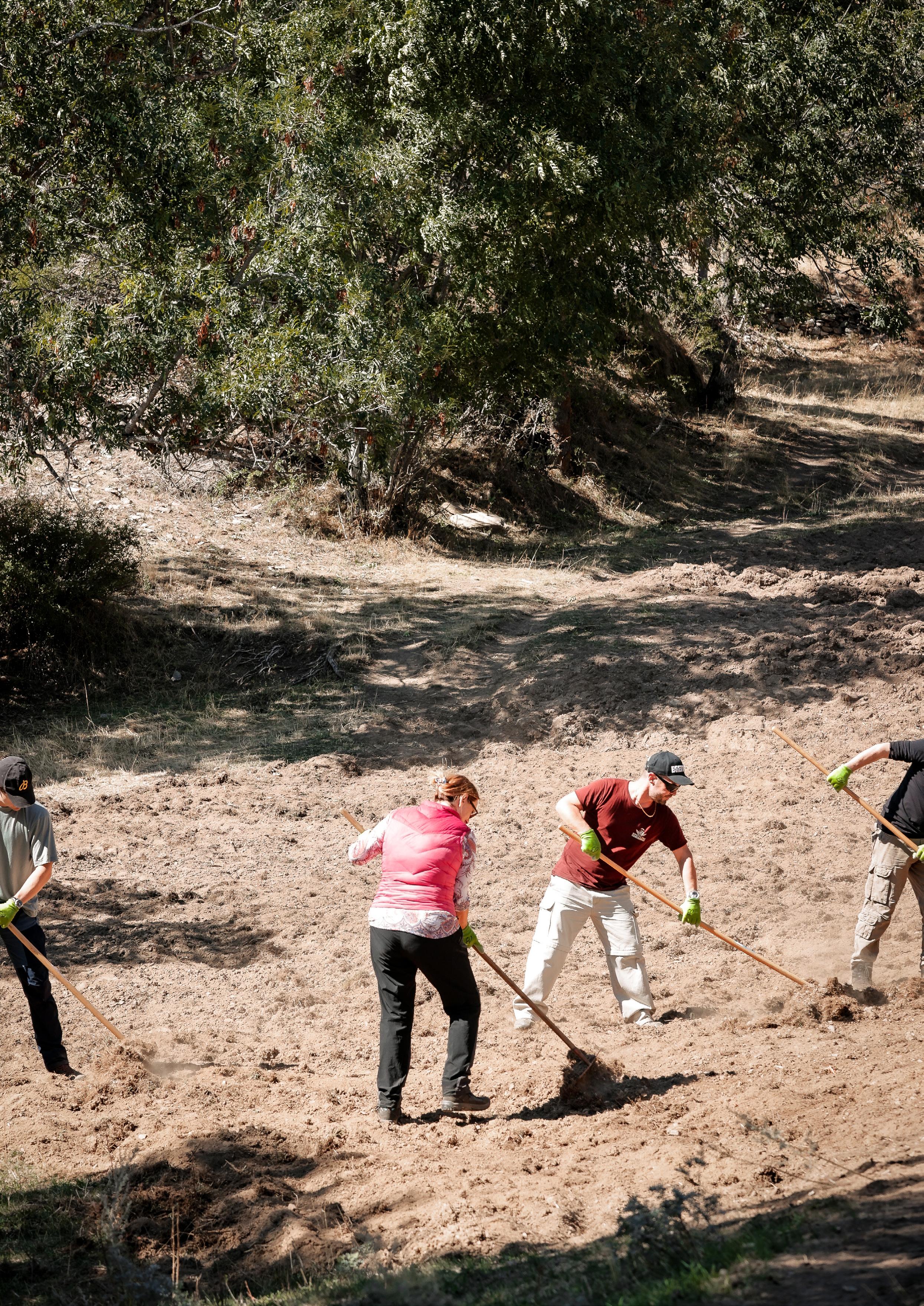
In the reporting period, we enhanced supply chain transparency, increasing the share of our products containing traceable gold and diamonds from 1/3 to 1/2. Our commitment to affected communities is reflected in initiatives like the Better Gold and Better Diamond Funds and their related activities focusing on community education programs, from which 60 individuals have graduated.
We also made significant progress in advancing human rights, expanding our grievance mechanism through the SpeakUp platform, updating our Supplier Code of Conduct, implementing a health, safety, and environment (HSE) policy, and addressing living wages through initial value chain assessments.
We continued our sustainability engagement with employees by engaging over
employees across our Swiss manufacturing sites fostering open dialogue, awareness, and team-based transformation.
For the third year in a row, we have been recognized as a Top Employer and are Best Employer in the Swiss Watches & Jewelry industry in 2025, and maintain a gender pay gap of less than 1%.

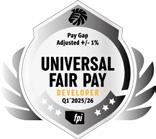
We have broadened our leadership development programs to foster growth and have expanded apprenticeship programs in areas like watch operations and micromechanics in collaboration with the Centre d’Apprentissage de L’Arc Jurassien.
All employees were invited to invest privately-held own funds and become shareholders in attractive investment programs, resulting in a 12.7% share of active investors among all employees globally, further strengthening entrepreneurship and strive for performance as key values of our corporate culture.
We integrated customer feedback into sustainable product development , with the Super Chronomat 38 Origins seeing strong sales growth. Our global sustainability events continue to engage and strengthen customer relationships.

We have made significant progress in addressing nature-related topics, including conducting our first water footprint assessment, as part of our ongoing efforts to adopt the guidance of the Taskforce on Nature-related Financial Disclosures (TNFD). With this assessment we are able to identify both direct and indirect water consumption, a key milestone in our water stewardship efforts that establishes a baseline and provides guidance for future improvements. This builds upon our implementation of the guidance of the Taskforce on Climate-related Financial Disclosures (TCFD) and our climate action targets, aligned to the Corporate Net Zero Standard and validated by the Science Based Targets initiative (SBTi).



We integrate over 70% reprocessed steel across our products, exemplifying our commitment to integrating circularity.
We were awarded an A- score for climate by the Carbon Disclosure Project (CDP), representing a significant improvement from a D score in our base year in FY22. Our climate strategy continues to focus on emissions reductions, renewable energy adoption, and pioneering climate actions. We are reducing our emissions, with particular progress made on direct emissions in scope 1 and 2. A key contributing factor has been our adoption of renewable energy for electricity across our headquarters and subsidiaries globally.
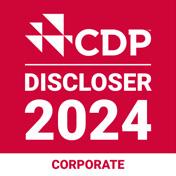
We were able to improve plastic waste reduction by eliminating 1.9 tons and recycling 2.7 tons, bringing us closer to our target of achieving zero plastic waste in operationsby end FY26.
With regards to product responsibility, our After-Sales Service (SAV) network completed over 115,000 interventions in this year alone, ensuring that each Breitling watch is maintained to last for generations.

We uphold the highest standards on corporate governance which are supported by a robust compliance framework. With the leadership and guidance of Partners Group and CVC, our main shareholders, sustainability is strongly embedded in our strategy.
We were awarded the EcoVadis Platinum Medal, ranking us in the top
with a score of 84 out of 100, reflecting significant progress in environment, labor, ethics, and sustainable procurement.

In the current reporting period, we have introduced key policies and global trainings on anti-corruption and avoidance of anti-competitive behavior and intensified our monitoring of and adherence to local and regional regulations addressing product transparency, anti-waste, labeling and harmful substances. We continue to improve our strong emphasis on data protection and cybersecurity.




We take action with communities globally to build shared resilience and prosperity across our value chain and support transformative processes from supply chain communities to customers and beyond.
Material topics addressed: • S1 Own workforce – Working conditions • S1 Own workforce – Equal treatment and opportunities for all
S2 Workers in the value chain – Working conditions • S2 Workers in the value • S3 Community rights
AND
Issue an enhanced traceability declaration on the blockchain NFT for all main collection products containing gold and diamonds by end FY26
Improve the average EcoVadis score for suppliers by 15% / score 61 by end FY26
Integrate traceable artisanal and small-scale mined (ASM) gold across all main collection products by end FY26
Employee shareholding to exceed 15% by end FY27
Top 25% of the global benchmark in the Glint Engagement Survey by end FY26
35% of the Breitling workforce are active learners by end FY25
Foremost presents opportunities: Transparency
Customer engagement
Brand awareness through sustainability Also creates framework conditions to impacts and risks including topics in S3
Creates framework conditions which opportunities and addresses impacts including those related to material topics
Creates framework conditions which opportunities and address impacts and including those related to material topics S3
Presents opportunities: Employee engagement
Cultivating positive corporate culture
Presents opportunity: Employee engagement
Presents opportunities: Training programs
Employee engagement 20,000 hours of stakeholder sustainability engagement (including awareness raising, volunteering, training) by end FY27
Presents opportunities: Employee engagement Brand awareness through sustainability

On target
Requires attention
sustainability initiatives address E1, E3, E4, S2, 12
present and risks topics E1, S2, S3
8, 12
We continue to make good progress on this ambitious target and remain committed to our timeline of end FY26.
Most important advancements by our suppliers were made in the category of sustainable procurement in the reporting cycle. present and risks topics E1, E3, S2, 4, 8, 12
8 NA
8
8
17
Uptake is lower due to use of existing stock across our collection, reducing the share of new purchases of traceable gold. Target remains on track, with substantial cross-industry cooperation supporting this ambitious target.
With the introduction of the Employee Investment Program in 2025, the total number of employee shareholders (both key managers and employees) increased to 244 employees in 2025, representing 12.7% of all full-time employees globally.
Measured by the average score of two indicators: 1) How happy are you working at Breitling and 2) I would recommend Breitling as a great place to work. Benchmarked against 900 companies using Glint Survey. Our stable performance remains above our industry average thanks to factors including learning opportunities, career development and a federating mission and vision.
An active learner makes use of our training offerings at least once in the reporting cycle. Our increase in, and improved structure of, our training drove a higher uptake.
While many activities occurred in the reporting cycle, we have proactively restated the due date of this ambitious and important target from end FY26 to end FY27.

Breitling is committed to respecting and supporting the protection of internationally proclaimed human rights. Our commitments are set out in our Environmental, Social and Governance (ESG) Policy, our Employee Code of Conduct (CoC), and our Supplier CoC, all of which are publicly available. They reflect the importance Breitling places on respecting human rights. This includes all related labor rights and engaging with people both within our own operations and throughout the value chain, including in affected communities surrounding these operations, to address the full scope of topics related to human rights.
Breitling adheres to all relevant employment, labor and human rights laws, industry standards, and international norms across our business activities and operations including with regards to our customers. Breitling is also committed to monitor compliance with the UN Guiding Principles on Business and Human Rights, ILO Declaration on Fundamental Principles and Rights at Work, ILO No. 138 and 182 on child labor and the OECD Guidelines for Multinational Enterprises.
We engage Breitling employees, customers, supply chain communities and affected communities, with the aim of ensuring adherence to human rights, preventing complicity in human rights abuses and ultimately contributing to better outcomes for individuals and community members. In order to support these efforts, we encourage employees, suppliers, and other community members to report any human rights concerns via our SpeakUp platform, which is publicly available and shared internally with employees, promoting transparency and accountability. In the ongoing reporting cycle, we are working with key suppliers in order to make the notification of the SpeakUp line directly available at the place of work.
As part of our ongoing commitment to engage our community in our efforts to monitor practices and outcomes, we will continue to closely monitor the platform’s effectiveness, including detailed review of
each report received. Reports received through SpeakUp are reviewed by legal, compliance, human resources, and sustainability functions. A quarterly anonymized report is provided to the Board ESG and the Board Compliance & Risk Committee which in turn report to the board of directors. Through the abovementioned processes we duly and fully adhere to the non-judicial grievance mechanisms outlined in the UN Guiding Principles on Business and Human Rights.
Should we identify that we have caused or contributed to adverse impacts, we commit to take reasonable action to remediate in a fair and equitable manner, as also outlined in our ESG Policy which is available at Breitling.com. In the case of identification of adverse impacts that have occurred to which we have not caused or contributed to, but which are directly linked to our operations, products or services by a business relationship, we will assess on a case-by-case basis whether it is opportune to voluntarily engage in remediation.
As outlined in the 2024 Breitling Sustainability Mission Report, our publicly available Supplier COC addresses vital issues such as worker safety, human trafficking, and the prevention of forced and child labor. This new Supplier CoC has been the result of an industry collaboration, including with several other renowned Swiss watch brands, and has expanded our commitment to additional human rights such as working time, wage conditions, and participation in community development. The Supplier CoC aims to facilitate the work of common suppliers and adheres to ILO Conventions nos. 1, 29, 131, 138, and 182.
Consumers and end-users are a key community group. Our approach is informed by the interests, views, and rights of our customers, including respect for human rights, as determined by the inclusion of customer views in the double materiality assessment, which was carried out in addition to ongoing exchanges with our customers on different platforms in order to understand and reflect their perspectives in the creation of our sustainability strategy.

As it concerns several topics of material importance to Breitling and to global stakeholders, we report on an annual basis regarding our efforts related to human rights. To this end, please note that further information regarding our approach to labour and human rights and applicability of our policies is also available in our 2024 Sustainability Mission Report, pages 104 – 108.
In line with our values, stakeholder expectations, and ongoing evolution in the regulatory landscape, Breitling has conducted a human rights risk and gap analysis. The detailed process can be found in the 2024 Breitling Sustainability Mission Report, pages 106 – 108. The aim of the exercise was to expand and deepen our awareness and understanding of actual or potential existing risks in our approach to ensure practices that meet our values and regulatory requirements with regard to human rights due diligence (HRDD) along the full scope of our value chain.
Breitling applies a risk-based approach by identifying the most important human rights issues along the value chain to identify which groups of people and stages of the value chain need to be addressed with issue specific measures. As a result of the high-level risk analysis, recommended key actions have been identified to address the most significant risks along the value chain and a human rights action plan has been developed as a result of the work undertaken. The legal and sustainability teams meet on a quarterly basis to review the action plan, track progress, identify key next steps, and document outcomes and improvements. This structured approach ensures continuous evaluation and enhancement of our efforts related to labor and human rights.
In the current reporting cycle, we worked on implementing these recommendations and achieved progress across our salient human rights issues.
Among the key actions, we expanded our SpeakUp line, our grievance mechanism, to cover the entire value chain, providing a safe and confidential channel for anyone to raise concerns related to human rights. Both the SpeakUp line and our whistleblower policy are publicly available and actively communicated to suppliers. In this regard, we expanded our collaboration with suppliers in key areas of our value chain through targeted engagement which facilitates direct dialogue, strengthens due diligence efforts, and supports continuous improvement. We will continue our efforts in this regard, working to further integrate our grievance mechanism across our value chain.
Besides our communication on human rights in the Sustainability Mission Report, we emphasize our engagement to raising our attention on human rights through our ESG Policy and the Supplier CoC referring to relevant standards and international principles on human rights.
We have also recently launched our Global Health, Safety, and Environment (HSE) Policy. The policy aims to standardize our approach to HSE practices and ensure consistency and excellence across HSE aspects no matter the location of our employees. The launch of this policy has been actively communicated on our internal communications platform where we ensured the acknowledgment and understanding of the policy by our employees. The HSE Policy is readily accessible within the HSE space of our internal communications platform and is complemented by comprehensive resources, detailed guidelines, and the latest news and updates related to HSE matters. The findings from our labor and human rights risk assessment have highlighted the critical importance of ensuring a living wage across our value chain. A living wage is fundamental to improving working conditions and guaranteeing that all workers within our value chain are compensated fairly. We are dedicated to addressing this challenge by exploring the most effective methods to integrate living wage principles across our sphere of influence. This includes evaluating current wage levels, assessing

local cost-of-living conditions, and identifying key areas within our value chain where these issues are most pronounced. These efforts are concentrated on the most critical segments of our value chain to drive meaningful and positive change.
As part of our action plan, we are implementing training on labour and human rights. To support this, members of the legal and sustainability teams are participating in the UN Global Compact Business and Human Rights Accelerator program, a six-month program to move from commitment to action on labor and human rights by establishing an ongoing human rights due diligence process. This program allows us to continuously improve our action plan and foster ongoing progress in our human rights journey. Through these offerings, we see our membership in the United Nations Global Compact to be providing meaningful value for the ongoing development and effective implementation of our sustainability strategy.
The table on the next page highlights the salient human rights risks identified in our risk assessment. These risks form the foundation of our action plan, guiding our efforts to address them across our supply chain.

Responsible business conduct isn’t optional—it’s essential. Breitling understands that true success lies in creating lasting value for communities and for the nature in which they exist. By committing to sustainable practices, they‘re helping shape a future where our grandchildren can thrive with dignity. Forwardthinking companies like Breitling show that purpose-driven leadership fuels innovation, quality, and long-term impact. We need more businesses to follow this path—to lead, to inspire, and to make a real difference.
ANTONIO HAUTLE
EXECUTIVE
DIRECTOR OF THE UN GLOBAL COMPACT NETWORK SWITZERLAND & LIECHTENSTEIN ”

Child rights / child labor
Raw material extraction / processing
Continued engagement across our gold value chain to formalize artisanal and small-scale gold mining (ASGM). This includes addressing root causes of child labor and providing on-site educational support to affected communities.
Community impacts of raw material production
Raw material extraction / processing
Discrimination and harassment
All value chain elements including our own activities
Indigenous Peoples have been identified within the communities affected by our gold supply chain in Peru. Policy provisions related to preventing and addressing impacts on Indigenous Peoples are outlined by the Breitling ESG Policy along with further processes and mechanisms which inform this.
Actively addressed through the Employee Code of Conduct, the Supplier Code of Conduct, and the ESG Policy which are widely communicated across relevant stakeholder groups.
Our reporting line (SpeakUp) is accessible to our own workforce, workers in the value chain, affected communities, consumers and end-users, and any other external stakeholders, offering safe, confidential, and anonymous reporting channels via phone or web.
Environmental impacts of raw material production & end of life
Raw material extraction / processing
Labor rights of workers in the value chain
Workers in the value chain
Living wage / income
Workers in the value chain
Occupational health and safety
All value chain elements including our own activities
A first water footprint assessment was conducted including the assessment of water pollution in gold mining in Peru. We maintain active dialogue with mining partners to reduce water consumption, and a wastewater treatment plant (WWTP) has been installed to address water quality and enable water reuse.
We maintain ongoing engagement with suppliers to promote positive labor practices and improve working conditions for value chain workers. Regular follow-ups occur in order to track the application of measures to address material impacts and assess their effectiveness, either through remote reporting or on-site visits.
Initial scoping has been conducted by evaluating local cost-of-living benchmarks and identifying key value chain areas where income and wage gaps may exist. These insights will inform the next steps in addressing living income.
A global Health, Safety, and Environment (HSE) Policy has been launched with the aim of standardizing our approach to HSE practices for all employees.
We continue our efforts to strengthen occupational health and safety standards across the gold value chain including a training of 275 artisanal miners on safety-related topics.

We collaborate with value chain partners to understand the effects of our business activities and how we can support each other in our shared objectives. We maintain an open, action-oriented exchange on topics such as human rights, community engagement and environmental impact, among others. Our dialogue and mutual support, including the sharing of expertise and financial resources, particularly in cases related to environmental impact reduction, are important contributors to the resulting outcomes.
Through our efforts, we strive to have a broader systemic impact, recognizing that failure to do so could be detrimental to workers in the value chain. The impacts, risks and opportunities identified related to this are connected to our strategic business models, particularly our traceability- and community-based value chains, in which we work directly with upstream supply chain partners and strive to support social development and environmental protection in the operations and communities from which we source. A key aspect in this respect is our transition to sourcing from artisanal and small-scale gold mining (ASGM) operations. Further details about systemic and local impacts related to this are documented in each of our prior annual sustainability mission reports.
The shift to traceability- and community-based value chains by Breitling continues to reshape our business, sustainability strategy and related ways of working. This ongoing transition from commodities-based to communities-based value chains presents both risks and opportunities for our company. On the one hand, it allows us to develop stronger relationships with our supply chain partners. On the other, our traceable supply chains in their current structure create stronger dependencies. For this reason, measures to develop shared resiliency are important.
In addition to our shift to traceable and communitybased value chains for ASGM gold and lab-grown diamonds, we also consider social and environmental criteria for the selection of suppliers, which is
implemented increasingly across business operations. The strongest advances to date in this regard are in direct procurement for watchmaking. It is also in ongoing development for indirect procurement related to commercial activities beyond watchmaking.
In order to address the material risks and opportunities arising in relation to value chain workers, including dependencies therein, Breitling regularly engages with value chain partners to understand material risks. This begins already in the supplier selection process. To mitigate material risks arising from impacts and dependencies on value chain workers, we implement a range of actions. This includes regular exchange with suppliers, including on-site, to understand potential root causes of negative and positive risk (opportunity) and to understand and where relevant influence means to address these with suppliers. This engagement outlined above will continue to be used as to track the effectiveness of our efforts.
In the case of negative impacts, our ESG Policy outlines the conditions for remedy. The traceability and community-based business models which Breitling implements require substantial coordination and investments, primarily of time resources within Breitling, as we continue to normalize these processes. However, we see these efforts as a prescient, values-based mechanism which prepares us for a range of regulatory requirements and in the management of material impacts related to workers in the value chain.
Oversight on key topics related to operations, financial, and governance aspects are delegated internally at the highest level to the chief operations officer, chief financial officer and chief administrative officer, respectively in addition to the chief sustainability officer. Numerous responsible colleagues at the management and implementation level further work on addressing related topics with relevant counterparts, with a total of nine colleagues across the functions mentioned above being in charge of

specialist topics. They are responsible for implementing practices with value chain partners and relevant industry collaboration activities.
In this reporting cycle, we have become a member of SEDEX/SMETA in order to expand and deepen our efforts to engage with our supply chain on key topics related to social and environmental performance. This membership has been established based on discussions with industry counterparts and with the intent to streamline efforts made by value chain partners. We will monitor information resulting from our membership and use it as a basis for ongoing supplier engagement and use it to inform the creation of targets where relevant.
We continually engage with our suppliers in order to assess and where relevant, contribute to their efforts to achieve a positive impact across the supply chain and proactively mitigate risks. By conducting annual EcoVadis assessments, we are able to independently assess and have a common understanding upon which to advance progress. These efforts will be strengthened by our SEDEX/SMETA membership mentioned above. Through regular meetings occurring approximately on a quarterly basis, we jointly review our progress, share best practices, and exchange resources. The outcome of our collaboration is documented in our EcoVadis assessments for both Breitling and our suppliers, which are continuously improving. The average EcoVadis score of our suppliers has increased from 51 in 2022, to 58 in 2023 and to 60 in 2024. This approach has furthered our efforts on sustainable sourcing, which is in turn reflected in our EcoVadis sustainable procurement score, of 90/100.
Our target to improve the overall EcoVadis performance for suppliers by 15% by end FY26 contains therein all aspects of sustainability covered by this full-scope, independent assessment. It is thus a key target for us to assess material IROs related to value chain workers. This is further supported by targets tailored to specific parts of our supply chain. In
setting these targets, we have engaged directly with workers in the value chain, with representatives and credible proxies.
The scale and scope of sustainability also requires collaboration within our industry. This is why we are grateful to be able to contribute to, and benefit from specific industry collaboration initiatives that have been underway for the last three years to drive key aspects related to supplier engagement, supply chain management, environmental impact assessment and other important factors. We will continue to be present and engaged in relevant industry forums to be sure that we are able to benefit from these collaborative engagements.
Among these initiatives has been our engagement with several Swiss watch brands to create a common supplier CoC, which is now publicly available on our website. This initiative was undertaken to streamline requirements for our suppliers, and free resources for them to more directly manage the direct actions that can be taken for sustainability. We have also been closely collaborating with our supply chain counterparts and other major brands engaged in gold sourcing to develop a common flow for the processing of segregated ASGM gold. Finally, we have also been engaged in the watch ecodesign project, whereby along with several other brands, we are carefully working to calculate our environmental footprint in order to inform decision making and impact reduction.
We will continue to engage with value chain workers, informing our efforts from a risk- and opportunitybased perspective. Further details about how we engage with suppliers may be found in our 2024 Sustainability Mission Report (pages 109-114) and other past sustainable mission reports. As our processes in this regard remain stable, information contained in the 2024 report regarding how we engage with supply chain counterparts is not repeated herein. In the reporting cycle, we have remained focused on preparing processes to ensure accreditation status for artisanal operators in the gold supply chain

located in the community of Hatuncasa, in the Andean highlands above Arequipa, Peru. As this supply chain develops, we are continuing to collaborate with our counterparts, including workers in the value chain, to determine the most material measures to improve conditions in the workplace and mitigate environmental impacts.
Throughout 2024, the MYSAC mine made important progress in the implementation of its continuous improvement plan and is today close to reaccreditation in Swiss Better Gold (SBG) step 2. Technical teams of MYSAC and SBG worked hand in hand to further strengthen MYSAC’s occupational health and safety standards and the company’s collaboration with ASM providers within its sphere of influence. As a result, 275 artisanal miners were trained in safety-related topics and the insurance coverage of ASM providers further increased. In a joint field visit conducted by SBG and the Swiss Embassy in Peru in March 2025, the association testified the progress made and reviewed the action plan with the mine’s senior management.
Indigenous Peoples are currently understood to be within affected communities of our gold supply chain in Peru. Policy provisions related to preventing and addressing impacts on Indigenous Peoples are outlined by the Breitling ESG Policy along with further processes and mechanisms which inform this. Indigenous practices continue to be practiced at mining operations, including in the seeking of permissions from gods and guardians for mining activities and caring for the earth in the process of mining activities. In ongoing consultations with mining operations and the surrounding communities, their views, interests and rights shall continue to inform our shared strategy and the ongoing development of our business relationship.
Within these contexts, the types of communities subject to material impacts are seen to be those rural communities close to extractive and processing operations in our gold value chain where environmental and social impacts occur, and the broader local urban communities where our labgrown diamonds are sourced, our products are made and sold. We will continue to assess the scope of our
engagement with affected communities in order to inform related efforts. This will be developed from the perspective of potential impacts, risks and opportunities in order to prioritize our scope of engagement.
In our ASGM value chain, we visit local communities in person, on visits occurring approximately on an annual, or at most biennial basis, in order to understand the local context and how we can best contribute as a system participant. We also regularly interface with supply chain intermediaries in other settings, most notably directly at production sites. Based on results from independent supply chain audits, we directly engage with suppliers to understand where improvements can be made and the roadmaps that plan these efforts. Appropriate evidence of remediation is requested from suppliers, including on-site facility visits where relevant.
Site visits are also conducted, approximately on an annual basis, to suppliers of lab-grown diamonds, complementing existing audit measures in place according to the SCS-007 Jewelry Sustainability Standard – Sustainability Rated Diamonds to ensure the presence of full-scope sustainability practices and traceability. Having implemented substantial measures related to this guidance in the past years, supply chain members will focus on continuous implementation of these factors and dedicated exchange on key topics, along with reviews and audits conducted with EcoVadis and SEDEX/SMETA. As a result, we will no longer mandate the SCS-007 certification for suppliers.
In addition to these measures, through regular and ongoing engagement with suppliers, we are able to provide a positive influence on supply chain partners and make ongoing improvements for value chain workers. We regularly follow up with suppliers and with implementing partners in order to track the application of measures to address material impacts and assess their effectiveness. This is done through remote reporting or during on-site visits.
Throughout our engagement, we work to integrate the interests and views of value chain workers in our strategy and respect human rights through our

actions. We do so both in the materiality assessment detailed herein and through site visits to a number of operations in order to assess the status of operations with greatest materiality first-hand. Our supply chain CoC code of conduct applies to all suppliers, with broader applicability indicated therein to sub-tier value chain workers as well. In order to ensure effective business practices are in place on both sides, we also carefully consider factors including our payment of invoices and key metrics related to this are available below.
In addition to this, to address potential malpractice along our supply chain, our reporting line (SpeakUp) is accessible to our suppliers who wish to raise concerns about compliance with our Supplier CoC and other policies. Reports can be submitted anonymously through either phone or a web interface. Reporting concerns through SpeakUp is safe and confidential. All concerns are treated seriously and processed promptly.


The views, interests and rights of affected communities have been considered in the definition of the Breitling strategy and business model through a range of consultation types, including direct visits to affected communities in our supply chain and dedicated engagement spanning over years, and including the involvement of key stakeholders who help us to refine and deliver the objectives we have jointly identified. The traceability- and communitybased supply chain which we espouse enables this valuable contact. Further details regarding the application of our identified impacts, risks and opportunities may be located within our 2024 Sustainability Mission Report (pages 115-118). As these are key aspects of our strategic direction, we will continue to deepen our engagement with communities globally and contribute resources in order to support shared development objectives.
Through site visits to communities that are home to key value chains and stakeholder consultations taking place in-person and remotely over time, Breitling further considers the perspectives of affected communities. Currently, this is actively done for the ASGM and lab-grown diamond supply chains in which Breitling is active and where material topics are seen to be of greatest relevance, our own operations in Switzerland, the local communities in which our products are sold, and within the broader communities we engage with through partnership activities. Meanwhile, other communities in which supply chain operations exist are seen as within scope, while noting that efforts have been prioritized based on our current understanding of materiality.
Our contributions to positive impact for affected communities includes the allocation of senior management time, including the responsibilities of the chief sustainability officer along with other subject matter experts, and through the establishment of funds including the Breitling Better Diamond Fund, Better Gold Fund and Carbon Fund. In FY25, our total contributions to community activities amounted to 1.5 million CHF.
Our shift to lab-grown diamonds from selected suppliers has enabled us to closely know the local communities in which they are produced. We have been incredibly proud to be a part of the impactful work of social entrepreneurs in the state of Gujarat, western India, through our cooperation with Global Good x Amani and our support of their Leadership for Growth program, which has been adapted to meet the needs of leaders in this local community. We have been honored to get to personally know their work, and the community in which we are present. Below, we share some stories and images from key members of our supply chain communities, including quotes from students participating in a Learning Resource Center in Ahmedabad created and led by the Human Development & Research Centre. The work of all the organizations who have participated in the three cohorts sponsored has meaningful impacts for their local communities, and we will continue to report on outcomes as they unfold in the years ahead.


At Breitling, I am a member of the team responsible for receiving our diamonds and ensuring they are handled according to all expectations we have in place. As one of the key employees between our upstream suppliers and production, I take pride in knowing my connection to the communities we work with globally.
MARY-LAURE BARTOLO-GROSSET RMA SUPERVISOR, SALES LOGISTICS

Throughout my journey in the natural sciences, I’ve explored many paths—but it was in growing diamonds that I discovered where my heart truly lies. At ABD Diamonds, as Head of Research and Development, I have the incredible opportunity to combine scientific precision with artistic vision.
We don’t just grow diamonds—we craft them with purpose. From the first moment of growth to the final polish by our master artisans, each stone is a unique story we help bring to life. I feel a deep personal connection to every diamond we create, and seeing them shine in Breitling’s timepieces fills me with pride. It’s more than innovation— it’s passion, craftsmanship, and care made visible.
POONAM NAMDEO HEAD OF RESEARCH AND DEVELOPMENT, ABD DIAMONDS, SUPPLIER OF LAB-GROWN DIAMONDS TO BREITLING

Growing up, I believed that girls like me could only stay at home and do household work. But this project opened my eyes to a different world. I learned that girls can dream big and achieve anything with hard work and education. The teachers here inspire me every day with their support and encouragement. Now, I want to become a nurse so I can help people in my slum. The knowledge and skills I am gaining from this project are helping me move closer to my goal. I feel stronger and more determined than ever before.


For a long time, I was scared to leave my house. I had no confidence and felt like the world outside was not meant for girls like me. But when I became part of this project, everything started to change. My teachers and friends at the Learning Resource Centre encouraged me to believe in myself. Slowly, I began stepping out, first to school and then to the centre. Now, I walk to both places with confidence, ready to learn and grow. I have also made new friends who support me, and I feel stronger than ever before. This project has not only given me an education but also the courage to face the world. P.A CLASS 8
The project has been a turning point in my life. One of the most important things I have learned here is how to take care of my health and hygiene, especially during my periods. Before this, I didn’t know how to manage them properly, and I often missed school. Now, I feel more prepared and confident. Besides this, I’ve discovered a love for writing poems and drawing. The teachers always encourage me to be creative and share my ideas. I feel proud when they praise my work, and it makes me want to achieve more. This project has taught me to believe in my abilities. V.H CLASS 8
I look forward to going to the Learning Resource Centre every day. It’s a place where I feel safe, happy, and eager to learn. Before joining this project, I struggled with English and felt shy speaking in front of others. But now, I can write and speak confidently, and I even enjoy helping my classmates. The project has taught me discipline, teamwork, and how to dream big. My ambition is to become a police officer so I can bring pride to my family and serve my village. This project has shown me that anything is possible with education and hard work.

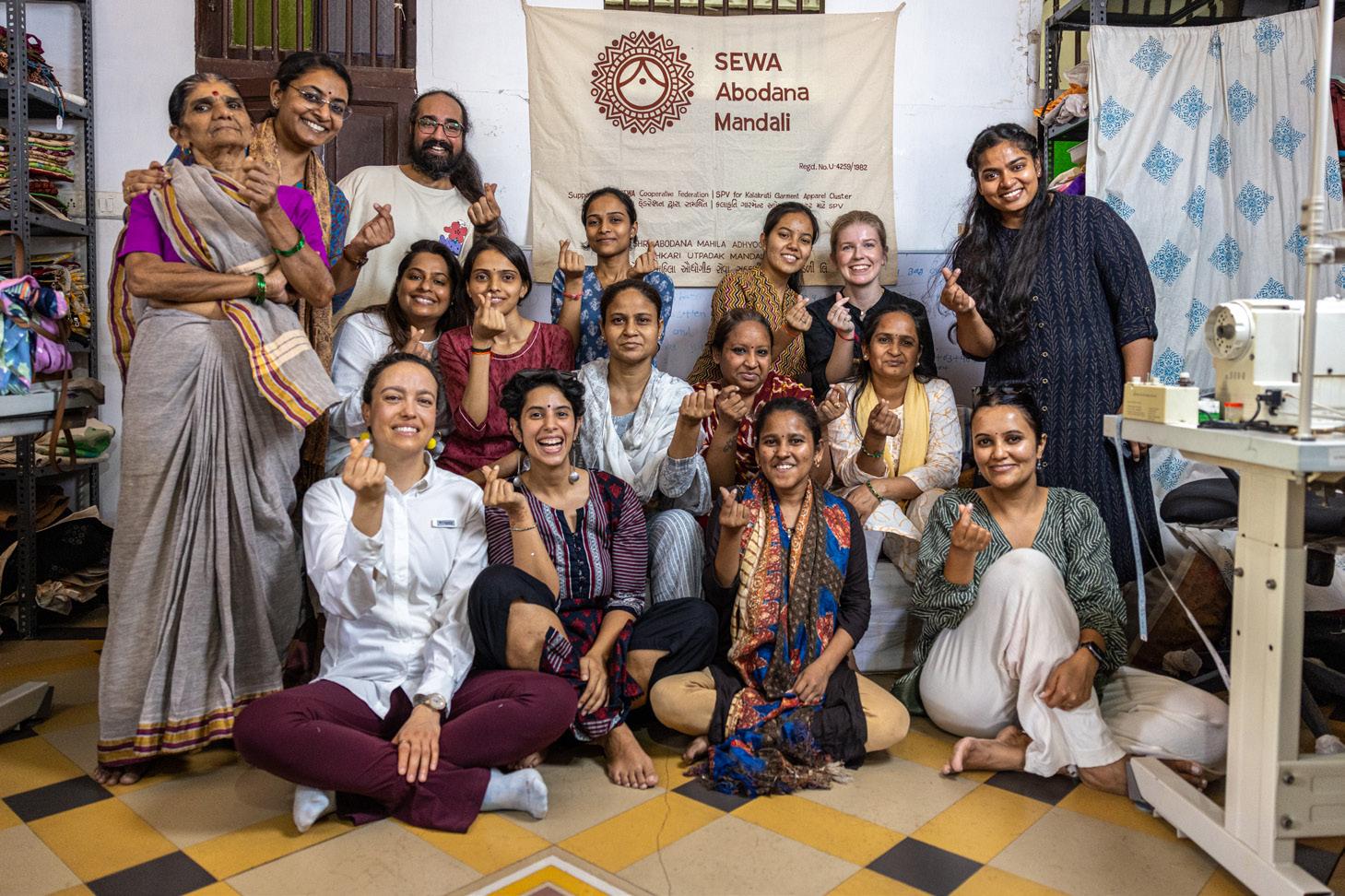
On-site with the Self Employed Women´s Association, who participated in the Better Diamond Fund Leadership for Growth training program offered by Breitling in cooperation with Global Good






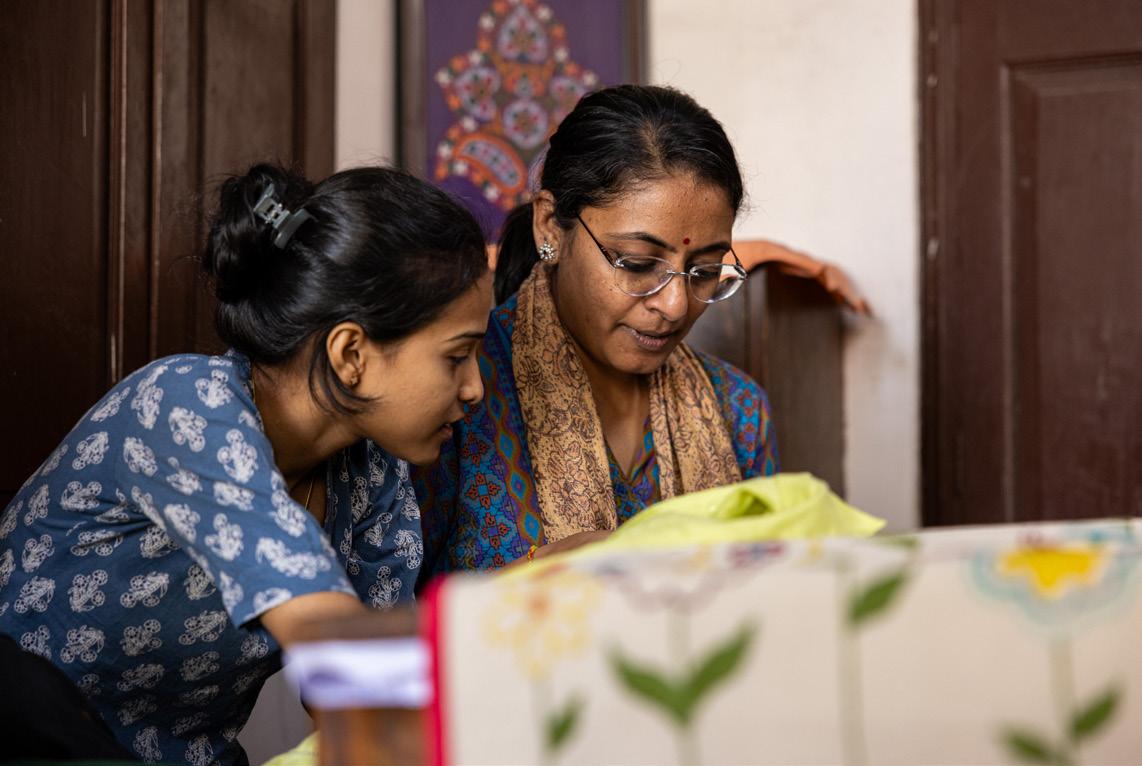





Breitling has been a member of the Swiss Better Gold Association since 2020. Together with the Association and all our supply chain partners across the value chain, we have been able to be a part of supporting meaningful community development activities in local communities. Most recently, we have been proud to witness the graduation ceremony of students in the education program developed in the village of the Vereda El Pescado in Colombia. This was the location of the Touchstone mine from which we sourced gold in 2021 and 2022 and have continued to support through disbursals from the Better Gold Fund in the years that followed.


Through its strong on-theground presence, SBG supports responsible artisanal, small-, and medium-scale gold mining, aiming to create positive social and environmental impact in mining areas and surrounding communities. Communities are key to achieving SBG’s mission. We work to build trust with local communities and understand their priorities, particularly through the elaboration of social and environmental projects. In 2024, SBG invested USD 940,644 of impact premium in 22 technical, social, and environmental projects in Colombia and Peru, reaching 8,548 direct beneficiaries.
CHRISTIAN SIEBER PROGRAM DIRECTOR, SWISS BETTER GOLD


What does education mean to you and to the development of your path in life?
Thanks to this project I have had the opportunity to continue my academic education, which has represented a very significant change in my life. In addition the larger project has had a profound impact on my community, since many people have been able to improve themselves and achieve their personal and professional goals.
This project motivated me to resume my studies and encouraged me to continue my professional development. Thanks to this experience I have understood many things that I did not know before, and now I have the desire to continue my education in the area of administration.
Thanks to this project, not only I, but an entire community, has benefited from new knowledge and values. It allowed many young people, who had already discarded the possibility of continuing their studies, to retake our dreams and advance further than we had imagined.
What is your perspective on the next steps in your education?
I imagine a prosperous future, full of learning and opportunities. My goal is to continue growing, improving every day and acquiring new knowledge that will allow me to advance both personally and professionally. In the near future, I would like to pursue a university degree and become a professional in the area I am passionate about.
What could you tell others to continue on their own educational path?
That what really defines the value of a person is the level of knowledge they possess and that it is never enough with the little we know, you should always invest and take advantage of your time and intelligence in acquiring knowledge and higher education.
What does sustainability mean to you and your community?
For me, sustainability refers to the capacity we develop to face our challenges autonomously, building a model of life in which economic, social and environmental well-being are integrated in a balanced way. It is the ability to satisfy our present needs without compromising the possibilities of future generations, promoting a harmonious and responsible development.
Thanks to this project my future has changed. Without the work that Catalina, the Swiss Better Gold local counterpart, does every day to fight for the education of the village and empower the leaders many people would not have achieved this dream.

To our understanding to date, the communities with particular characteristics that may be at greater risk of harm concern those related to gold sourcing, particularly extractive activities, and less so processing activities, along with the local producing communities in Switzerland, which in some cases are heavily reliant upon the watchmaking industry.
Our engagement with affected communities is governed by the principles outlined in our ESG Policy, which is applicable to all relevant areas of engagement. Further relevant governance topics are outlined therein according to ESRS 2 MDR-P Policies. We regularly update our ESG Policy, which is publicly available at Breitling.com, to reflect best practices and our intention to achieve these in our actions. These include the following: We strive to engage with representative groups of community members, including vulnerable groups. Where possible, we engage before a business relationship commences and continue this over the course of the business relationship, most typically at a frequency of annually to biennially for on-site visits and more frequently, as often as monthly, or on a quarterly basis or other frequency which best supports the engagement. We also work to establish monitoring and evaluation methods to assess progress on sustainability and the impact of expenditures in the case these are disbursed. The functions and most senior roles within Breitling that has operational responsibility for ensuring this engagement happens and informs Breitling strategy is the chief operations officer and the chief sustainability officer. Further details of our efforts to engage affected communities are available in each of our past annual sustainability mission reports.
Key ongoing deliverables to affected communities includes a range of tailored capacity building activities within our ASGM gold supply chain, in collaboration with the Swiss Better Gold Association and funded by the Breitling Better Gold Fund. In the reporting cycle, our funding of a tailored community education program came to its foreseen conclusion, with engagement with local authorities to continue this educational provision based upon the foundation which was created. In our lab-grown diamond supply chain in Western India, the ongoing disbursal of the Better Diamond Fund continues to support social impact leaders and their work with
affected communities across a range of factors including women’s economic empowerment, childhood education and environmental protection, among others.
These measures, particularly those related to training value chain workers, and those that can contribute to resiliency in affected communities, are a key aspect of our efforts to mitigate both the material impacts and risks that communities may face as well as those to which we are exposed in our reliance upon them through our interdependencies. When identifying necessary and appropriate action in response to an actual or potential negative impact, we may rely on assessments conducted by specialists with close contact with the affected communities and input from community members. In order to assess the effectiveness of processes established in response to a negative impact, we work with local implementing partners to establish relevant monitoring and evaluation protocols.


We actively engage with communities globally, both within and beyond our supply chain. To complement our work with communities along our value chain, we also engage with a select number of organizations globally. Through these highly valued partnerships, we can further contribute to shared prosperity and expand our sphere of influence on areas related to social and environmental sustainability and be a part of broader systemic change.
Surfrider Foundation and Climate Impulse have been crucial to this mission. The Surfrider Foundation is dedicated to the protection and enjoyment of the world’s oceans, waves, and beaches for all people. Through its focus on plastic reduction, ocean protection, beach access, coasts, nature, and clean water, it works to protect our coasts with its powerful network. Climate Impulse, led by our ambassador Bertrand Piccard, is an ambitious project aiming to achieve the first non-stop, zero-emission flight around the world using a hydrogen-powered airplane. Both organizations contribute to shared prosperity through partnerships that drive meaningful change.
On the next pages, we are proud to share their personal stories, in the hope that they can be as inspiring to you as they have been to us.
Since 2024, we have supported the Swiss Fund for Quality Journalism in Switzerland and have continued our efforts during this reporting cycle. This initiative has primarily contributed to an educational program at the Neue Zürcher Zeitung focusing on data competencies and promotion of young journalist talents, as well as support for journalism education, a journalism award, practical business education programs and media quality research. In an era marked by growing prevalence of misinformation, we consider the promotion of quality journalism to be an integral component of our community-based engagement.
OUR GLOBAL AND LOCAL AMBASSADORS ARE A DIVERSE ARRAY OF TRAILBLAZERS. EACH INDIVIDUAL BRINGS A UNIQUE BLEND OF SKILL, STYLE AND AUTHENTICITY.

CHARLIZE THERON
CHARLIZE THERON AFRICA OUTREACH PROJECT

Who are my key allies in building a sustainable future? What’s the secret to the magic in our mission?
For CTAOP, our key allies have always been young people, the incredible grassroots organizations, and other community leaders already doing the work that is needed here and now in their communities. They know the challenges best and know what solutions most make sense and will create lasting change. They are the catalysts in their communities and our job is to be learning partners, supporting them in as many ways as we are able - from funding they can rely on and use where they need, to convening for connecting and power building to bringing their voices and stories to light. We bring different pieces to the puzzle. Being able to fit them together is key to achieving progress towards our mission.
When I think about what a sustainable world could look like in five years, what does this look like?
I believe that the world has a long way to go to be fully sustainable but with a lot of people making small changes we can make a difference.
What is one thing I do in my private life and one thing in my professional life that contributes to this vision?
In my personal life we drive an electric vehicle and have solar panels on our property. In my professional life all of our tcb branded products are fully sustainable, biodegradable and recyclable.

What is something that I wish I could do better to contribute to this mission and if you could have sustainability power, what would it be?
I am aware of my travel footprint when racing around the world but always try to offset wherever possible. I would therefore choose to travel with no carbon footprint.


GIANNIS ANTETOKOUNMPO CAFF
When I think about what a sustainable world could look like in five years, what does this look like?
To me, a sustainable world in five years is one where every community — no matter where you come from — has access to clean water, healthy food, and safe spaces for kids to grow and dream. It’s a world where businesses, athletes, and everyday people understand that we all have a role to play, and where small actions from many people create big change for the planet and for future generations.
What is one thing I do in my private life and one thing in my professional life that contributes to this vision?
In my private life, I try to teach my kids about appreciating nature — taking them outside, showing them how to respect the environment, and reminding them not to waste. Professionally, through my foundation, we focus on creating opportunities for young people, especially in under-resourced communities. I believe investing in kids is investing in a more sustainable future — because they will be the ones leading it.
What is something that I wish I could do better to contribute to this mission?
Honestly, I wish I could slow down more and learn from people who are experts in sustainability. I’m still growing in this space. Whether it’s understanding how to travel in a more eco-friendly way or how to build programs that not only help people today but protect the planet for tomorrow — there’s always more I want to learn and do better.

Who are my key allies in building a sustainable future? What’s the secret to the magic in our mission?
My family is always my first team — we push each other to think bigger and do better. But I’ve also been inspired by partners like Breitling, who use their platform to stand for something beyond just product. The magic happens when people with different talents come together around shared values — when it’s not about ego, but about impact.
If I could have a sustainability superpower, what would it be?
If I could have a sustainability superpower, it would be the ability to instantly give every child in the world access to clean drinking water. Water is life. So many dreams never get started because basic needs aren’t met. If we can make sure every kid has clean water, we unlock potential everywhere.


When I think about what a sustainable world could look like in five years, what does this look like?
It would be a world of efficiency, where we would achieve more while consuming less. As a big difference with today’s world, the sustainable world would stop wasting 70% of the energy produced, 40% of the food, more than 80% of all raw materials. It would be a world of circular economy where we would also stop wasting waste and rather use them as a resource.
What is one thing I do in my private life and one thing in my professional life that contributes to this vision?
Not only one! I live in a fully insulated house, with a heat pump and solar panels, and I drive an electric car. In my non-profit Solar Impulse Foundation, my team has selected and labeled more than 1,600 technical solutions that are economically profitable to protect the environment. I spend my life motivating corporations and governments to replace their old and polluting systems and infrastructures with these clean and efficient solutions.
What is something that I wish I could do better to contribute to this mission?
I wish I could compress the timeline between awareness and action. To do this, sustainability must be made much more exciting and appealing. This is why I have launched a new project, Climate Impulse, to achieve the first round-the-world flight, non-stop and without any polluting emissions. It will be with a green hydrogen airplane which is currently under construction. Breitling is the official partner of this adventure, supporting me since 1992 in my endeavors.
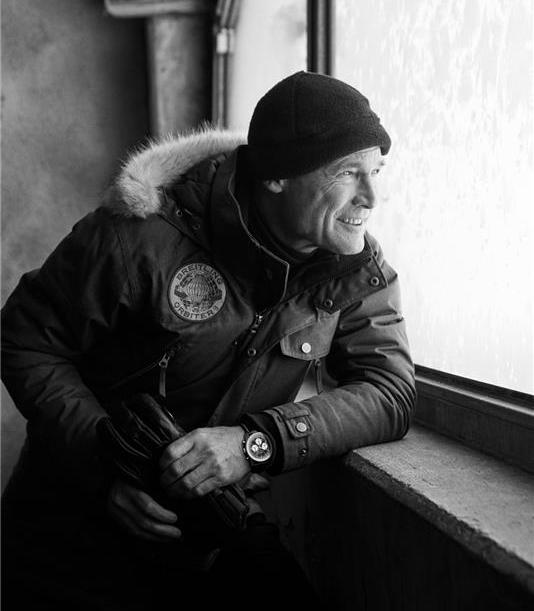
Who are my key allies in building a sustainable future? What’s the secret to the magic in our mission?
My allies are the changemakers—the innovators, entrepreneurs, policy shapers, and young people who dare to think differently. And in particular the partners and sponsors who are supporting the Solar Impulse Foundation. My mission would never be successful without the corporates, public entities and philanthropists who believe in sustainability and give me the means to run a 35 person team of passionate and dedicated members.
If I could have a sustainability superpower, what would it be?
I would choose the power to instantly change mindsets and make every leader, every citizen, more respectful and compassionate for other living beings on Earth. I would also make them understand that ecology and economy are no longer enemies, that sustainability is not about less, it’s about better. If people could experience, just for a moment, the excitement I feel when I see what’s possible, the world would transform much faster. Everyone would see how protecting the environment can also be a source of profit for the industry thanks to new market opportunities.


KELLY SLATER OUTERKNOWN
When I think about what a sustainable world could look like in five years, what does this look like?
It would be amazing for every city to have proper recycling bins for various trash split into food/ compost, landfill waste, plastics/recycling, and for us to know our efforts are taken seriously by local, state and federal governments so that our individual efforts are going towards a great cause for the whole of society. Obviously, our world’s energy needs are not getting lighter so a focus on a complete overhaul to a hydrogen-based solution would be great. With the ocean we have an endless and free supply of hydrogen available. I have friends who are totally set up running cars and houses on hydrogen, but it has yet to make its way into proper infrastructure for society.
What is one thing I do in my private life and one thing in my professional life that contributes to this vision?
In my private life I am constantly sifting through my garbage to split and separate garbage from recycling. I never know if my efforts are productive on the other end but I’m very thorough on doing this and inspired my mom and stepdad to do the same recently. I do my best in public life to give credence and exposure to organizations that offer great solutions for environmentally sound causes. Cleanup efforts in various places I travel to, reliable people who dedicate their lives to keeping our planet going in the right direction. I often get overwhelmed with the amount of trash and waste we as a society produce. The oceans are full of plastics and garbage at an astounding level. Having a public voice is worthless if you don’t put it behind a good cause. As for the hydrogen efforts, I hope to run my future car and boat and house off of this fuel.

What is something that I wish I could do better to contribute to this mission?
I’d like to see a worldwide network of all these organizations working in unison. So, if I had the free time to create that and the ability, I feel it would be a great cause and source for people.
Who are my key allies in building a sustainable future? What’s the secret to the magic in our mission?
I believe the key allies are going to be the next generations and also a network into the business sector to make this a financial windfall somehow. It will take smart people who can see solutions instead of emotional responses to link all of this together I believe.
If I could have a sustainability superpower, what would it be?
It would be to engineer waste of all sorts back into useful products or bio matter. If you could revert the chemistry back to original form with a superpower that would be a handy solution to many of our environmental problems.


AND NOW OVER TO YOU - TELL US YOUR STORY. WE LOOK FORWARD TO SHARING YOUR INSPIRATIONS IN THE 2026 SUSTAINABILITY MISSION REPORT.
When I think about what a sustainable world could look like in five years, what does this look like?
What is one thing I do in my private life and one thing in my professional life that contributes to this vision?
What is something that I wish I could do better to contribute to this mission?
Who are my key allies in building a sustainable future? What’s the secret to the magic in our mission?
If I could have a sustainability superpower, what would it be?


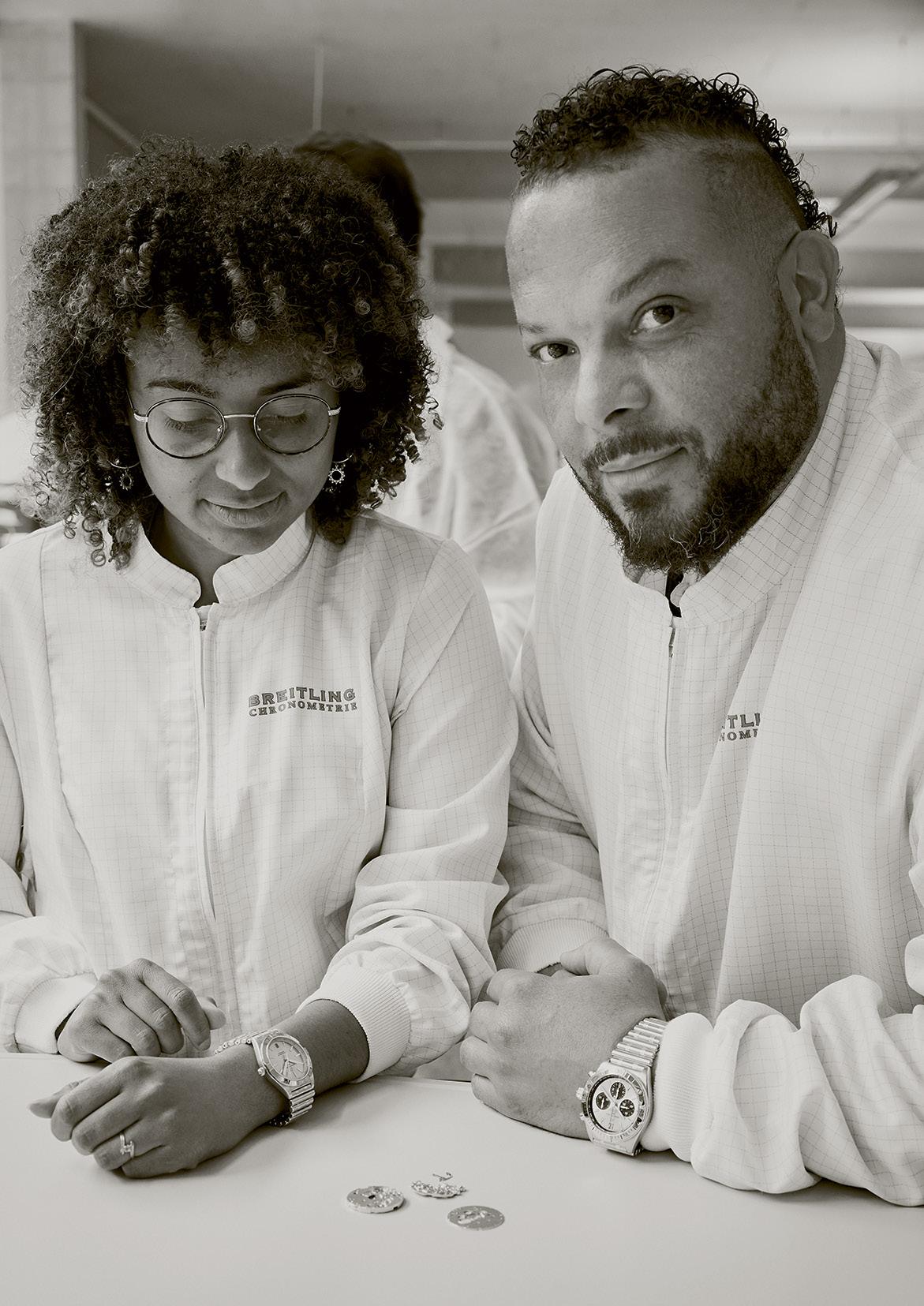
At Breitling, we recognize that our own workforce is central to our ongoing success and growth. We are proud of the positive impact we have made in fostering a supportive and dynamic work environment. This commitment is evident in the external recognition we have received in the current reporting cycle. The following sections detail the efforts we have made and the resources we have invested to continue advancing a workplace where our employees can thrive.
Our worldwide Squad is active in 27 countries
Our worldwide Squad by type of role

Breitling has been recognized as a Top Employer in Switzerland for the third consecutive year by the top Employers Institute. This certification follows a comprehensive internal audit of our processes guidelines, and practices, reinforcing our commitment to providing a positive work environment where our employee community can reach their full potential. Furthermore, Breitling has been recognized as the #1 Best Employer in Switzerland’s Watches and Jewellery sector for 2025, based on an independent survey conducted by Statista, PME, and Handelszeitung. These recognitions reflect our ongoing efforts to fostering a positive company culture, emphasizing inclusivity, sustainability, excellence, and performance while also acknowledging the efforts and contributions of our squad. While we value these achievements, we continue to focus on further developing the skills of our people, embracing innovation, and maintaining the values that define Breitling as a workplace.
We are committed to upholding principles of equal pay and fairness, which are integral to our employment policies.
This year, we conducted a salary analysis across 1,956 employees in 25 countries, considering factors such as location, job grade, and function. The outcome revealed an adjusted pay gap of less than 1%, underscoring our dedication to fairness. Achieving this requires regular salary benchmarking, supported by our global HR system, which ensures transparency and accessibility of relevant data.
These efforts have earned us the “Universal Fair Pay Developer” award from the FPI Fair Pay Innovation Lab, making Breitling the first company in the watch industry to receive this recognition globally. This award highlights our progress toward gender equality, not only in pay but also workplace culture. We remain committed to ensuring that all employees receive equal pay for equal work, regardless of gender.
Entrepreneurship and strive for performance are key values of our corporate culture. Our shareholders have invited key managers and all employees to become shareholders and to invest privately-held own funds in respective investment programs which carry an attractive return for future value created, thereby aligning the long-term growth interests of our main shareholders with those of our employees. In the 2025 reporting period, a total of 244 employees representing 12.7% of all full-time employees globally were active investors into Breitling.




As part of our 140th anniversary celebrations, Breitling has been hosting field trips to our Pop-Up Museum in Zürich with guided tours through the exhibition. This immersive space, dedicated to celebrating craftmanship and innovation of Breitling watchmakers, has welcomed over 300 members of our Operations Squad. These visits have been a unique opportunity for our employee community to connect to our heritage and explore iconic timepieces, milestones, and stories that have shaped Breitling for over a century.
Furthermore, to mark the occasion of Climate Week, we have launched the Breitling Global Plastic Challenge in September 2024. Employees were asked to test their knowledge in an interactive quiz on global plastic consumption, plastic pollution, and our own efforts related to plastic waste reduction. Our Squads around the world were invited to participate in the challenge and participated with their families, making it a great learning experience for everyone. A total of 170 Squad Members participated in the challenge, with the top five scorers receiving an exclusive invitation to an Ocean Collage workshop. This workshop focuses on raising awareness of ocean-related issues and environmental impact of our activities, while also providing actional insights for positive change.
At the start of 2025, we continued our sustainability house tour, a fundamental stakeholder engagement initiative at our headquarters, covering over 200 employees across our manufacturing sites in Switzerland. With the objective of engaging our employees, developing department-level action plans and maturing the sustainability theory of change at Breitling, we facilitated workplace dialogue sessions in small groups. During these sessions, we were able to raise awareness across an array of sustainability topics, gain insights on the understanding of sustainability, and more importantly, co-create proposals on how to improve sustainability on a workshop, department and company level. So far, we have collected 180 proposals showing the great interest of our squad members in participating in our mission. Each proposal is addressed, and feedback is provided on the progress of each proposal being implemented. With the 2025 sustainability house tour we used the opportunity to return to our manufacturing sites to share progress on the proposal they have shared in the previous year.
By conducting this fundamental engagement, we are able to continue our efforts for sustainability engagement. We are working to expand this effort globally within the ongoing reporting cycle.


We have advanced our efforts to engage employees in sustainability through a team-based transformation approach. Our sustainability transformation is tailored to each team at Breitling, delivering an efficient and empowering approach to embody sustainability in our daily actions and philosophy. Firstly, we seek open dialogue with teams through informal discussions on sustainability. The main objective is to listen to team members about challenges and opportunities, building trust and facilitating an ongoing, meaningful and open exchange. The next step is to raise awareness and build sensitivity through online sustainability training where individuals can learn at their own pace. Then, we invite the teams to regroup to share learnings, ideate and agree on actions to integrate sustainability into individual and team work projects and ways of working. As a fourth step in the team-based transformation we aim to embed sustainability in team spirit and culture through the organization of a sustainability-related team event that builds team spirit and embeds sustainability culture.
We launched this initiative with a pilot team, our Product Team – and have gained valuable insights into fostering engagement and collaboration. We will continue to expand this approach and transparently document our progress on sustainability engagement.


It was inspiring to see our company‘s commitment to sustainability being brought to life, with our recommendations actively put into practice with meaningful impact for plastic waste reduction, climate action and more. Participating in the sustainability tour was a positive experience that motivates us to pursue these efforts for our future.
ERIC VALLEY QUALITY TECHNICIAN

As part of our commitment to fostering leadership and empowering our team members, we recently held a leadership training program for our Operations Squad in Switzerland, providing opportunity for growth and development through a 10-module program taking place over five months, from October 2024 until February 2025 designed to provide participants with key leadership skills and knowledge and was created and executed entirely in-house.
Each module focuses on developing transferable skills to enhance participants’ leadership capabilities. By the end of the program, participants reported an

increased sense of confidence in their leadership abilities and felt more prepared to implement changes within their teams. The training followed a structured framework based on the core principles of LEADERSHIP: Learn, Empower, Adapt, Decide, Encourage, Respect, Strategize, Honesty, Inspire, and Persevere. These principles guided the program and aimed at strengthening leadership foundations.
Feedback from participants highlighted the program’s effectiveness, with evaluation scores reflecting high levels of satisfaction with 88% for overall content, 94% for training facilitation skills, and 84% for the program’s duration.
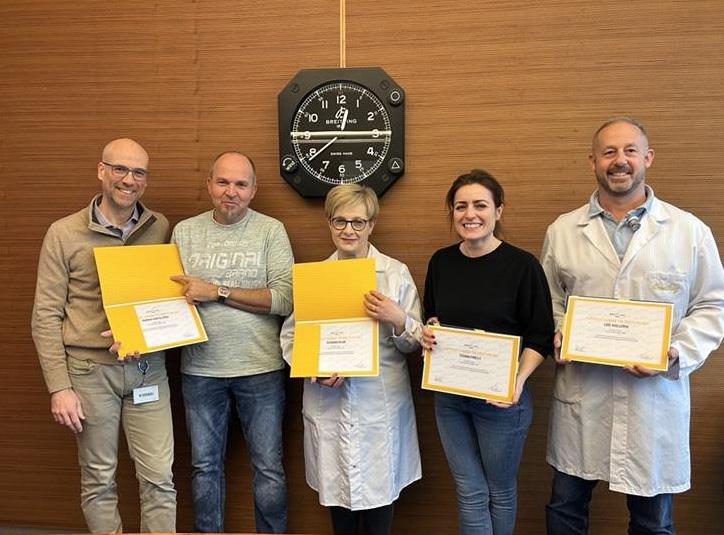
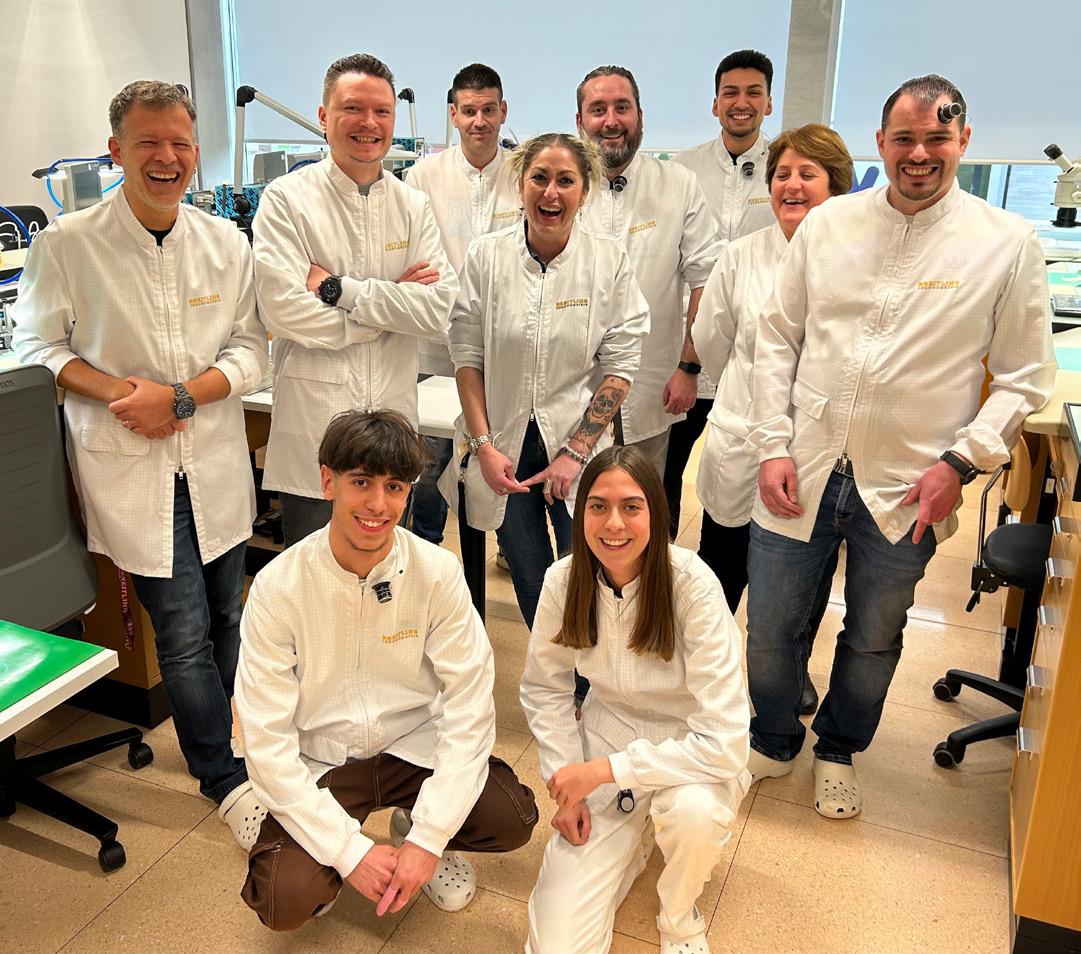
BY ALIGNING WITH EVOLVING MARKET NEEDS AND ACADEMIC ADVANCEMENTS, WE CONTINUE TO ATTRACT, DEVELOP, AND RETAIN THE NEXT GENERATION OF TALENT

At Breitling, we remain committed to investing in the future by expanding our Young Talent initiatives. This year marks an exciting milestone as our first two watch operator apprentices graduate, making way for two new apprentices. Currently, we are training four apprentices in this role, the first steps in developing a steady pipeline of skilled professionals.
Beyond watch operations, our commitment extends across various departments. We have three apprentices gaining hands-on experience in our Swiss boutiques and five more in the commerce division at our headquarters. As we continue to diversify our apprenticeship offerings, we are proud to announce a new partnership with Centre d’Apprentissage de L’Arc Jurassien (CAAJ), a school dedicated to supporting companies in delivering foundational technical training. Through this collaboration, we have introduced two additional apprenticeships: Micromechanical designer and micromechanic.
Our expansion does not stop there. We recently obtained authorization to train IT specialist apprentices, with one trainee being placed at each of our sites in La Chaux-de-Fonds and Grenchen. Our internship technical programs have evolved to accommodate vocational training interns from international schools as well as national schools.
As part of our commitment to workplace education and professional integration, we have strengthened our partnership with the Battenberg Foundation—a bilingual socio-economic enterprise dedicated to supporting individuals facing health challenges or employment reintegration. Through this collaboration, we proudly host one intern per year, providing meaningful training opportunities that align with our values of inclusivity and professional development.
Meanwhile, our Operations Squad continues its highly successful Master of Science internship program, hosting six engineering students annually. These interns contribute to a wide range of strategic projects, from lean manufacturing initiatives to MRP data migration, strengthening our innovation-driven approach.
Breitling’s investment in young talent extends internationally as well. In the UK, our division sponsors a watchmaker attending a WOSTEP-affiliated school—a Swiss foundation supported by the watchmaking industry. In France, we currently host three interns across retail, finance, and marketing, while in Germany, three apprentices are undergoing watchmaker training.
These strategic partnerships—both at our headquarters and across international markets—are instrumental in fostering a diverse and future-ready workforce. By aligning with evolving market needs and academic advancements, we continue to attract, develop, and retain the next generation of talent, reinforcing Breitling’s position as a leader in both the educational and industrial landscapes.
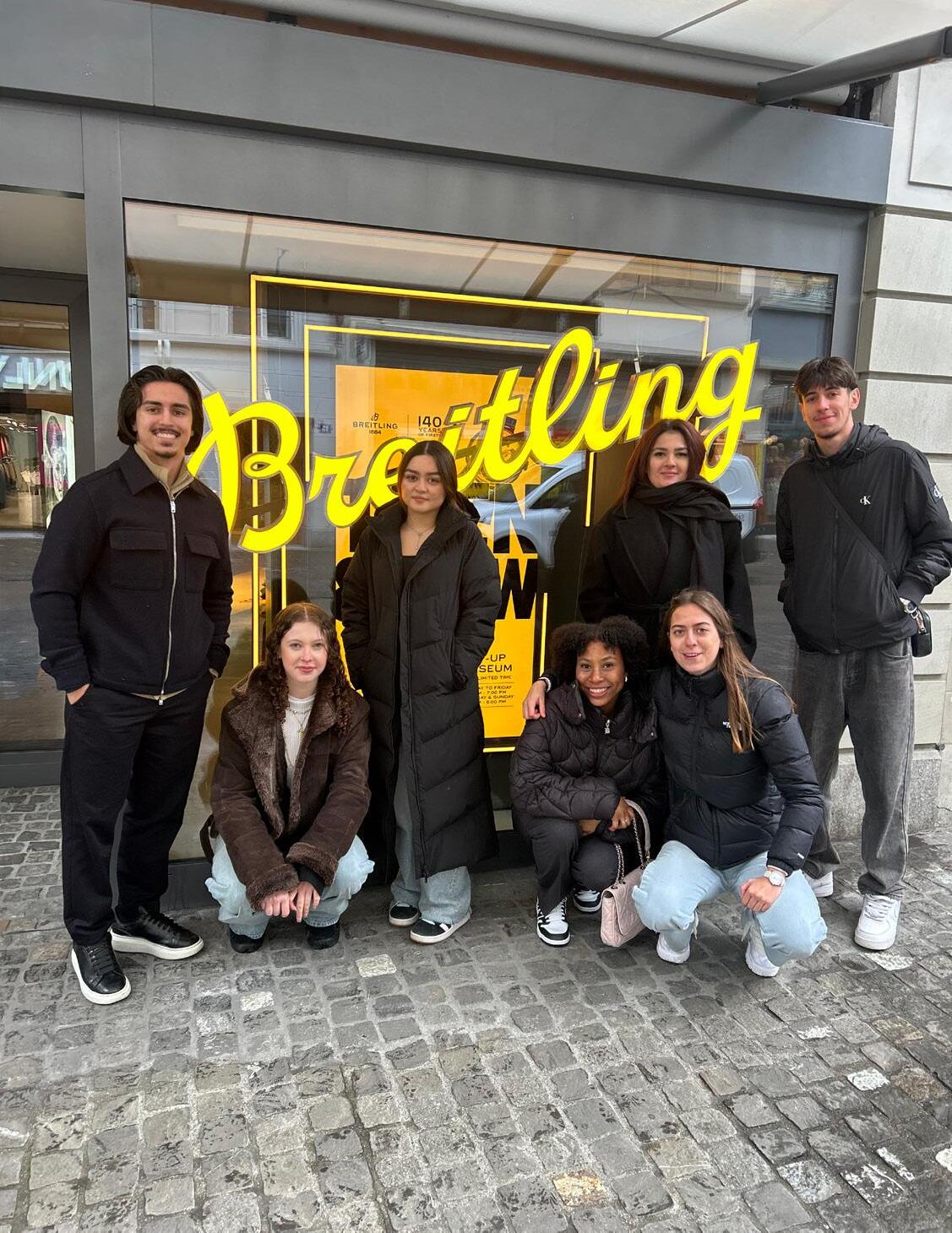

In alignment with the European Sustainability Reporting Standards (ESRS) and more specifically ESRS S1 Own Workforce, we report annually on the quantitative data related to workforce composition, health and safety, and related metrics. The information is structured
INDICATOR
Headcount of employees by geographical areas
Total number of employees by head count (HC), and breakdowns by gender and by country for countries in which the undertaking has 50 or more employees representing at least 10% of its total number of employees
to meet the requirements established by the Corporate Sustainability Reporting Directive (CSRD) to ensure transparent and consistent reporting.
Total number by full time equivalent (FTE) of permanent employees, and breakdown by gender
EMEA: 1284
APAC: 391
AMR: 305
Total HC: 1980 (Switzerland 725, USA 265, UK – 123, Germany – 96, Japan – 101, Shanghai - 108, France 93, Others – 469.)
1917.9 FTEs
Female: 883.0
Male: 1034.9
Non-binary: Not recorded
EMEA: 1284
APAC: 391
AMR: 305
Female: 926
Male: 1054
Non-binary: Not recorded
EMEA: 1242
APAC: 377
AMR: 270
Total HC: 1889 (UK – 120, Germany – 97, Japan – 96, Shanghai - 95, France 94, Others – 438.)
1827.8 FTEs
Female: 857.1
Male: 970.7
Non-binary: Not Recorded
EMEA: 1242
APAC: 377
AMR: 270
Female: 902
Male: 987
Non-binary: Not Recorded
Total number by full time equivalent (FTE) of temporary employees, and breakdown by gender
Total number of employees who have left the undertaking during the reporting period and the rate of employee turnover in the reporting period
Total number of non-employees
68.3 FTEs
Female: 33.3
Male: 35.0
Non-binary: Not recorded
217 voluntary leavers (206.7 FTEs)
Employee turnover rate: 10.8%
69.4 FTEs
Female: 37.2
Male: 32.2
Non-binary: Not Recorded
205 voluntary leavers (198.9 FTEs)
Employee turnover rate: 11.2%
in the EEA
The percentage of employees outside the EEA covered by collective bargaining agreements
Gender distribution in number and percentage at top management level
Female: 36% (157)
Male: 64% (280)
Total 437
Female: 30%
Male: 70%

19.5% (FY23)
All countries with 50 employees and more were included. As non-binary and further genders are not yet offered as an automated selection option in the software platform used by Breitling, these are not yet recorded (please note: this applies to all metrics concerning gender).
34.5% in mngt positions (FY23)
Number of voluntary leavers divided by average FTE of the reporting period. Voluntary leavers are defined as employees who hand in their resignation on their own will. This excludes all companyinduced termination.
Ratio of women in management positions to the total of management positions. In the past year we have made strong progress towards this target, which is now retired. Moving forward we will continue to implement our approach to ensuring a discrimination-free workplace.

INDICATOR
Distribution of employees by age group <30: 357
1259
364
355
1142
392
Percentage of employees that participated in regular performance and career development reviews
Average number of training hours per employee and by gender NA NA
Percentage of our employees covered by the health and safety management system based on legal requirements and/or recognized standards or guidelines
Number of fatalities as a result of work-related injuries and work-related ill health 0
Number and rate of recordable work-related accidents
Number of days lost to work-related injuries and fatalities from work- related accidents, work-related ill health and fatalities from ill health
of employees entitled to take family-related leave

<25: 4.7%
25–34: 28.5%
35–44: 25.7%
45–54: 27.6%
55–64: 13.0%
>65: 0.6% (FY22)
FY24
NA
Age groups adapted to respond to ESRS disclosures.
It is in Breitling’s annual objectives and processes that 100% of its employees participate in at least two performance and career development review cycles, one at half and one at full financial calendar year.
This is an important topic for Breitling and tracked through the following metric which can be found at the beginning of the chapter: 31% of the Breitling workforce are active learners by end of FY24.


The Breitling Super Chronomat 38 with traceable lab-grown diamonds
Understanding and meeting the expectations of our highly valued customers is vital to our shared success. The material topic ESRS S4 – Consumers and End-Users ranks highest for financial materiality in our assessment to date among all topics, and of very high impact from the perspective of impact materiality, representing the key role played in our business success and our impacts on society. Customers have participated in our biennial double materiality assessment, conducted in the prior reporting cycle and detailed in our 2024 Sustainability Mission Report. This is one way in which customer perspectives are considered to inform the development of corporate and business strategy. Key topics raised by this stakeholder group include maintaining high service standards and appropriately anticipating consumer demands regarding product sustainability attributes.
We first integrated customer input into our sustainability strategy already at the outset of the formalization of our efforts in 2020 when we conducted our inaugural double materiality assessment. Following this, perspectives directly contributed to the development of new product lines, namely the Super Chronomat 38 Origins which was first released in 2022 and was our first product to be conceptualized from the starting points of sustainability and traceability.
These products accounted for a 5% share of our overall female product line sell-out in the FY23 reporting cycle to one-quarter in the current reporting cycle, FY25, and we are well on track to achieve our target of full integration by the end of the ongoing reporting cycle in March 2026. The focus for the products is currently placed on the female line, as the integration of these materials has occurred first primarily on products within female product lines, which more prominently feature lab-grown diamonds and/or gold. We will continue to closely follow uptake in the marketplace to consider the reception of these and their relevance.
We work to strengthen our customer relationships in several ways and in the reporting cycle, we have taken significant steps to improve our approach to customer engagement. This includes the hiring of our inaugural chief customer officer, who is the most senior person within Breitling responsible for ensuring that customer feedback is informing our business strategy. This important role is working to achieve our vision to bridge craftsmanship, ambition, and people to drive sales and loyalty through a seamless direct-toconsumer ecosystem—delivering experience and products with care and excellence following our objective to become the leader of neo-luxury.
To this end, our mission is to integrate customer relationship management (CRM), retail, training, e-commerce, website, data analytics, and call centers into a powerful engine that drives growth, optimizes customer experiences, and fosters lasting engagement through data-driven strategies and passionate teams. These efforts will allow us to fulfill our purpose of optimizing each direct-to-consumer interaction, thereby accelerating sales, strengthening brand loyalty, and driving sustainable growth. Our empowered, passionate, and highly skilled teams will continue to be the cornerstone of our success, ensuring an unmatched experience at every customer touchpoint.
In the ongoing reporting cycle, we will be working to integrate each direct to consumer (DTC) touchpoint as one continuous system that creates a frictionless customer journey. As a local brand, we will adapt our approach to local market needs while staying true to the brand’s global direction.
From the perspective of sustainability, numerous events have taken place in local markets to more closely engage the customer on this key pillar of neo-luxury, in which we strive to be the global leader. Some of the key events in this regard include the following listed on the next page.

In Vienna, we joined our brand ambassador, Charlize Theron, at the 4Gamechangers festival in May 2024. During the event, Breitling held a frontstage keynote presentation on our efforts related to sustainability during which we reached an audience of 15,000 both in person and on the related television distribution. Following this, we held an event at our Vienna boutique for customers and special guests, where in an intimate setting of 30 attendees we held a deep discussion on sustainability over the course of the evening, going into detail about our sustainability objectives and the efforts being made together with our communities across the globe.
In Stockholm, we gathered a group of key customers and media representatives for a dedicated afternoon discussion about sustainability in May 2024. Over the course of the summer, we prepared with our colleagues in Japan a first-of-its-kind dedicated sustainability display at the Hankyu Umeda department store in Osaka, Japan. We were invited to exhibit by our esteemed colleagues at Hankyu Umeda in recognition of our commitment to and tangible actions related to sustainability. We took this opportunity to engage visitors on the topic of

sustainability, telling key stories on our efforts with a multimedia display. This focussed on our efforts related to traceability and responsible sourcing, nature protection and climate action. We also used the opportunity to engage visitors, asking them as well to make their own commitment for sustainability and to write this on a blackboard, making it visible to strengthen their buy-in.

Further events followed at our flagship boutique on Madison Avenue in New York City during Climate Week in September 2024, for which we hosted an evening reception for customers and attendees of Climate Week in which we facilitated an in-depth discussion on topics related to sustainability. This event followed several at which we presented our efforts during Climate Week. Later in 2024 in Amsterdam at our Hooftstraat boutique, we convened a group of media stakeholders and customers for an exchange on sustainability across our key topics of community, nature and governance.
In addition to these events specifically tailored to engage our customer community, we have been present at several prominent events globally to contribute our perspective and vision on sustainability. In the reporting cycle, we also celebrated our 140th anniversary. To commemorate the occasion, we established a pop-up museum on the famed Rennweg in Zurich. Throughout the presence of the pop-up

museum, we hosted several events related to sustainability, each hosting 30-50 guests for an intimate and engaging discussion around the history of women in watchmaking, the approach taking by Breitling with regards to responsible sourcing, and a range of other topics.
We take the time and effort to regularly engage in meaningful dialogue because we view these efforts as both a responsibility – using our voice to raise awareness on sustainability – and an opportunity for the brand to engage current and new community members alike.

This POP UP event focused on Breitling’s sustainability initiatives, particularly its use of lab-grown diamonds. It was more than just a sales effort—it served as a meaningful opportunity to promote a sustainable mindset. We heard that many visitors were either new to the brand or not previously interested in watches. Therefore, we believe this initiative not only raised brand awareness but also helped convey the importance of environmental responsibility.
YOSHIHIRO NISHIJIMA CONTENT DEVELOPMENT DEPARTMENT
BUYER – NEIGHBOR FOOD LIFE / EVENT PLANNING
HANKYU DEPARTMENT STORE, INC.



From the moment someone enters our brand universe, no matter what their journey to us has been, we embrace them as part of our community. Every interaction reflects our commitment to care, include and connect. We don’t just serve customers, we build long term relationships, designed to stand the test of time, just like every timepiece we create.
GAELLE DEVINS BREITLING CHIEF CUSTOMER OFFICER


I have been with Breitling seven years, and the most rewarding part of the journey has been the vibrant community. What began as a shared passion for Breitling watches has evolved into lasting connections with incredible individuals from around the world. Together, we’ve grown a network of over 10,000 members who contribute knowledge across diverse fields, creating a community that transcends timepieces and feels like family. Our annual global gatherings are a highlight—an opportunity to reconnect, celebrate personal milestones, and discuss everything from sustainability and exciting new releases to life itself. What started as a family business in 1884, is still felt in the hearts of people at the company today, shaping the way we connect and grow together.
SAYEEF KHAN NEW YORK MADISON AVENUE BOUTIQUE ASSISTANT MANAGER





We support resilient ecosystems by contributing to climate risk mitigation, nature regeneration and plastic waste reduction to protect our business outlook and advance global best practice.
Achieve Carbon Disclosure Project (CDP) A list status in Climate by end FY28 and end FY30 for Water and Forests
Establish Science Based Targets for Nature across the value chain by end FY26
Reduce Scope 1 and 2 emissions by 80% by FY32 from an FY22 baseline (market-based)
Reduce Scope 3 emissions by 46.2% by FY32 (market-based)
Achieve 100% renewable energy for electricity globally by end FY26
Generate 0% mismanaged plastic waste across operations by end FY26
Transition to a fully electric fleet by end FY26
Source lab-grown diamonds for all new main collection products by end FY26
Climate: AWater: C Forests: C
Climate: B Water: NA Forests: NA
Climate: D (FY22) Water: C (FY25)
Forests: C (FY25)
Reflects progress made which presents opportunities and addresses impacts including those related to material
Presents opportunities and addresses risks including those related to material E3, E4
Presents
and addresses
Meeting climate objectives
Breitling Scope 1 & 2 GHG emissions
Breitling Scope 3 GHG emissions
Meeting climate objectives
Breitling Scope 1 & 2 GHG emissions
Presents opportunity: Employee engagement
and addresses
Breitling Scope 1 & 2 GHG
Presents opportunities and addresses risks:
Diamond mining activities
Disruption of nature water flow due sedimentation in diamond sourcing
Shift to lab-grown diamond sourcing
Lab-grown diamond sourcing
Forced labor in gold and diamond
Mining-related activities
Violation of rights of Indigenous Peoples operations
Brand awareness through sustainability
On target
Requires attention
presents impacts and risks
material topics E1, E3, E4
6, 13, 14, 15
addresses impacts and material topics E1, 6, 13, 14, 15 NA
addresses impacts: emissions 13
addresses impacts: 13
addresses impacts: emissions 7, 13
Good progress has been made in climate thanks to a range of initiatives to reduce our emissions and improve management thereof. Baseline rating for water and forests sets a positive starting point with key initiatives already in place to increase performance.
Emissions reduced due to the uptake of renewable energy in all our subsidiaries facilitated by energy attribute certificates.
Emissions decreased due to lower production volume.
Increased uptake of renewable energy in key global markets through the purchase of energy attribute certificates. 12, 14, 15
Reduced plastic use in transport and operations. Updated database reflecting countrylevel plastic waste management systems.
addresses impacts: emissions 13 NA
addresses impacts and due to sourcing sourcing mines Peoples in mining sustainability initiatives 14, 15
Products made with mined diamonds before the transition completing phase-out.

As one of the early adopters of the Taskforce on Naturerelated Financial Disclosures (TNFD), we have also begun assessing our impact on nature—from the materials we source to the habitats we depend on. In our 2024 Sustainability Mission Report (pages 72-75), we detail our dependencies and impact on nature that have been assessed to date. One of our greatest dependencies on nature of our business is the water needed in the production of some of our key raw materials such as
gold or saphire glass. At the same time, our efforts toward a regenerative approach to nature can strengthen our core brand value of sustainability. They also reflect our commitment to high-quality craftsmanship that values ecosystems across nature as essential and core principle to product quality and durability. For more details on how we approach nature governance and risk management, please read page 72 of the 2024 report.
Criteria for sensitive locations identification
Biodiversity importance
High ecosystem integrity
Rapid decline in ecosystem integrity
High physical water risks
Ecosystem service delivery importance

In our 2024 report (pages 73-76), we issued our first TNFD report, beginning with the locate phase. As indicated therein, we have expanded our assessment to evaluate and assess, building upon our work for climate to include also water. The results obtained confirm the risk exposure anticipated in our initial assessment.
Based on last year’s results regarding the TNFD’s LEAP approach, we conducted our first water footprint assessment. The results obtained confirm our exposure to risks presented on pages 73-75 of last year’s report.
The majority of Breitling’s water footprint, over 97%, is indirect. This means that most of the water is not directly used in our own activities, but rather those of our value chain, such as the production of materials or the extraction of resources. Among our water withdrawal, which refers to the total amount of water taken from natural sources like rivers, lakes, groundwater, 93% of it returns directly to the environment after use and treatment, either to its original source or another natural water source.
Raw material production in our value chain consumes 50% of our total water consumption, which represents the portion of withdrawn water that does not return directly to the environment because it has been evaporated or incorporated into products or living
organisms. Raw material production also accounts for 80% of water deprivation, which refers to the degree to which the consumption of water in a given area contributes to water scarcity by reducing the amount of available water remaining.
Raw material production in our supply chain is also responsible for almost the totality of Breitling’s water pollution. Most of it comes from gold mining in Peru, a highly polluting and water intensive activity. Together with the Swiss Better Gold Association supported by South Pole, we have assessed the water demand in the gold supply chains present in their activities. This results in an amount of 31 litres of water per gram of gold produced. For this reason, we have already started a dialogue with our gold mining partners to reduce water demand as much as possible. This includes the installation of a wastewater treatment plant (WWTP) containing a moving bed biofilm reactor (MBBR) on the mining site of MYSAC. This plant treats 120 m³ of wastewater daily, allowing it to be reused for irrigation and industrial purposes, benefiting mining operations and five camps housing about 1,250 people. The WWTP enhances sustainability by reducing the need for freshwater transport, cutting CO₂ emissions, minimizing waste sludge, and eliminating harmful viruses and bacteria. The treated water meets Peruvian legal standards for irrigation and is used for maintaining green spaces and reducing dust contamination on site. Together with our supply chain partners, we will continue to review means of reducing water consumption across related activities.

In this reporting cycle, we calculated for the first time our water footprint, based on ISO 14046 methodology following the GRI requirement (granularity regarding the sources of water withdrawals and discharges will be part of future water footprint) to better understand and manage our impact on water resources a growing concern as water becomes ever scarcer while remaining vital for ecosystems and the beings which constitute these. Our first-ever full-scope water footprint assessment provides a detailed analysis of direct and indirect water consumption, establishing a foundation for future actions aimed at improving water efficiency and reducing environmental impact. Moving forward, we will implement targeted measures to enhance water stewardship across our operations, focusing on optimizing water use, reducing consumption, and mitigating risks in water-stressed regions. This inaugural assessment represents a significant milestone in our commitment to
sustainable water management, offering a baseline for future improvements and long-term strategic goals.
The report integrates TNFD and TCFD methodologies to align water conservation efforts with broader climate resilience strategies. These findings will be used as a baseline to develop our water action roadmap.
According to Earth Action, which supported Breitling in the water footprint calculation, “Breitling’s proactive approach to assessing its water footprint demonstrates a strong commitment to sustainability. By establishing a comprehensive baseline, Breitling is taking meaningful steps toward greater transparency and responsible resource management. This foundational work will guide Breitling’s future water conservation strategies.” Sarah Perreard, Earth Action CO-CEO.


WATER WITHDRAWAL
Water extracted from natural sources
Direct: 61’105m ³ Indirect: 2’430’337m3
WATER RETURN FLOW
Water returning to nature
Direct: 60’705m3 Indirect: 2’263’179m3
WATER CONSUMPTION
Evaporation, use withing products
Direct: 400m3 Indirect: 167’158m3
WATER DEPRIVATION
DIRECT FOOTPRINT
Factories, boutiques, subsidiaries, etc.
WATER FOOTPRINT
WATER POLLUTION
FOOTPRINT
INDIRECT FOOTPRINT
Energy production, materials, logistics
Ecotoxicity, eutrophication
Potential disappearance of 1 species every 20 years
Accounts for regional water stress
Direct: 2’418m3 Indirect: 2’568’658m3
FY24 FY25
Water pollution (potential loss of species/year)
Our activity might have led to a potential disappearance of 1 species every 5.6 years from a local marine/freshwater ecosystem
Water deprivation refers to the potential to deprive other users of water in a specific watershed based on the ability of ecosystems to replenish water supplies, given the nature of their constitution and the stresses placed upon them.
In Switzerland, the ratio of water consumption to water deprivation is less than 1, meaning that for every cubic meter (m³) of water consumed, the amount of water that people do not have access to (water deprivation) is very low. In Peru, this ratio is greater than 13, and in China greater than 27, highlighting the challenges related to both access to water and its utilization.
Our activity might have led to a potential disappearance of 1 species every 20 years from a local marine/freshwater ecosystem
Impact on species: Due to ecotoxicity (the toxic effects of pollutants on living organisms) and eutrophication (excessive growth of algae), species may not survive in polluted environments. This means that each year, species could disappear due to water pollution. This includes fish, aquatic plants, insects, and other organisms that cannot adapt to polluted conditions. To address the loss of species, it is essential to reduce pollutant emissions and protect aquatic ecosystems.

In addition to our work related to TNFD, we also align ourselves to the guidance of the Taskforce on Climaterelated Financial Disclosures (TCFD). While we will continue to update this assessment, no material changes have occurred in this reporting cycle. For that reason, we invite you to please consult pages 77-81 of our 2024 report for our detailed approach to climate governance. Breitling’s sustainability disclosures align with leading frameworks to ensure comprehensive transparency on material risks and opportunities related to nature and climate. An independent thirdparty review, (contracted by CVC Capital Partners, a shareholder of Breitling and conducted by AXA), has validated Breitling’s approach, reinforcing its alignment with international sustainability disclosure standards.
To understand and prepare for the challenges ahead, we use the TCFD framework. This helps us assess both
the immediate physical impacts of climate change — like extreme weather — and the longer-term risks and opportunities that come with the global transition to a low-carbon economy. These insights guide our actions, from improving supply chain resilience to investing in renewable energy and internal carbon pricing. As a part of our overall efforts to mitigate the risks of climate change and optimize opportunities by being a part of pioneering efforts for climate action, we have developed a strategic path to reach net zero emissions by 2050, with near- and long-term targets aligned with the Science Based Targets initiative’s Corporate Net-Zero Standard. In the last reporting cycles, we have made progress on our climate action objectives, most notably through a significant reduction in Scope 1 and 2 emissions—achieved in part through increased use of renewable energy with energy attribute certificates (EACs) for the annual electricity consumption across subsidiaries.
Our climate strategy is structured around emissions reduction, renewable energy adoption and supporting pioneering activities with the potential to meaningfully contribute to climate action. We are, for example, becoming the first buyer of Climeworks Solutions, with a focus on direct air capture, or the first buyer of high-quality Sustainable Aviation Fuel (SAF) from Swiss International Air Lines. To guide our efforts, we have targets aligned to the Corporate Net Zero standard and validated by the Science Based Targets initiative (SBTi), ensuring that our emissions reduction roadmap aligns with the most rigorous and sciencebased frameworks available. Full details of this are available in the planet chapter of our 2023 Sustainability Mission Report. In case applicable, restatements for prior years as a result of improved data collection are reflected herein, with original figures being archived in the report version in which they first appeared.
We have committed to reducing our direct emissions (Scope 1 and 2) by 80 percent by 2032, and we are well on our way. One of the ways we are doing that is through renewable energy certificates (RECs), also known as energy attribute certificates (EACs), covering 99.8 percent of our electricity use across subsidiaries. These certificates prove that the electricity we use has been matched by renewable energy—like wind, solar, or hydro. EACs play a key role in global markets by driving demand for clean energy and enabling flexible, scalable decarbonization. It is an effective way to support the energy transition, especially in regions where direct procurement is not yet possible. We engage with EACs thoughtfully by prioritizing credible certification (EKOenergy & Green-e), recent vintages (project not older than 15 years old), and alignment with our long-term sustainability goals. Currently, 66% of all our electricity demand is met with renewable sources and

we aim to reach 100% by the end of the ongoing reporting cycle, or March 2026.
We transparently detail developments in our climate impact across all material GHG scopes and categories, noting key updates in each area, when applicable. The majority of our carbon footprint comes from our Scope 3 emissions, where key CO2 drivers of emissions include gold sourcing, employee commuting, business travel and upstream logistics. Together, these four drivers represent over 52% of total emissions (market-based). To address these Scope 3 emissions and meet our SBT validated reduction goals of 46.2% by 2032 and 90% by 2050, we are engaging relevant stakeholders to implement the reduction roadmaps we have agreed upon. Below is a summary of the status and measures taken to reduce emissions across each of these drivers during this reporting cycle.
In 2050, remaining emissions in scope 1, 2 and 3 will be neutralized with investments beyond the value chain (e.g. investments in high-quality carbon removal projects).
Each fiscal year, we evaluate our carbon emissions across Scope 1, 2, and 3 categories, comparing reductions or increases against the previous reporting cycle. In the last fiscal year, emissions were reduced by 29% (market based) compared to the previous fiscal year, reflecting the impact of renewable energy adoption, supply chain engagement, and operational efficiency improvements. The carbon accounting table presents the quantified carbon emissions by category across scopes 1, 2, and 3 (GHG Protocol).
Logistics
Business travels
3,332 Strategy under development.
2,938 Partnership with SWISS International Air Lines and the Lufthansa Group - Use of Sustainable Aviation Fuel (SAF).
2,382
Employee commuting
Sourcing of ASM gold from SBG-accredited mines, with a voluntary contribution of USD 0.50 - 1.35/gr of gold sourced to support social, environmental, and technical support initiatives.
2,085 Strategy under development.

Downstream
End-of-life

The decrease is due to the progressive switch to electric/hybrid vehicles
The increase is due to higher number of owned boutiques
The increase is due to higher number of owned boutiques
The decrease is due to our procurement of Energy Attribute Certificates (EACs), covering 99.8 percent of our electricity use across subsidiaries
The increase is due to higher number of owned boutiques
The increase is due to our procurement of Energy Attribute Certificates (EACs), covering 99.8 percent of our electricity use across subsidiaries
The decrease is due to lower volume of gold purchased and a decrease in production
The increase is due to higher number of owned boutiques
The increase is linked to a higher volume shipped
The increase is linked to a higher number of travels. By using Sustainable Aviation Fuel (SAF) for business air travels, we have reduced our business travel emissions by 6% in the reporting cycle
The decrease is due to an update of the 2022 survey: personal car usage has decreased, from 49% to 36%
The decrease is due to an emission factors update for electricity and heat
Excluded from SBTi submission and carbon accounting as not representative impact according to the SBTi’s guidelines

Total carbon fund value
CHF calculated with FY24 emissions
CHF calculated with FY23 emissions
15 Carbon fund disbursed for insetting
Carbon fund disbursed for beyond the value chain
Carbon fund disbursed for internal climate management activities including carbon accounting and related processes
Amount unspent which will be covered in future cycles
The table on pages 102-103 presents the quantified carbon emissions by category across scopes 1, 2, and 3 (GHG Protocol). Several categories show a notable decrease compared to the 2024 reporting cycle, primarily due to the switch to electric and hybrid vehicles, increased use of EACs for electricity consumption across subsidiaries, and a reduction in gold volumes used. Additional reductions stem from
updated emission factors for electricity and heat, and a decline in personal car usage. A slight increase in emissions is observed in logistics, linked to higher shipment volumes. Certain categories were excluded from our SBTi submission and carbon accounting, as their impact is considered non-representative under SBTi guidelines.



Our climate strategy is structured around emissions reduction, renewable energy adoption and supporting pioneering activities with the potential to meaningfully contribute to climate action.
As in each year, we clearly outline our consumption of key materials driving our environmental impact, in a singular approach to transparency in our industry. We continue to offer further transparency on our precious materials sourcing to the purchasers of Origins Label watches in their enhanced traceability NFT. We have meanwhile in the reporting cycle concluded our partnership with Sourcemap. This has been a part of our normal recalibration of the external partnerships with which we engage to ensure the greatest impact for our sustainability objectives. As we continue to refine and develop our approach to traceability, we will provide updates at a minimum in our annual Sustainability Mission Report and in further forums as relevant.
We consider the use of materials in our products in line with earth systems boundaries (ESBs), which are described in greater detail on page 89 of our 2024 Sustainability Mission Report. We are conscious of the fact that our activities impact our shared ability to live within the ESBs along with all our fellow beings with whom we share our planet. This requires collaborative efforts to innovate and implement sustainable practices that protect and restore the Earth’s systems and ensure a just and equitable future for all species and generations.
An important ongoing aspect of this work is our assessment of animal rights in view of our limited consumption of animal-based materials in our products and points of sale. We are continuing our efforts to reduce our use of leather, most notably in our watch packaging, and will continue to assess means to do so which maintain product durability. We also consider full-scope environmental impact assessments, keeping in mind the potential harm of materials used in some leather alternatives, such as polyurethane. We are continuing to implement our ESG Policy guidance on this topic and continually reconsider our approach in supporting this and our Supplier CoC. As announced in the prior reporting cycle, we are developing a new materials guidance. This is in the process of being finalized in the ongoing reporting cycle in order to further guide our efforts in this regard.
To provide transparency in our sourcing practices, we have established our own reporting metrics focusing on the sourcing of gold, tungsten, tin, and tantalum (3TG) minerals, platinum group metals (PGM), gemstones, and other key materials. While this subject is not a part of the EESRS disclosures and represent a small share of Breitling's materials used, conflict minerals are an important topic with important implications for environmental and social impacts (further related details are also available in the community section of this report).
The ASM gold we have sourced in this reporting cycle has originated from a pool of mines accredited by the Swiss Better Gold Association. In the current reporting cycle, the pool consisted of segregated scrap generated from our prior use of gold from the Touchstone mine in Colombia and the MYSAC mine in Peru. For mass balance purchases of gold, we continued to provide a discretionary contribution of USD 0.50 per gram to mines meeting Step 1 criteria of the Swiss Better Gold Association. These funds are reinvested to support social, environmental, and technical assistance activities approved by local stakeholders and by the Swiss Better Gold Association.
In the current reporting cycle, we worked with the following refiners for the production of gold and platinum group metals: Argor-Heraeus (accredited by the London Bullion Market Association [LBMA] as a Referee and Good Delivery Refiner and the London Platinum and Palladium Market as a Referee and Good Delivery Refiner, Swiss Better Gold Association cofounding member); Metalor (accredited by the LBMA as a Referee and Good Delivery Refiner, Swiss Better Gold Association cofounding member); PX Précinox (accredited by the LBMA as a Good Delivery Refiner, Swiss Better Gold Association member); and Varinor. Each refiner holds a Responsible Jewellery Council Chain of Custody and Code of Practices certification.
Our disclosure of these value chain partners is a key aspect of our transparency measures. At the same time, we actively engage with our gold-refining business partners to assess due diligence measures and develop mutual exchanges on how we can optimize our shared efforts related to responsible

sourcing including on topics positively related to social and environmental impact and traceability.
Tungsten, which is used in our oscillating weights, has been sourced from three suppliers which apply key frameworks of the Responsible Minerals Initiative (RMI), such as reporting according to the Conflict Minerals Reporting Template (CMRT) and applying key Responsible Minerals Assurance Process (RMAP) principles. We work with the three suppliers to ensure annual disclosures according to the CMRT and to assess due diligence conducted along the supply chain. Additionally, a trace amount of tantalum can be found in our quartz movements and a trace amount of rhodium is added in the production of some components. It has recently come to our attention through enhanced supplier engagement that a limited amount of tin is contained in the quartz movements we source. Accounting and supplier engagement for these components is currently in development in collaboration with our supply chain partners and we will follow and develop these to the best of our ability.
Further platings of metals and metals used in the production process might not be accounted for in the volumes reported below.
Breitling suppliers of mined diamonds have confirmed that all of them have been procured in accordance with the Kimberley Process Certification Scheme and the World Diamond Council System of Warranties. Dialogue has started within our colored gemstone supply chain, present in a very limited range of our collection, with current and potential suppliers to identify means for traceability in line with our objectives established in the sourcing of other minerals and gemstones. All lab-grown diamonds purchased in this reporting cycled have been produced by suppliers accredited under the SCS-007 Jewelry Sustainability Standard – Sustainability Rated Diamonds. Our current colored gemstones supplier is a member of the Responsible Jewellery Council and is working to complete their Code of Practices certification in the ongoing reporting cycle.

In 2023, we began applying the TNFD framework to assess how our own operations and our supply chain may impact biodiversity. This assessment provided further details on how the sourcing of materials such as leather, gold, and rubber can carry environmental risks. In response, we are working along our supply chain to engage suppliers to conduct more detailed assessments where relevant and to improve their practices. At the same time, we are working to increase our traceability rate, following our already established targets, to allow us to both measure and mitigate our impact by first knowing our origins. It is
We advanced our commitment to plastic waste reduction in the reporting cycle across our operations through a deeper review of plastic waste accounting, ensuring transparency and data-driven decisionmaking. We have implemented removal actions in logistics and global aftersales, reducing unnecessary plastic use and enhancing recycling capabilities. By the end of fiscal year 2026, we aim to achieve 100 percent removal and/or recycling of plastic waste through the implementation of targeted actions and participation in plastic waste offsetting projects.
Each year, without intervention, Breitling would generate around 8 tons of plastic waste across production, logistics, servicing, and facilities. We aim to achieve zero plastic waste by 2026. We are removing, replacing, and recycling wherever possible. In the past year, we eliminated 1.9 tons of plastic waste by streamlining production and logistics.
We also recycled 2.7 tons of plastic via bins in our headquarters and workshops.
important to note that the risks identified in our TNFD report in 2024 are in some cases assuming worst case scenarios, representing the uncertainty we have within our still untraceable supply chain.
Additionally, we are conducting a full review of perand polyfluoroalkyl substances (PFAS) in our products to assess potential risks associated with PFAS use and are exploring alternatives to ensure compliance with evolving environmental standards and best practices in pollution prevention.
Moving forward, we will focus on the globalization of recycling processes across all repair centers, expanding circular material usage, and integrating alternative packaging solutions. At the same time, with the approach of “do your best and offset the rest”, for all residual plastic we will review high-quality solutions to offset this small remaining amount and achieve net zero plastic waste. We are also expanding our focus to include trade marketing materials and IT equipment. In the coming year, we will conduct a detailed inventory assessment to understand the types and volumes of plastic used across these functions. This will allow us to identify where we can reduce our reliance on plastics. While it is not part of our products, it contributes to our overall plastic footprint. By improving the packaging and the design of these assets, we can limit waste and align day-today operations more closely with circularity.

[kg] 952
The decrease in the sum is mostly represented by optimization of the process without single use plastic and a lower volume of watches produced.
51% of plastic transport packaging was replaced with cardboard, cutting 662 kg. Plastic bags in our watch servicing centers and in production were eliminated or reused, reducing 1’299 kg.
Standardization of plastic waste recycling practices in production and use of country plastic waste management system database.
Use of country plastic waste management system database.
Use of country plastic waste management system database.
*All FY24 numbers have been restated with an updated data base. Original FY24 figures, calculated based on the methodology used at that time, are available in the 2024 Sustainability Mission Report.

Product responsibility at Breitling emphasizes systems that prioritize the regeneration of resources and reduction of waste through community-driven initiatives and solutions to address environmental, social, and economic challenges.

Collaboration plays a crucial role in driving sustainability. By working together and within our industry, we can share our knowledge, align strategies, and leverage resources to drive meaningful change.
The Watchmaking Ecodesign initiative, in which Breitling participates, focuses on developing environmental knowledge specific to the Swiss watchmaking industry, to ensure consistent and measurable progress. Key to this effort is the cocreation of standardized methodologies to harmonize life cycle assessment efforts, enhance resource efficiency, optimize material use, and embed sustainable principles across the value chain.

At Breitling, sustainability is part of our product strategy journey. Every thought, every creation, every technical feature is meant to be in agreement with our sustainability aims.
IVAN GREGUITCH CHIEF PRODUCT OFFICER ”


At the Besançon SAV workshop, we are proud to contribute to the optimization of our repair processes. By extending product life and reducing dependence on new plastic, every watchmaker takes concrete action to limit their environmental impact. Every improvement in the process is a step towards a more sustainable and responsible model.
”
QUENTIN LAPERCHE DIRECTOR OF SALES OPERATIONS AND SAV - FRANCE
Breitling’s After-Sales Service (SAV) network includes 19 in-house service centers around the world. These service centers operate in 17 countries and handle everything from repairs and refurbishments to routine maintenance—ensuring each watch meets the Breiting technical and aesthetic standards to last for generations.
In this reporting cycle alone, we completed more than 115,000 interventions on Breitling watches. That’s about 552 watches serviced every single day—a clear sign of the scale of our SAV operations and their vital role in extending the life of every Breitling watch.


In 2022, Breitling chose to voluntarily adopt the SCS-007 Sustainability Rated Diamonds Standard, requiring all suppliers of its lab-grown diamonds to complete this certification process, which Breitling has itself completed on an annual basis. Since that time, and thanks to the guidance provided by the SCS standard along with the values and commitment to ongoing improvement shared by both Breitling and its value chain partners, substantial progress has been made across all aspects of environmental, social and governance topics. Following a regular review of its approach to supplier engagement, Breitling has decided to no longer mandate the SCS certification among its pool of select suppliers of lab-grown diamonds and to focus on guiding ongoing shared improvements in line with existing tools, like Ecovadis, and processes to allow greater focus on key areas moving forward. As part of this approach, Breitling will also onboard its suppliers onto SEDEX/SMETA to further strengthen transparency and drive continuous
improvement in social and ethical practices across the supply chain.
Further to this, we source a small (relative to global consumption) amount of steel each year, both for the production of our watches and construction of our boutiques. As shown in the table above, this has a minimum impact on our emissions footprint. Nonetheless, we can report that over 70% of the steel sourced for our watches today is of a reprocessed, or sometimes referred to as recycled, content. We will continue to work with supply chain partners to mitigate environmental impacts in this area.
We regularly review our approach to certifications, supplier engagement and traceability to ensure that it meets stakeholder demands and helps us as well to apply best practice in compliance that upholds our brand values on these core topics.


of the steel sourced for our watches today is from reprocessed, sometimes referred to as recycled, content 70% over

In this reporting cycle alone, we completed more than
115,000
interventions on Breitling watches extending the life of every Breitling watch

A vintage watch is more than a timepiece — it’s a witness to lives lived, adventures taken, and stories worth telling. At Breitling, we’re committed to giving these watches a new chapter through restoration, allowing them to inspire again and be worn by those who value legacy and character.
JENNIFER BOCHUD HERITAGE MANAGER
Last year, we launched Breitling Rewind, a global initiative dedicated to the sale of vintage timepieces, complementing our existing certified pre-owned program. The inaugural event took place at the Reluxury & Barnes Pre-Loved Luxury Show in Paris. This debut edition featured a curated selection of nine restored watches, including iconic models such as the 1962 Navitimer Mk2.2, the 1967 Cosmonaute Mk6, and the 1969 Chrono-Matic Yachting. Each piece was expertly restored by our Heritage workshop and offered with a two-year international warranty. The event underscored our commitment to sustainable luxury and circularity. Future editions of Breitling Rewind are planned annually in different countries to foster a global community of vintage watch enthusiasts.
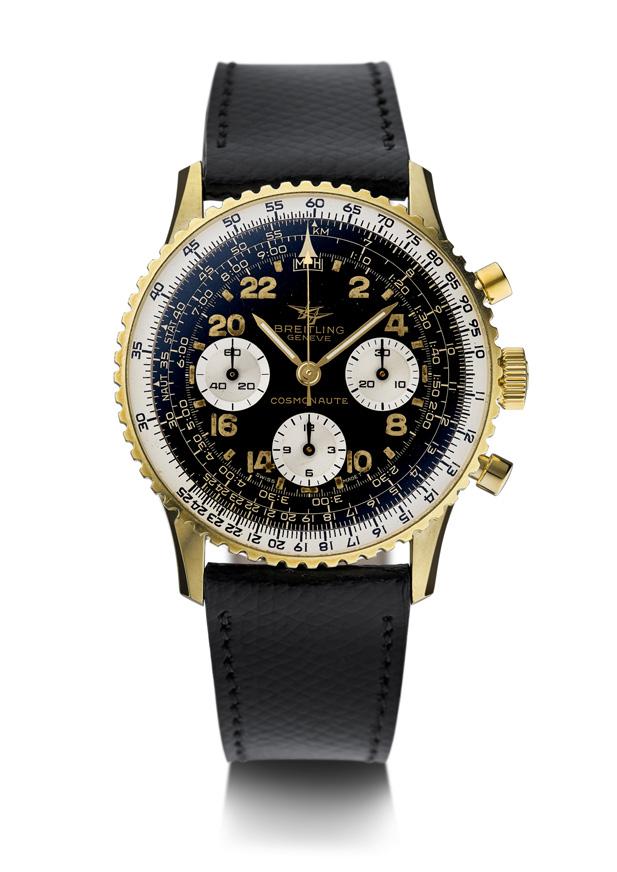

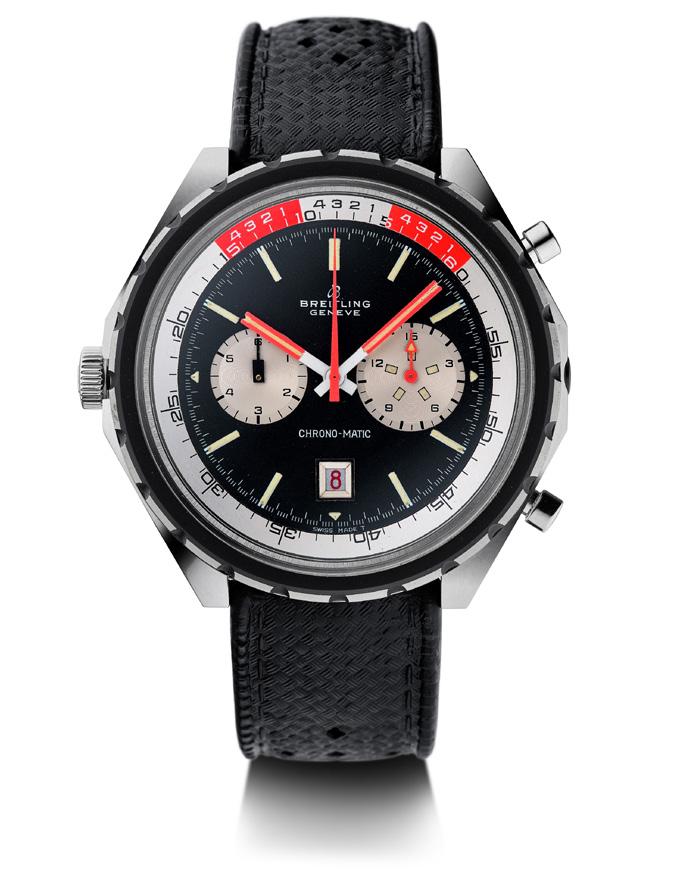

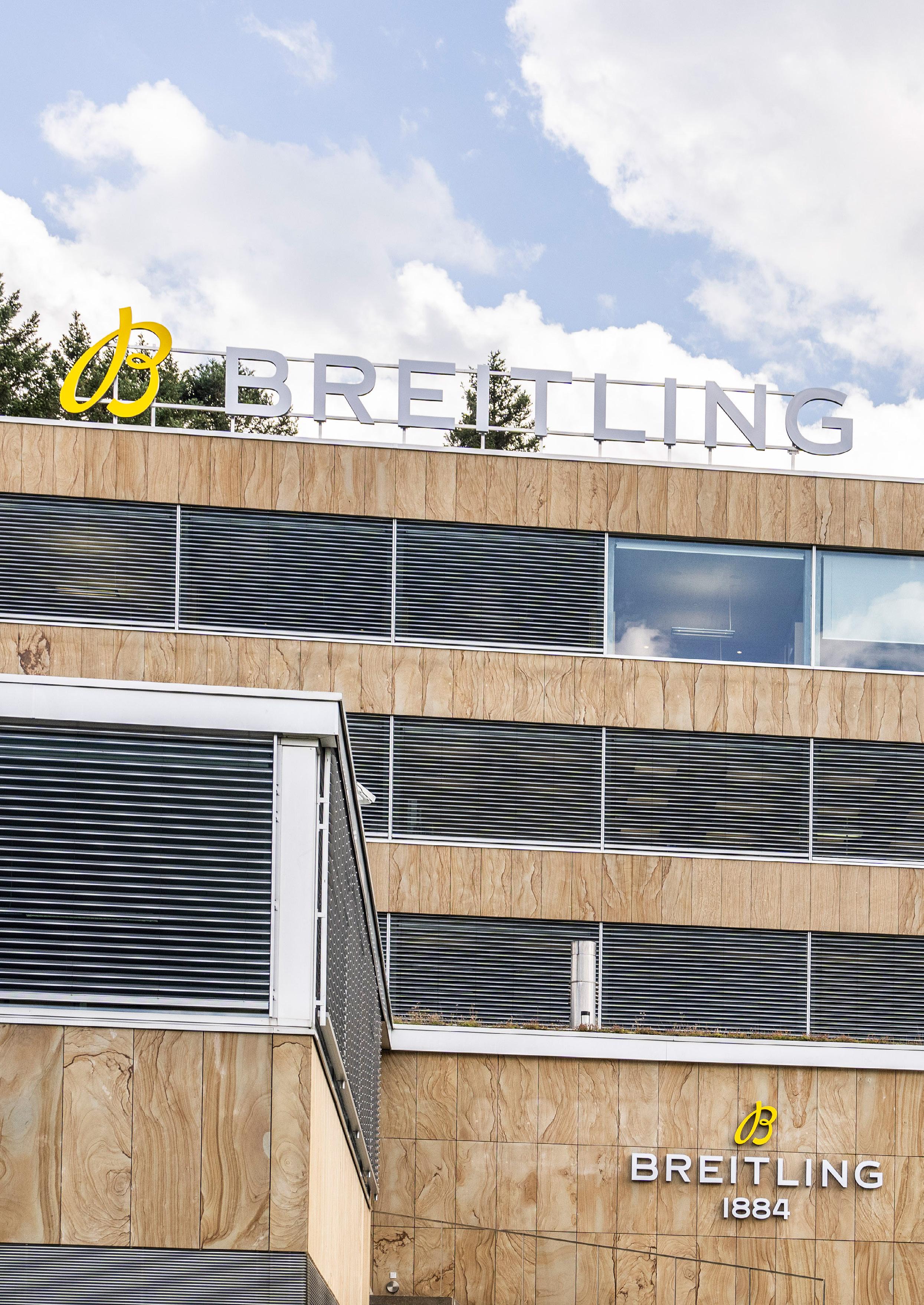


We conduct our business and engage with our stakeholders with the highest ethical standards and secure their privacy. We proactively manage sustainability at Breitling, directing our efforts at the highest management level. Our actions are guided by a full-scope suite of policies publicly available at Breitling.com.
Governance
Material topics addressed: • G1 Corporate culture
• G1 Management of relationships with suppliers including payment practices
• G1 Corruption and bribery
Zero incidences of corruption or anticompetitive behavior 0 0 (FY25)
Achieve EcoVadis platinum medal (top 1% globally) by end FY28 84/100 Platinum medal (top 1% globally) 64/100 Silver medal (top 10% globally) 50/100 Bronze Medal (Top 35% globally) (FY21)
Creating positive corporate culture Addressing ethical and legal issues Fostering positive corporate culture 16 NA We have a comprehensive anti-corruption program based on risk assessment, trainings and controls.
Address factors across all IROs indicated 8, 12 We have made substantial progress in the reporting cycle thanks to our fullscope efforts, with the strongest improvements made in the categories labor & human rights and sustainable procurement.

AUDIT & RISK COMMITTEE
INTERNAL AUDIT
BREITLING’S GOVERNANCE MODEL WITH FOCUS ON SUSTAINABILITY
SHAREHOLDERS AND GENERAL MEETINGS
BOARD OF DIRECTORS
CHIEF EXECUTIVE OFFICER
CHIEF ADMINISTRATIVE OFFICER
CHIEF SUSTAINABILITY OFFICER AND SUSTAINABILITY DEPARTMENT
ESG COMMITTEE
NOMINATION & COMPENSATION COMMITTEE
The detailed governance model can be found on page 13 of this report.

Breitling commits to the highest standards of ethical conduct and corporate governance in the conduct of our business and in all our interactions with our stakeholders. We frequently engage our employees in speaking up, providing feedback and sharing experiences with each other to support a positive corporate culture. We comply with all regulatory and contractual obligations and refrain from any acts of corruption or anticompetitive behavior. Our decisionmaking processes and strategic oversight of our business are fostered by our mature corporate governance bodies and processes.
Our majority shareholder, since May 4, 2023, is Partners Group (PG), a leading global private markets firm. PG is invested alongside our previous majority shareholder, CVC, a leading global private markets manager focused on private equity, secondaries, credit and infrastructure.
PG has a strong commitment to sustainability. Creating lasting positive impact is one of the core principles of PG’s charter and one that applies to all PG’s activities as a firm. It guides its investment activities, its corporate activities, and its daily interactions with all of its stakeholders.
At PG, oversight of sustainability lies with the most senior levels of its organization. Its Executive Chairman of its board of directors is responsible for the overall strategy and direction, at the portfolio and corporate level – setting regulatory-driven sustainability targets. Implementation is delegated to PG’s executive team, led by one of the investment platform’s co-heads and the CEO, with execution of the strategy being overseen by the team’s two co-heads of sustainability, ensuring investment, regulatory, and client perspectives are considered. To maintain high levels of risk management, value creation, and reporting standards across the platform, PG’s sustainability governance and control framework integrates sustainability into the investment process and its enterprise risk management framework and
assures independent monitoring of risks.
PG leverages its own double materiality assessment to drive its portfolio’s strategic sustainability focus areas, including but not limited to (i) climate change strategy, creating long-term value by both investing in the low carbon economy and guiding assets towards their path to net-zero emissions; (ii) human rights and labor practices, ensuring safe and ethical working conditions; (iii) talent attraction and retention, building companies which employees desire to work for; (iv) data and cybersecurity, ensuring assets have strong cyber defense and response strategies; and (v) sustainable governance, developing its assets with an entrepreneur’s mindset, advancing sustainability and focusing on positive impact for all stakeholders while ensuring regulatory compliance and risk management.
CVC is committed to maximizing returns through the creation of sustainable value for its stakeholders. CVC believes that by considering material sustainability topics within its own operations, as well as in its investment approach, it can make more informed decisions and build businesses that are stronger and more resilient. Ultimately, CVC believes this contributes to the long-term success of the business and the investments it makes. CVC has four strategic priorities with respect to sustainability: (i) investing responsibly for long-term growth (ii) attracting, developing and retaining talent, (iii) building climate resilience and (iv) ensuring robust governance and accountability.
With respect to investing responsibly for long-term growth, this involves considering material sustainability topics as part of CVC’s investment thesis and due diligence, and working with portfolio companies to enhance their sustainability programs and make improvements during the holding period. CVC uses its value creation framework to help ensure a consistent approach to engaging and partnering with portfolio companies and investments on sustainability topics. Recognizing each investment opportunity is unique, CVC has a structured approach to help

Alfred Gantner
Daniel Pindur
Valérie Bessolo Llopiz
Gordon Bowen
Luisa Deplazes de Andrade Delgado
Andreas Holzmüller
Omorinsola Oluwole
Yichen Shen
Can Toygar
companies determine, and then focus on, what is most material to them with the objectives of building better businesses and creating sustainable value for stakeholders.
Our company, headquartered in Switzerland, holds and controls directly or indirectly all the operational and manufacturing entities of the group. The group’s manufacturing as well as other group key operations, such as design and product development, commercial, marketing, digital & technology, finance, administrative office (sustainability, legal &, compliance, human resources, health, safety, and environment (HSE) and facilities) as well as after sales operations, are headquartered in Switzerland.
Our group’s parent operating entity, Breitling SA, is overseen by our board of directors, which approves Breitling’s global strategy and major business initiatives and investments. The board of directors is responsible for the overall direction, development, and supervision of the group and its management, and decides on the group’s key policies, control and audit matters, risk management and significant operational matters.
New directors are selected based on specific criteria and further to a thorough search to gather the relevant skills within the board of directors. The aim of this exercise is to ensure that the board of directors is continuously in a position to provide leadership, strategic oversight and guidance and contribute to setting ambitious targets for the group and meeting long-term value creation objectives. When selecting candidates to the board of directors, the company considers skills-based factors such as their professional experience, qualifications and areas of expertise. Additionally, age, gender, national background, global representation, as well as leadership style, are considered, so that at all times, the board of directors and its committees have the required competences and experiences.
The skills sought by the group for its board of directors include experience in strategy and business development, commercial, marketing and digital areas, finance and banking, experience in executive leadership and in the fashion and luxury goods industry, mergers and acquisitions, risk management, environmental matters, governance and compliance as well as social matters and corporate culture. The broad set of skills of the current members of our board of directors cover all material topics as reflected in the table above.

The board of directors considers the following criteria to determine the directors’ respective independence:
• The director has no conflict of interest which the board of directors determines as impacting their independence;
• The director has not served for more than 12 consecutive financial years as member of the board of directors;
• The director does not exercise nor has exercised an executive role or operational management tasks for the group within the last five years;
• The director is not a representative of a shareholder owning or controlling directly or indirectly more than 10% of the group;
• No family member of the director has been in the past three years or is currently employed by the group;
• Neither the director nor a family member has received either directly or indirectly any payments from the group (other than as a board remuneration);
• The director has not been employed by the group’s external auditor during the last three years;
• The director is not acting directly or indirectly as an advisor or consultant to the group;
• The director is affiliated with neither a significant customer or supplier of the group, nor with a non-profit entity receiving significant contributions from the group;
• The director has no significant business connection with the group.
As of March 31, 2025, the board of directors was made up of four shareholder representatives and four independent board members, all of whom are nonexecutive. Women made up 25% of the board of directors, and 62.5% of board members were between 30 and 50 years old, with 37.5% above 50 years of age. 50% of board members were independent. Employees are not directly represented in the board of directors or the executive management by a dedicated employee representative. On March 31, 2025, the board of directors was constituted of the following individuals with related functions:
Alfred Gantner, chairman of the board of directors since May 4, 2023 and board member since December 17, 2021, previously vice-chairman from December 17, 2021 until May 4, 2023 (master’s degree in business administration and management from the Brigham Young University Marriott School of Management, United States of America, Swiss, 56, male), is the co-founder of Partners Group, and an executive member of the board of directors of Partners Group Holding AG (as well as a member of the corporate development committee and of the investment oversight committee) with previous positions as executive chairman and CEO as well as chairman of the global investment committee of Partners Group (other current board membership at Esentia Energy Systems; former board memberships include VAT, USIC and PCI Pharma Services).
Dr. Daniel Pindur, vice-chairman of the board of directors since May 4, 2023, previously chairman from December 17, 2021 until May 4, 2023 and vicechairman from 2017 until December 17, 2021, and chairman of nomination and compensation committee (PhD in finance from the Ulm University, Germany, German, 47, male), is a managing partner and Co-Head of DACH and Israel at CVC Advisers (Germany) GmbH with previous positions at Goldman Sachs and at Sunrise Communications as CFO (other board memberships include Douglas, Sunday Natural, The Quality Group, DKV Mobility Services, and chairmanship at Tipico).
Valérie Bessolo Llopiz, Chairperson of the ESG Committee since June 27, 2024, board member since March 1, 2024 (master’s degree in international business administration, France, French, 53, female) is Chief Content Officer of ELLE & ELLE DECORATION International (overseeing the editorial strategy of 50 ELLE and 25 ELLE DECORATION editions worldwide, leading global content development and international brand marketing). She is a former fashion executive, who began her career at Chloé (under Karl Lagerfeld) and later founded the ESG department at Lagardère News.
Gordon Bowen, board member since May 4, 2023 (bachelor’s degree in English literature from the University of Utah, United States of America,

American/English, 74, male) is the founder of McGarryBowen, and global chairman / chief creative at dentsu. He previously held creative leadership positions at Y&R, McCann, and Ogilvy and was the creative director of the Salt Lake City Winter Olympics 2002 (other current board memberships at Saint Peter for Humanity, Utah Symphony, and Ballet West and Saint Peter for Humanity).
Andreas Holzmüller, board member since May 4, 2023, chairman of the audit & risk committee since June 21, 2023 , member of the ESG committee from June 21, 2023 until June 27, 2024 (master’s degree in accounting and finance from the University of St. Gallen [HSG], Switzerland, 42, male) is a managing director at Partners Group AG since 2008 (other current advisory board memberships at Schleich and Techem).
Omorinsola Yewande Oluwole, board member since March 1, 2024, member of the ESG Committee since June 27, 2024 (bachelor and master degrees in Human Biology and Sociology from Stanford University, Palo Alto, California, United States of America, and master degree in Public Health Business Management from Columbia University, New York, United States of America, American/Nigerian, 40, female) is the founder and CEO of Le Vitruve, a strategy consulting firm and former Director & Global Head of Luxury at Meta (other current board membership at Biologique Recherche, Rituals, and Mobkoi).
Can Toygar, board member since 2017 (master’s degree in business administration and management from Mannheim University, Germany, German, 42, male) is a partner at CVC Advisers (Germany) GmbH and was previously with J.P. Morgan (other current board memberships at Douglas, Sunday Natural, The Quality Group, Tipico and Syntegon).
Yichen Shen, board member since June 22, 2023, (master’s degree in business administration from the Harvard Business School, United States of America, Chinese, 36, male) is an executive director at Primavera Capital and was previously with KKR and Goldman Sachs.
Luisa Deplazes de Andrade Delgado, board member since April 27, 2022 until April 30, 2024, and chair of the ESG committee until April 30, 2024, (master’s degree in law, LLM and postgraduate diploma in European studies, Swiss/Portuguese, 58, female) is an entrepreneur and investor with extensive international executive and board experience as CEO of Safilo Group, executive board member and CHRO at SAP, and local CEO Nordic and CHRO Europe at Procter & Gamble, and previous Vice Chair of Barclays Bank (Switzerland) and board member at among others AO World and ARYZTA (other current board memberships include chair at Swarovski and Schleich, and board membership at Ingka Holding [IKEA], DIA Group, Telia, Fortum and Jose de Mello Group).
The board of directors has established the following three committees composed of members appointed by and among the members of the board of directors: the audit & risk committee, the ESG committee, and the nomination and compensation committee.
The audit & risk committee as at March 31, 2025 is chaired by Andreas Holzmüller. The audit & risk committee aims to support the board of directors in its duties in relation to financial reporting and internal controls. Such duties include consideration of the appropriateness of accounting policies, the adequacy of internal controls, risk management and regulatory compliance. It exercises oversight over the major risks identified by the board of directors (including cybersecurity). The audit & risk committee is responsible for the supervision and approves the framework governing the work of the internal and external auditors of the group, each of which provides regular reports to this committee on findings arising from their work. In addition, our internal audit function is independent of our administrative management structures, and enhances, protects and advises on the organizational value by providing risk-based and objective assurance, advice, and insight on, among other things, our core processes, governance, risk management, control, and IT security. The chairperson of the audit & risk committee reports regularly to the board of directors on the relevant findings, reporting and actions.


Sustainability
becomes truly impactful when it is second nature—deeply embedded in every layer of a company’s culture, operations, and governance. This shines through in a concerted collaboration that brings values to life. After a dedicated five-year journey, Breitling has reached this level of integration. As a luxury brand operating in a fastevolving landscape of trends and consumer expectations, we know the importance of staying ahead. In my role as an independent board member and Chair of the ESG Committee, I help guide our sustainability strategy, fostering alignment between the board and management while bringing outside-in perspectives to keep our vision both ambitious and future-ready. .
VALÉRIE BESSOLO LLOPIZ CHAIRPERSON OF THE ESG COMMITTEE
The ESG committee as at March 31, 2025 is chaired by Valérie Bessolo Llopiz. The ESG committee plays an important role in supporting the Group to develop its sustainability targets, plans, reporting and communications in order to act accordingly. The ESG committee oversees sustainability related issues that may affect the group and its customers, including reputational and non-financial risks and receives relevant reports from the executive management on impact, risks and opportunities concerning ESG matters. The chairperson of the ESG committee reports regularly to the board of directors on the relevant findings, reporting, and actions.
The nomination and compensation committee as at March 31, 2025 is chaired by Dr. Daniel Pindur. The nomination and compensation committee assists the board of directors in the succession planning, selection and nomination of candidates to positions to the board of directors, in particular ensuring that all required competencies for the strategic business oversight and risk management, including sustainability related material topics, are represented. The nomination and compensation committee assists the board of directors in the appointment and dismissal of the CEO and other members of the executive management and advises the board of directors on the contractual terms of the employment and remuneration of the CEO and of the other members of the executive management. This committee also determines the conditions of general employment conditions, pension schemes and any short-term and long-term compensation schemes offered by the entities of the group.
The board of directors and each aforementioned committee convene regularly scheduled meetings with additional meetings held as and when required. Board and committee members receive supporting documentation in advance of the meetings and are entitled to request further information from the executive management in order to assist them preparing for such meetings.
Our board of directors appoints our CEO and has delegated to the fullest extent possible the

management of the group to him, who fulfils all executive duties and functions and prepares and implements all the board of directors’ decisions with the support of the other members of the executive management.
As of March 31, 2025, the executive management consists of:
Georges Kern, chief executive officer since August 2017 (degree in business administration from the University of St. Gallen, Swiss, 60, male), previous positions within the Richemont Group as chief executive officer, IWC Schaffhausen, head of watchmaking, marketing & digital, and board member.
Nasr-Eddine Benaissa, chief commercial officer since September 2017 (master’s degree in business administration from HEC Paris, French, 56, male), previous positions, among others, at Eastgate Capital Group as managing partner, McKinsey & Co as partner, and Tag Heuer as regional sales director.
Daniel Braillard, chief operations officer since February 2021 (civil engineering designer, Swiss, 59, male), previous positions, among others, at Baume & Mercier as chief operations officer, and Richemont Group as leader of brands development.
Gaëlle Devins, chief customer officer since January 2025 (master of science degree in marketing and communication from the Golden Gate University, San Francisco, United States of America, Swiss, 45, female), previous positions as direct to consumer global director, AVP retail North America, marketing & communication director Hong Kong zone at IWC Schaffhausen, marketing director Northern Europe at Ralph Lauren, and global marketing role in FMCG and advertising at Young & Rubicam.
Dr. Lars Kaestle, chief financial officer since December 2019 (master’s degree in business administration and mechanical engineering from the Technical University of Braunschweig, Germany, and a Ph.D. in business administration and general management from the Technical University Of Munich, Germany, German, 52, male), previous positions at Premium Aerotec as chief
financial officer, and at EADS/Airbus with roles in operations, program management, procurement, investor relations, controlling, corporate finance and performance improvement.
Jancu Koenig, chief marketing officer since August 2024 (master’s degree in business administration from ESSEC Paris and an MSc and BSc in communications from Boston University, German, 52, male), previous positions, among others, at Apple as Senior Director and at Burberry as Senior Vice President.
Alexander Middelmann, chief of staff since August 2017 (MA in economics & management from the University of Oxford, an MSc in finance from Imperial College London and an MBA from Harvard Business School, German, 40, male), previous positions at Richemont Group as chief of staff, and Boston Consulting Group as project leader.
Dr. Dominik Rubli, chief administrative officer and general counsel since September 2018 (master’s degree in law from the University of St. Gallen, and PhD in IP law from University of Zurich, Swiss, 53, male), previous positions at Sunrise Communications as chief administrative officer and attorney-at-law.
Our double materiality assessment forms the basis for identifying and prioritizing material topics. Material topics form the basis for our sustainability strategy and targets, which are then ultimately defined by the CEO and executive management and reviewed by the ESG committee of the board of directors. Our sustainability performance against established targets is measured with key performance indicators that are reviewed together with the progress on key ESG topics at least quarterly by management and the ESG committee, which in turn reports to the board after each meeting – these happen on a quarterly basis or more often as needed.
The chairperson of the ESG committee has responsibility for ESG topics, including climate change, at the board level, whereas the chief administrative officer manages ESG topics on the executive

management level. The chief sustainability officer is a dedicated senior management position on the extended executive management team and responsible for formulating and implementing our sustainability road map and initiatives. The role is further supported in the department by a sustainability manager and a sustainability specialist, along with numerous horizontal collaboration partners across the organization.
Aurelia Figueroa, chief sustainability officer, prior head of sustainability since April 2020 (master´s degree in international affairs, international economic development from Texas A&M University, American, 41, female) previous positions, among others at the German Federal Ministry for Economic Affairs and Energy and Siemens as a Robert Bosch Foundation fellow, at the German Institute for Development and Sustainability (IDOS) as researcher, and at IWC Schaffhausen as senior corporate sustainability manager.
As part of our management efforts, we complete each year a range of relevant ratings. Since 2020, we have done this with EcoVadis. Within the reporting cycle, we are delighted to have been awarded a Platinum Medal, received by companies ranking within the top 1% globally. With a score of 84/100, up from 64 (silver medal) last year, this recognition reflects the significant progress we have made in key areas of environment, labour & human rights, ethics, and sustainable procurement. We have also achieved an upgrade in our S&P Global Comprehensive Sustainability Assessment rating from 31 to 41, similarly as a result of key improvements listed above. Further scores, prior reported, due to changes on the part of the issuing body in methodology and coverage, are no longer available to be shared publicly.
We are actively monitoring and implementing compliance with a comprehensive set of sustainability regulations that are shaping our global operations. Key areas of focus include supply chain due diligence obligations, particularly the Corporate Sustainability Reporting Directive (CSRD) in Europe and the Counterproposal to the Responsible Business Initiative (RBI) in Switzerland, which require enhanced
transparency and accountability. We are also aligning our efforts to traceability regulations, such as those concerning deforestation and new battery laws, to ensure the integrity of our supply chains. Additionally, we adhere to anti-waste and labelling laws, such as France’s AGEC, and constantly work towards compliance with regulations on permitted and harmful substances like REACH, PFAS legislations or California’s Proposition 65. Our commitment extends to complying with laws related to sanctions, including the daily screening of our points of sale using sanctions screening software, as well as adhering to greenwashing regulations to maintain truthful and accurate communications. Finally, we are vigilant in upholding employment laws, particularly those concerning equal pay and working conditions, to foster a fair and equitable workplace.
In order to ensure our approach to regulatory regulations application and implementation remains robust and up-to-date, we have a dedicated internal team monitoring application and implementation. In addition to this, on a limited, and targeted basis, we engage high-quality third-party consultation to assist in refining our approach. We also participate in selected training programs. Within the reporting cycle, we have participated in several initiatives of the United Nations Global Compact Network Switzerland & Liechtenstein (UNGCNSL) to support our efforts, in addition to service on the board, having been elected in June 2024. These include our participation in workshops and accelerators for nature and human rights, among other activities.
Breitling has zero tolerance for corruption. The Breitling Employee Code of Conduct, the SpeakUp policy and international SpeakUp platform, Breitling’s key Anti-corruption Policy and procedure (Q&A), are made available online at all times to all employees to prevent, detect, and address allegations or incidents of corruption and bribery. Each employee worldwide has been trained on anti-corruption through a global e-learning available in seven languages and provided with quick reference documentation.
Acknowledgement of the Anti-corruption Policy and Q&A, as well as completion of the training, are actively

tracked and monitored to ensure full participation and compliance. We periodically refresh communications through our internal platform, Workvivo, to keep employees informed and engaged.
Further proactive measures that Breitling takes in order to mitigate the risk of corruption include thirdparty due diligence and detailed processes for executing corporate deals and ensuring adherence to all sanctions lists. We also monitor the risk that our products are used by third parties for purposes of bribery and take appropriate actions. Any incident or allegations of corruption are rigorously and impartially investigated with the involvement of the Legal & Compliance team and are systematically reported to the the management and the ESG committee of our board of directors.
The Breitling Group is dedicated to maintaining an effective anti-corruption compliance management system contingent on the outcome of risk assessments. A targeted anti-corruption and fraud risk assessment was conducted and identified procurement and sales functions in specific countries
as higher risk due to their interactions with external stakeholders. Consequently, an action plan was developed to mitigate these risks and uphold the highest standards of integrity and compliance.
Effectively managing cybersecurity risks is also a top priority for Breitling. We maintain robust cybersecurity protocols through ISO 27001 certification and continuous improvement measures, including regular mandatory global training sessions. A dedicated internal team ensures cyber security is managed globally and locally within our subsidiaries, with frequent updates and ongoing education to strengthen defenses.
To enhance efficiency, and to automate and document our processes, we have implemented a centralized tool for managing the Group’s compliance incidents, including tracking of improvement measures, as well as for managing litigations and claims across the Group.
Monetary losses as a result of legal proceedings associated with fraud, insider trading, anti-trust, anti-competitive behavior, market manipulation, malpractice or violations of other related industry laws or regulations (CHF)
of corruption in the current reporting cycle, including those related to prior reporting cycles
of convictions / amount of fines (CHF) for violation of anti-corruption and anti-bribery laws

We would like to highlight the following litigation and data breach incident that occurred in this reporting cycle.
Breitling is responding to a lawsuit filed in the Superior Court of California concerning an alleged assault by a former employee on a union demonstrator during activities in San Francisco. The suit names both the former employee and Breitling USA, Inc., with allegations against Breitling USA, Inc. including negligence in hiring and supervision. Breitling considers this an isolated incident. Necessary measures have been taken internally as the actions of the individual in question are in breach of our Employee Code of Conduct and do not reflect our values. We maintain a rigorous hiring and conduct framework to uphold the highest ethical standards and foster a respectful workplace.
In December 2024, Breitling identified a data breach linked to a third-party action in October 2023 on a decommissioned e-commerce platform which led to exposed customer data. No financial data was compromised. Upon discovery, immediate measures were taken to secure systems, and relevant data protection supervisory authorities were notified within regulatory deadlines. Proactive follow-up actions were taken, complementing our ISO27001certified security framework, enhanced monitoring, and ongoing employee training. Affected individuals were notified promptly and provided guidance to mitigate risks. While we regret this incident, we reaffirm our commitment to safeguarding personal data through rigorous information security standards, continuous audits, and process improvements. Customer privacy remains central to our sustainability mission.
Our sustainability mission is supported by a robust framework of key policies designed to ensure ethical conduct and regulatory compliance across all aspects of our operations. Our overarching policy is the Environmental, Social and Governance (ESG) Policy, which is supported by numerous dedicated guidelines. These include our Employee and Supplier Codes of Conduct (establishing standards for ethical behavior and responsible business practices), the SpeakUp
Policy (providing a confidential integrity line for reporting unethical behavior and made available to all our stakeholders through our website), and the Anticorruption Policy (prohibiting bribery and corruption in all forms). Additionally, our Anti-competition Policy and Guidelines (ensuring fair competition practices), the Sanctions Policy (complying with international sanctions), the health, safety and environment (HSE) Policy (emphasizing our commitment to a secure and sustainable workplace), Indirect Procurement Policy, and Tax Policy further reinforce our commitment to ethical business. We do not enter any artificial arrangements and do not undertake aggressive tax planning. Our localizations are only driven by operational necessities. We also prioritize data privacy through our Data Protection Policies and Guidelines, which safeguard personal data and sensitive information. Most of these policies are publicly available at Breitling.com.
OUR SUSTAINABILITY MISSION IS SUPPORTED BY A ROBUST FRAMEWORK OF KEY POLICIES DESIGNED TO ENSURE
ETHICAL CONDUCT AND REGULATORY COMPLIANCE ACROSS ALL ASPECTS OF OUR OPERATIONS.

ESG Policy
Supplier Code of Conduct
Employee Code of Conduct
Global Tax Policy
Anti-Corruption Policy
SpeakUp Policy
Health, Safety, and Environment (HSE) Policy
DESCRIPTION
Framework for integrating environmental, social, and governance considerations into operations and decision-making processes
Ethical, social, and environmental standards expected from suppliers, ensuring responsible practices across the supply chain
Ethical and behavioral standards expected from all employees, promoting a respectful and compliant workplace culture aligned with our values
Framework for the approach to tax compliance, transparency, and responsible tax planning across global operations
Framework for preventing and addressing corruption, bribery and unethical conduct, ensuring compliance with applicable laws and fostering a culture of integrity
Framework to encourage employees and third parties to report concerns related to unethical conduct, misconduct, or violations of policies, ensuring confidentiality and protection against retaliation
Framework to ensuring zero harm to individuals and no damage to the environment is caused, emphasizing safe and healthy workplaces, safety-first culture, and HSE compliance
Indirect Procurement Policy Framework to establish standards and guidelines for the indirect procurement of products and services, ensuring transparent and cost-effective decision making and risk management
Anti-competition Policy
Framework to ensure compliance with competition laws in every country Breitling operates
Global Travel Policy Framework to streamline and enhance travel experience for all employees ensuring consistency, clarity, and efficiency for business travel planning, approval and reimbursement while prioritizing employee safety and well-being
General Data Protection Policy
Framework for protection of personal data in accordance with data protection regulations for all employees
Sanctions Policy Framework outlining Breitling’s commitment to complying with international sanctions by implementing risk-based measures, screening third parties and restricted business activities
Board of Directors ESG Policy
Board of Directors Code of Conduct
Board of Directors Employee Code of Conduct
Board of Directors Breilting Global Tax Policy
Board of Directors Anti-Corruption Policy
Chief Administrative Officer & Chief People Officer English SpeakUp Policy
Chief Administrative Officer NA – internal policy
Chief Financial Officer & Chief Administrative Officer NA – internal policy
Chief Administrative Officer NA – internal policy
Chief Administrative Officer NA – internal policy
Chief Administrative Officer NA – internal policy
Chief Administrative Officer NA – internal policy




The following tables provide guidance as to where to find information related to all ESRS disclosures requirements of material topics. Disclosure requirements without page indication are currently not included in the report.
BP-1 General basis for preparation of sustainability statements 2
BP-2 Disclosures in relation to specific circumstances 2
GOV-1 The role of the administrative, management and supervisory bodies
GOV-2 Information provided to and sustainability matters addressed by the undertaking’s administrative, management and supervisory bodies
GOV-3 Integration of sustainability-related performance in incentive schemes -
GOV-4 Statement on due diligence 49, 126
GOV-5 Risk management and internal controls over sustainability reporting 2023 Sustainability Mission Report, page 59
SBM-1 Strategy, business model and value chain 10-23
Detailed information on our value chains may be located in the community and nature chapters
SBM-2 Interests and views of stakeholders 24-33 Further details are available in our 2024 Sustainability Mission Report pages 35-41
SBM-3 Material impacts, risks and opportunities and their interaction with strategy and business model 26-39, 46-47, 94-95, 118
IRO-1 Description of the processes to identify and assess material impacts, risks and opportunities
IRO-2 Disclosure requirements in ESRS covered by the undertaking’s sustainability statement 26-33
MDR-P Policies adopted to manage material sustainability matters
MDR-A Actions and resources in relation to material sustainability matters 34-39
MDR-M Metrics in relation to material sustainability matters
MDR-T Tracking effectiveness of policies and actions through targets 34-39
More information can be found in the 2024 Sustainability Mission Report pages 35-47

ESRS 2, GOV-3 Integration of sustainability-related performance in incentive schemes -
E1-1 Transition plan for climate change mitigation
ESRS 2, SBM-3 Material impacts, risks and opportunities and their interaction with strategy and business model
ESRS 2, IRO-1
Description of the processes to identify and assess material climate-related impacts, risks and opportunities
E1-2 Policies related to climate change mitigation and adaptation
E1-3 Actions and resources in relation to climate change policies
E1-4 Targets related to climate change mitigation and adaptation
E1-5
E1-6
E1-7
E1-8
E1-9 Anticipated financial effects from material physical and transition risks and potential climate-related opportunities
Please
2024 Sustainability Mission Report, pages 77-83 for further details
information can be found in the 2024 Sustainability Mission Report pages 77-81
ESRS E2 POLLUTION (MANDATORY DISCLOSURE REQUIREMENTS IRRESPECTIVE OF MATERIALITY)
ESRS 2, IRO-1
Description of the processes to identify and assess material pollution-related impacts, risks and opportunities

ESRS 2, IRO-1 Description of the processes to identify and assess material water and marine resources-related impacts, risks and opportunities
E3-1
E3-2
E3-3
E3-5
financial effects from water and marine resources-related impacts, risks and opportunities
E4-1 Transition plan and consideration of biodiversity and ecosystems in strategy and business model
ESRS 2, SBM-3
ESRS 2, IRO-1
97, 98-99
E4-3
E4-4
E4-5 Impact metrics related to biodiversity and ecosystems change 94-95, 108
E4-6 Anticipated financial effects from biodiversity and ecosystem-related risks and opportunities
ESRS 2, IRO-1 Description of the processes to identify and assess material resource use and circular economy-related impacts, risks and opportunities
E5-1 Policies related to resource use and circular economy 128-129
E5-2 Actions and resources related to resource use and circular economy 110-115
E5-3 Targets related to resource use and circular economy 34-35, 94-95
information can be found in the 2024 Sustainability Mission Report pages 35-47

E5-4
E5-6 Anticipated financial effects from resource use and circular economy-related impacts, risks and opportunities
ESRS 2, SBM-2 Interests and views of stakeholders
ESRS 2, SBM-3 Material impacts, risks and opportunities and their interaction with strategy and business model
S1-1
S1-2
S1-3 Processes to remediate negative impacts and channels for own workers to raise concerns
S1-4 Taking action on material impacts on own workforce, and approaches to mitigating material risks and pursuing material opportunities related to own workforce, and effectiveness of those actions
S1-5 Targets related to managing material negative impacts, advancing positive impacts, and managing material risks and opportunities
S1-6
S1-7
S1-12
S1-13
S1-14
S1-16

ESRS 2, SBM-2 Interests and views of stakeholders
ESRS 2, SBM-3 Material impacts, risks and opportunities and their interaction with strategy and business model
S2-1
S2-2
S2-3
S2-4 Taking action on material impacts on value chain workers, and approaches to managing material risks and pursuing material opportunities related to value chain workers, and effectiveness of those action
S2-5 Targets related to managing material negative impacts, advancing positive impacts, and managing material risks and opportunities
ESRS 2, SBM-2
ESRS 2, SBM-3
impacts, risks and opportunities and their interaction with strategy and business model
S3-2 Processes for engaging with affected communities about impacts
46-47
46-47
S3-3 Processes to remediate negative impacts and channels for affected communities to raise concerns 48-51, 56-64
S3-4 Taking action on material impacts on affected communities, and approaches to managing material risks and pursuing material opportunities related to affected communities, and effectiveness of those actions
62-64
S3-5 Targets related to managing material negative impacts, advancing positive impacts, and managing material risks and opportunities - Targets are in development in consultation with affected communities and following the guidance of ESRS 2 MDR-T

ESRS S4 CONSUMERS AND END-USERS
ESRS 2, SBM-2 Interests and views of stakeholders
ESRS 2, SBM-3 Material impacts, risks and opportunities and their interaction with strategy and business model
S4-1 Policies related to consumers and end-users
S4-2 Processes for engaging with consumers and end-users about impacts
S4-3 Processes to remediate negative impacts and channels for consumers and end-users to raise concerns
S4-4 Taking action on material impacts on consumers and endusers, and approaches to managing material risks and pursuing material opportunities related to consumers and end-users, and effectiveness of those actions
S4-5 Targets related to managing material negative impacts, advancing positive impacts, and managing material risks and opportunities
86-89
More information can be found in the 2024 Sustainability Mission Report pages 35-47
ESRS 2, GOV 1 The role of the administrative, supervisory and management bodies
ESRS 2, IRO-1 Description of the processes to identify and assess material impacts, risks and opportunities
Corporate culture and business conduct policies and corporate culture
G1-2 Management of relationships with suppliers
G1-3
G1-4
G1-5
G1-6
and

Mission Control 23 Figures related to operating costs, payments to providers of capital, payments to government, and financial assistance received from the government are not disclosed due to confidentiality reasons.
Mission Control 23 Consists of prototype costs, direct R & D and product development expenses, staff costs, and depreciation.
Mission Control 23
Nature 19, 100 This is a disclosure provided in addition to the WEF IBC Stakeholder Capitalism Metrics
Nature 112 This is a disclosure provided in addition to the WEF IBC Stakeholder Capitalism Metrics
Employment and wealth generation: economic contribution GRI 201-1, GRI 201-4
Total R & D expenses US GAAP ASC 730
Community and social vitality CECP Valuation Guidance
Shadow carbon price (CHF/tCO2E)
Recommendations of the TCFD; CDSB
R01, R02, R03, R04, and R06; SASB 110; SBTi
Consumption of key materials GRI 301-1
Note: Any reference made to GRI concerns the GRI standards of 2016 unless otherwise specified. This index and its content have been reviewed for accuracy and reflect that which will be published in the Breitling Sustainability Mission Report to be released in September 2024.

